













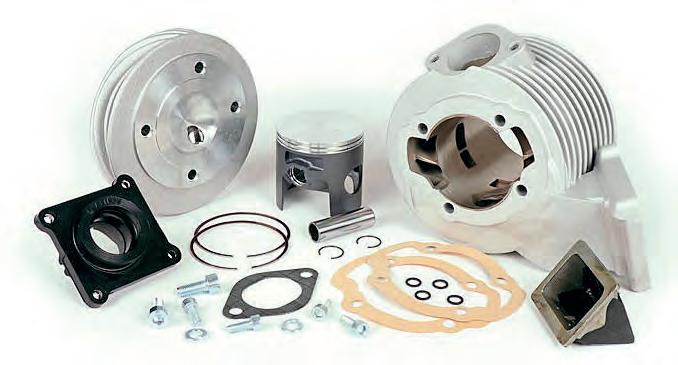






Everybody reminisces about their past and when it comes to scooterists perhaps we are the worst culprits of all. Not that there is anything wrong with that and I myself regularly indulge in doing so by way of the many enthusiastic social media groups dedicated to it. Every now and then I’ll blow the dust off an old shoebox full of grainy old images that’s kept in the loft and reminisce over my misspent youth. A quick fix it may be but going back in time is something we can’t do, we can only go forward. Which leads on to the real matter of this piece, what about the future?
We’ve all discussed it many times and it’s not long before someone asks the biggest question of all: “How long do you reckon the scene’s got left in it?” I’m sure that when the Innocenti factory closed owners worried about how long they could keep their machines roadworthy, just as manufacturers worried about their survival when inexpensive cars began to steal their sales.
When Lambretta stopped production it was seen as the death knell of scootering. Although Vespa filled the gap, few machines were being sold as a general mode of transport. The underground scene of the 1970s preserved scootering as a cult but, let’s face it, scootering as we know it came out of the 1980s Mod revival and the rally culture that it spawned.

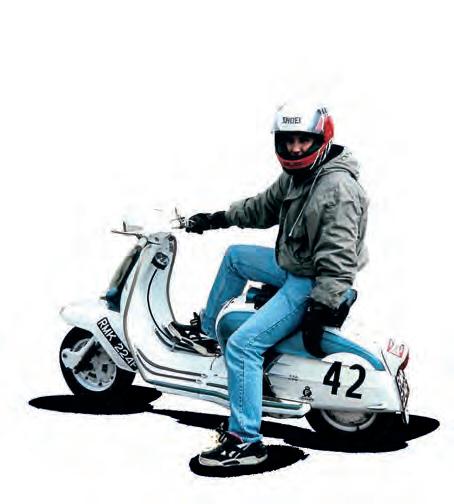
Those 1980s teenagers are now approaching retirement age and many have, perhaps, moved on to other interests. This is where the real worry about the future lies, the ageing population of those within it. Thankfully there is a growing number of slightly younger riders who bolster the scene admirably, attending rallies and events and, in my opinion, securing the immediate side of scooter riding.
The future is in our hands
Those of us who are slightly senior still play an active role, maybe not riding quite so much, but turning their passions to other parts of scootering such as collecting and restoring.
It’s been a gradual shift from what was to what is now. For example, in the 1980s combats and grass skirts looked good on most of us but that’s not the case any longer. The scooters we ride may also be old enough to have experienced those halcyon days, but their level of tuning, reliability and paint are totally removed from back then. It’s a bit difficult to explain, but what I’m trying to say is that the scene and the people within it have a knack of being able to adapt to the challenges put in front of them.
Cast your mind back to the legshield protector scandal of the 1990s, the banning of leaded fuel, factory production of two-stroke engines stopping, and so on. The list is endless of the threats both past and present that were going to kill scooters off. It still exists with Greta and her mob wanting us to all go back to the days of horse and cart but no matter how much they try, the scene will survive
The scooter scene has been around for longer than many of us care to remember.
because we are all determined to keep it going.
The truth is the biggest threat to the scene’s survival is that we try to recreate the past. At the beginning of this article, I mentioned looking back at old pictures wishing it was like that again but it never will be. Just as today’s Vespa is far removed from what it once was, rallies are not going to be the mass invasions of seaside towns. Few of us would even consider camping on disused council wasteland and no one in their right mind would hacksaw the back end off an SX200 and paint it matt black.
Instead of constantly looking backwards, take things for what they are now. We currently enjoy a vibrant scene that is made up from a huge variety of different influences. With the possible exceptions of the VW and Mini scenes, scootering is far more diverse than any other vehiclecentred culture. There may be things some of us don’t like, but don’t try to deter or discard them as they are critical to the scene’s survival.
While there may be veiled threats from outside the scootering circle, those of us inside it should grasp what we have with both hands. Only by accepting that things have changed and will continue to change can we make sure the scene stays strong for future generations.
Reminiscing about the scooter scene is all well and good, but what about its future and what can we do to secure it?
The truth is the biggest threat to the scene’s survival is that we try to recreate the past.
WWW.scootering.COM |
Two Up By Scooter to Australia

In 1956 Michael Marriott and his wife, Nita, emigrated to Australia. Their chosen mode of transport was an NSU Prima.

It’s fair to say that having already crossed the Sahara in an old London Taxi, the Marriotts were no strangers to adventure. Yet even their friends and family were concerned at their choice of a motor scooter for such a long and hazardous journey. This book, first published in 1960, sets out their experiences on that journey in a way that’s both engaging and evocative of a time gone by.

As a narrator, Michael isn’t afraid to laugh at his own mistakes and I suspect he’d have made an excellent travelling companion. Although in the book she’s cast as his long-suffering wife, it’s clear that Nita was a force to be reckoned with. Whether making mayonnaise from scratch in a hotel room, or cooking a full roast dinner in an old biscuit tin over a camping stove, she is, in many ways, the unsung hero of the adventure. When she finally lost her cool even the ever-frugal Michael knew it was time to spend some of their meagre funds on a spot of luxury.
Written as the sun had all but set on the British Empire, the Marriotts travelled through a world that’s now gone forever. The very idea of travelling across Iran, Pakistan and Afghanistan on a British-registered scooter laden down with camping gear and carrying a hunting rifle now seems ludicrous, yet that’s exactly what they did I can also guarantee that it will be a long time before any itinerant scooterist will follow in their tyre tracks and knock on the door of the British Embassy in Kabul to ask the ambassador if they can camp on his lawn.
Although it’s an extraordinary tale, there are plenty of episodes that every scooterist can identify with and it should come as no surprise that breakdowns are a common occurrence. One notable rescue occurs in the Khyber Pass when the intrepid duo hitch a ride in an oil tanker, strapping the broken NSU to the truck’s roof!
For NSU fans there’s also a wonderful description of the Neckarsulm factory, where the Marriotts were welcomed with open arms and treated to German hospitality at its finest.
Although written six decades ago, and being out of print for most of that time, it’s surprisingly easy to find a copy on line. Although the language may be a little stilted by today’s standards this is still a very enjoyable book and one that’s certain to feed the desire to travel.
Stan Images: Stan, Mortons Archive
Title: Two Up
Author:
Marriott
 Michael and Nita Marriott, adventurers extraordinaire. BUYER’S GUIDE
Michael and Nita Marriott, adventurers extraordinaire. BUYER’S GUIDE
Michael
Best enjoyed with: A nice cup of tea, a slice of cake and a stiff upper lip Pages: 214 First published: 1960 ISBN: N/A RRP: Currently out of print, expect to pay around £25 WWW.SCOOTERING.COM |
Quadropheniac
I recently came across a late night re-showing of the Quadrophenia film, which I haven’t watched for quite a few years. Watching it again took me back to being a 16-year-old wannabe Mod...
Sometimes I’m transported back to a very specific place by music and film. Watching the opening sequence I was in Nottingham (having gone on the train) wearing an Oxfam jacket and some two-tone trousers.
We went to watch Quadrophenia on a Sunday afternoon and I spent ages outside looking at the scooters, wishing I was one of the cool kids actually old enough to ride one! I remember looking at a metallic brown Lambretta with chrome side panels. I’d never seen such a cool-looking thing in the flesh before and I wanted one. My future was set that afternoon.
Looking back on Quadrophenia, I have to say it was bloody awesome. Often films about subcultures can be pretty awful, in fact generally they are! Very few films can pull off a feeling of authenticity. The only other one that comes close is the Lords of Dogtown film about the Z-Boys skateboarding scene.
So what makes Quadrophenia so good? There was certainly a high quality cast. The only weak link was Sting who didn’t really cut it for me. The rest of the cast have mostly gone on to enjoy long acting careers, showing how well the casting team did. Of course the music was brilliant and the original Quadrophenia album remains one of my favourite albums ever. The Rock, Love Reign O’er Me, I’m On, 5:15... just brilliant tracks.
One of the reasons the film has survived the test of time is that the storyline is actually quite deep. Jimmy is clearly struggling with many aspects of life looking for excitement. Wanting to ‘be someone’. His story of misplaced friendships and wanting to be with Steph leads him to highs and lows. Finding himself in court with the Ace Face gives him someone to look up to, after being spurned by Steph. But he is to find that
the Ace Face was just a bell boy in reality. Jimmy is like many young men, an angry and somewhat mixed-up young adult trying to find an identity and purpose. In a funny way the story mirrors aspects of modern social media in that the celebrities people idolise and aspire to be are very different in real life.
This week I watched a few YouTube videos about the film and learnt a few things I didn’t know, such as the first time Sting pulls up on the GS there’s a walking stick on the rear rack. Sting was crap at riding scooters and had sprained his ankle trying to learn. Apparently he’d been hobbling around with the stick and the production team forgot to remove it from where it had been temporarily put! It’s also quite amusing trying to spot the errors here and there and of course recognise friends who are still in the scooter scene. A few YouTube searches will also reveal an incredible number of replica ‘Jimmy’ scooters!

The portrayal of most of the historic scenes was actually generally pretty good despite the odd GP Lambretta appearing. Of course it has spawned a whole Mod scene and industry which, overall, is far less authentic in relation to the true Mod culture. I have always thought there is a unique irony in promoting individuality by dressing and acting like everyone else in their scene. I just don’t get it.
The book of the film was written by Alan Fletcher, who lives close to me, and some of the stories included in the film were based on his 1960s scootering life around Nottingham, Grantham and Skegness.

Perhaps the scene I most relate to is the opening titles with Jimmy weaving down the road around Shepherds Bush to the soundtrack of The Real Me. He’s lost in the simple pleasure of riding a scooter dressed smartly and looking cool. We can all identify with that feeling.
Does Quadrophenia stand the test of time? I think it actually does. The music and fashions are timeless, but so is the underlying story of teenage angst, first love and finding an identity.
I’ll definitely watch it (yet) again in the future.
The music and fashions are timeless, but so is the underlying story of teenage angst, first love and finding an identity.
WWW.scootering.COM |
Enforcing an exclusion zone
In the late 1970s and early 1980s the route into scooter ownership and everything that went with it was by way of being a Mod. However long the flirtation lasted, immersing yourself in Mod music, fashion and scooters was an apprenticeship most of our club members went through. The music usually came first, closely followed by clothes and eventually a scooter. The Mod ethic was to dress smartly and be clean-cut, but at the same time individual and different from those around you. The rivalry was intense but welcomed, with outfits changing almost on a weekly basis as we fought to stay one step ahead.
Mike was a local lad, someone from the same year as us in school but a late arrival to the Mod style. He was good company and of course welcomed with open arms. It was only when he attempted to get up to speed with fashion that the danger signals appeared. At this time there were two approaches to the Mod style; these were the 1960s route which followed the original trends or the 1979 revival look that had been heavily influenced by bands such as The Jam.
Both were accepted formats, but Mike couldn’t grasp the concept and found himself stuck somewhere in between with very odd results.
Rather than spend the leftover money from the £28 a week he got on the YTS, he decided to raid his dad’s wardrobe. This would have been fair enough if his dad had been one of the local faces in the 1960s but he hadn’t, far from it. Mike’s first appearance was down the pub on club night and there were more than a few gasps as well as some spilt beer as Mike
walked through the door. Wearing a green shirt with huge collars, a brown tie with the slim end showing while the kipper end was tucked away and beige semi flares, it was certainly different. Finishing off the look was a pair of shiny patent leather slip-on shoes. The vision he’d created was drawn from one of those clothing catalogues your grandad used to get sent through the post. It was as far away from the Mod look as it was possible to get.
His arrival hadn’t gone unnoticed by the rest of those drinking in the pub, most of whom were wondering if there was a fancy-dress party going on. He was shuffled on to a chair in the middle of our table to hide his clothes, with everyone offering to get him a drink to save him going up to the bar and getting stared at. A few of the club did start interrogating him about the fashion disaster and the disgrace he’d brought upon its members. It may have seemed harsh, but there were standards to keep. Fearing a lifetime ban Mike made an announcement: “My dad said I can have his old scooter that hasn’t been on the road for years.” This would make him one of the few in our club to actually own a scooter and the announcement carried enough kudos to grant him a stay of execution.
We always met at Dave’s on a Saturday, as he had the biggest garage and a driveway large enough to park several scooters on. Everyone had gathered early, eagerly waiting in anticipation of Mike, who was due to appear on his dad’s old scooter. Discussion ranged from whether it could be a Vespa GS to a Lambretta SX200 or, more likely, something tamer such as an Li150. Whatever it was,
another scooter ‘on the books’ could only enhance the club’s reputation. All of a sudden, a vision appeared in the distance. “Could this be him?” someone cried, but the quick response was: “Nah, it’s not a scooter.” However, as it came closer, our worst fears were confirmed. It was Mike all right and he was riding an old red and white Honda C90. More commonly known as a ‘chicken chaser’ and responsible for mobilising the third world, we now had one in our club.
Everyone stood in complete silence, still in shock at what they were witnessing. Mike came to a halt, took off his dad’s old piss pot helmet and calmly asked: “What do you think?” No one said anything for a minute or so as we tried to come to terms with our world ending. The machine itself was rather tired looking, displaying a rusty brown silencer and moss on its south side, having spent years underneath an old tarpaulin. It was suggested that’s where it should go back to and never to darken Dave’s drive again. The usual ride to the local scooter shop was abruptly cancelled as there was no way of looking cool with that thing in tow. Dave, who was the nearest we had to a leader, declared it unfit for purpose and banned it immediately. A deflated Mike vowed to make changes and to us that translated into it being traded in for a real scooter. We were wrong. The following week he returned, this time with a front rack fitted that he’d decked out with mirrors and lights. Another rack of uncertain provenance had also been cobbled on to the back. The look was ‘enhanced’ by tassels on the handlebar ends but the cherry on the top was a huge CB aerial with a fox fur on the end.
There was no disguising the fact it looked worse than ever, and drastic action needed to be taken. We decided that from now on he had to follow at least 100 yards behind and park up in another street.
Probably the first and only time a member of the scooter club had to adhere to such stringent rules in keeping his mode of transport away from everyone else, that of an exclusion zone.
It was Mike all right and he was riding an old red and white Honda C90. More commonly known as a ‘chicken chaser’ and responsible for mobilising the third world, we now had one in our club.
The general consensus was that from now on a club member must own either a Vespa or Lambretta; anything else would be subject to intense scrutiny.
WWW.scootering.COM |




LUCKY 13
The scooter featured is to be found in the personal collection of Derek Askill of ‘Disco Dez’ Scooters fame. Famous for building retro-styled Modernist and street racers, for some time his passion has been for early model scooters. This is particularly true for those still to be found in original condition, without restoration or modifications other than period additions and accessories.
Fitting beautifully into this theme is his pale blue 152L2, a two-owner (and one collector that never did a thing with it) scooter.
Benefiting from a sympathetic mechanical overhaul and gentle clean, the scooter now boasts a number of period additions and proudly displays both a 1960 rally and Birmingham club banner even though it originally hailed from Lincolnshire.
It might not be to everybody’s taste but it’s a rare and unmolested survivor from an era where transportation was more about arriving in style rather than getting there quickly

That was then: Vespa 152L2

Vespa’s 1959 model 125 was a much slimmed-down machine that kept to the family design with seemingly very few modifications. A closer inspection though would reveal some radical changes that would be carried over right through to the demise of geared Vespa production.

New design
Launched in 1959, Douglas’ 152L2 was essentially a rebranded Continental VNA model for the British (and Commonwealth) market. Thanks to new manufacturing processes this was a leaner, lighter machine that was also much easier to manufacture than its predecessors. The old ‘wide body’ styling and engine cases had been banished. The frame design was simplified and ‘wind honed’, which presumably translates into 21st century English as being streamlined A new two-piece engine casing did away with the old separate engine mount and cradle arrangement, forming a layout that would, visually at least, be familiar to owners of late model PXs. However this was the base model of the new style of Vespa and as such even a steering lock was an accessory item; it did however boast a seat-mounted luggage clip and fuel tap.
Suspension
Front suspension and brakes were very similar to those fitted on the outgoing 192L2 model and retained the eight-inch wheel configuration. These were covered by a new one-piece, pressed steel mudguard that was very similar in style to that fitted on the GS150. The other end of the forks had an entirely new headset design with a fork clamp and cable stops These were covered by a two-piece pressed steel headset which incorporated integrated wiring, switchbox and headlight This was a big leap forward in both appearance and aided maintenance access but for some reason was dropped after this model ceased production. The split headset design was not reintroduced until the New Line (P Range) was launched in 1977. The wheelbase was revised slightly in the new frame and on Douglas models a rebadged Denfeld dual seat came as standard, allowing rider and pillion more room and comfort.
Engine
The 152L2’s engine benefited from a complete redesign with a much simplified two-piece casting, three gears and simplified gearchange mechanism. Douglas utilised the services of a number of British manufacturers and an Amal carburettor was
to be found on top of the engine’s cylinder rather than a Dell’Orto unit. The space previously occupied by the carburettor now became a large airbox that fed the carburettor via a flexible air hose. The choke was a small spring-loaded flap mounted inside the air filter box and opened by cable pull, with the lever being part of the seat frame This was supposed to be operated without lifting the seat but as motors became worn it was often found necessary to lift the seat in order to gain a little more lift on the cable. A few Italian-produced machines crept into the country when Douglas production couldn’t match demand These scooters had the definitive Vespa engine layout with the carb relocated to the engine block position most people will be familiar with today (Models 232L2 in the UK and VNB on the continent)

Performance
Out on the road the scooter’s slightly smaller dimensions would be appreciated by those used to the earlier, wider machines The eight-inch wheels enabled nimble manoeuvrability suited to town riding. However the brakes could be locked quite easily and the 152L2’s suspension would bottom out under heavy braking, even with the auxiliary damper fitted Speed-wise the 125 engine was never going to break any records but was impressive when compared to traffic speeds of the time. Acceleration was surprisingly brisk but the machine’s weakness would be its top speed on open roads, even more so by modern standards.
Summary
Overall though the 152L2 was a pretty, well-proportioned machine that was best suited to urban commuting, which is exactly what the maker intended It ushered in the ‘modern’ Vespa’s shape and engine layout but compared to the Sportique/VBA/VBB models that followed, it has become a rare and dare I say it, overlooked machine. With a few tweaks to its suspension and brakes together with a little more power (and a brake light for safety!) the 152L2 can still be an eminently usable scooter.
It may lack the glamour of other models but as Richie Lunt explains, the 152L2 set the template for all geared Vespas that followed.
This all looks very familiar.
Vespa 152L2

That was then...
Design changes, livelier performance and lower running costs as well as a more attractive appearance distinguish the latest one-two-five Vespa, the 152L2 from its forerunners. Considered singly, the changes are relatively minor, but together they result in a model which has seen a vast improvement on the first Douglasproduced version seen in Great Britain in 1949. A saving in weight has been achieved by the use of new methods of construction and lighter-gauge material for the pressed
It was David Dixon, then a young staff writer at The Motorcycle, who gave the British public its first impressions of the 152L2 His review was published on September 24, 1959.

steel frame and body panels, but there is no loss in strength; the complex machine is some 5lb lighter than before. By detail redesigning; the engine has been moved fractionally nearer the longitudinal axis of the machine which results in reduced width of the body panels and, of course, in less weight bias on the right-hand side. The most obvious engine modification is the mounting of the Dell’Orto carburettor directly on the cylinder to give a down-draught flow to the mixture; performance is thereby improved and the fuel consumption reduced.
For tallish enthusiasts the riding position is slightly cramped, chiefly because the saddle is too near the handlebar (in other more expensive models in the range, this point does not arise since they are fitted with dual-seats which allow the rider to sit further back if necessary). The hand controls are laid out in orthodox scooter fashion; clutch lever and twist grip gearchange on the left side of the pressed-steel bar and front brake lever and throttle on the right. A combined lighting and dipper unit and horn and cut-out buttons are incorporated in a neat box beside the twist grip in easy reach of the right thumb.
Acceleration was surprisingly brisk but the machine’s weakness would be its top speed on open roads, even more so by modern standards.
All cable and lighting leads pass inside the handlebar pressing, resulting in a pleasingly clean appearance. The headlamp shell forms part of the handlebar pressing and incorporated in the top of the pressing is a 60mph Veglia speedometer. The dial is not illuminated but the indicator hand and the 30mph figures are coated with luminous paint. The rear brake pedal is on the righthand side of the floor.
Another feature of the new model is redesigned kick-starter mechanism; a quadrant engages with the gearbox layshaft instead of operating on the mainshaft. This results in a lower ratio, allowing use of a shorter pedal. The maker’s claim of easier starting was borne out in practice. With the petroil turned on (the tap is on the front of the bodywork below the saddle nose) and the air lever beneath the saddle raised, the engine invariably responded to the second dab on the starter. The throttle setting for starting from cold was not critical; the usual position was about one-third open. Once the engine had fired, the air lever could be ignored; the engine immediately settled down to a slow, reliable tickover.
On the Vespa – and many other continental designed units – the clutch runs at engine speed and, in consequence, engagement of bottom gear when the machine is running, and gear changes on the move, are almost invariably noisy. The Vespa clutch was guilty of these short-comings but in other respects earned full marks. In normal circumstances the well-chosen second gear was engaged at 18mph and top at 28mph. When in a hurry, 23mph and 36mph could be reached in bottom and second gears without over-revving the engine. Movement of the twistgrip gearchange was somewhat heavy. Although a positive stop is not fitted, there was no difficulty in selecting the gears.
During the period I had the Vespa, over 800 miles were covered on all types of road Naturally a large slice of this mileage was in town where the Vespa really proved
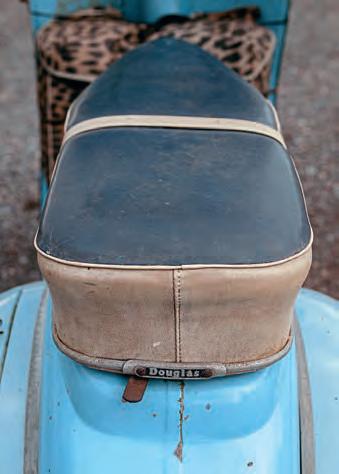

its mettle The lively performance was more than a match for the average traffic stream. A stop-watch reading of 29s for the standing start quarter-mile gives a fair indication of the acceleration. Indeed this figure would be quite creditable for a larger capacity engine but the performance would be wasted if one were unable to use it owing to a noisy exhaust In this respect it would be hard to better the Vespa; the exhaust note was exceptionally quiet at all speeds and throttle openings Indeed, above 15mph it was impossible for the rider to hear the exhaust and the only noise audible was a whine from the primary gears.
On the open road the Vespa would cruise for mile after mile with the throttle against the stop and 45mph indicated on the speedometer; moreover, the cruising performance was hardly affected by the added weight of a passenger. Under favourable conditions I found that the true maximum, one up, was 47mph The engine seemed utterly tireless, regardless of how hard it was driven With this kind of treatment the fuel consumption was about 80mpg but at smaller throttle openings to give 30mph cruising the consumption improved to 112mpg. Main-road hills naturally caused a drop in speed to around 30mph but very seldom was it necessary to drop into second gear, unless the gradient was particularly steep. Despite the highish bottom gear (12.2 to 1), standing starts were easily accomplished on a gradient of 1-in-7 with only a moderate degree of clutch slipping.
A combination of 8in-diameter wheels and a wheelbase of only 47in is not conducive to good roadholding or comfort Considerable pitching occurred over rough surfaces and a conscious effort was required to hold a precise line when cornering at the model’s maximum speed. Stability on wet and greasy surfaces was moderately good, provided care was exercised However, the standard of
handling was adequate at town speeds. Braking power was incredible for a scooter – it was almost too good A stopping distance of 27ft 6in from 30mph was the average of a number of tests. Both tyres could be made to squeal by applying the brakes reasonably hard at 40mph yet neither wheel showed a tendency to lock. On wet surfaces some restraint was required to avoid skidding when braking
For ease of manoeuvrability it would be hard to improve upon the Vespa. Light weight, allied to a turning circle of only 9ft 7in, enables it to be manhandled in the most confined spaces and parking in the tightest corner is easy because of the small effort required to bring the centre stand into use The lighting was sufficiently good to allow full use to be made of the performance; a red indicator in the top of the headlamp glows when the lights are on The horn noise was average. Accessibility for running maintenance is good, the only criticism being in respect of the contactbreaker adjustment To reach the points it is necessary to remove the fan During the course of the test the petrol pipe, which is of the push-on type, repeatedly came adrift A worm drive clip cured the bother. The tools supplied are adequate for the maintenance jobs likely to be undertaken by the average scooterist The finish is in regal red.

This is now: Vespa 152L2
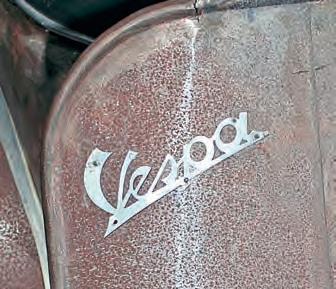

Some time ago the Surrey Vintage Vespa Club started running its London to Brighton rides These were aimed specifically at 125cc, eight-inch wheeled, piston ported Vespas. Over the years I was graciously loaned several valuable scooters in order that I could participate and cover the event for Scootering magazine. All was well and good until I realised that each machine had roughly the same horsepower. As the one I was allocated not only had to haul my hefty gut but also lug around a heavy camera bag, being in the right place at the right time was often a challenge. What I needed was a scooter which met the fairly strict criteria but that wasn’t always lagging behind the pack Obviously I wasn’t going to be able to modify someone else’s scooter so the hunt was on to find a scooter that would not only qualify for the event but also be receptive to some light modification. The model I settled upon (fortuitously for this feature) was a Douglas 152L2 Not only was it more common, and therefore less expensive than other models, it also shared some mechanical features with later Vespas. I hoped these might make it easier to add a little speed without fundamentally altering its character. Having found a completely stripped scooter locally for a bargain price (I had no idea if it was complete and neither did the owner) I began to dry build a 152L2 in my office.

Our man Richie’s something of a scooter masochist, but even he realised that a 152L2 needs updating for modern roads
| SCOOTERING | JANUARY
The 152’ had been stripped of all its paint and then left in damp conditions which had left it with an even coat of rust. With most of the main parts present, the scooter sat quietly behind me in my office as a kind of ‘mechanical muse’ that I would turn around to seek inspiration from when I was word-blocked writing features

Over time the little machine grew on me and I decided that I’d prefer to build it as a ‘rat rod’. I can never decide on paint schemes anyway so this was the easiest option
While considering what to do with the engine I remembered a test I’d conducted with Matt Phillips of the Surrey Vintage Vespa Club. This had featured an Ancilotti conversion kit which transformed the performance of a Sportique.
The first thing I needed to do was to get rid of the 152L2’s deflector piston along with the matched head. These might have been just the thing for all grades of fuel and shoving gases just where they needed to be back in 1959, but nowadays they’re just plain slow. Not having any idea about piston dimensions or compatibility I ran my ideas past Harry Barlow of Pro Porting fame. Unsurprisingly he quickly came up with some possibilities, the only problem being that all of them were domed pistons which would need a corresponding head profile Out of curiosity I offered a standard P Range 125 head up to the studs of the 152’s 1959 block and the head slipped over them perfectly. If there was ever proof that if something isn’t broken why fix it, that was it!
With that major hurdle averted, Harry sourced a Japanese motorbike piston and correct length con rod to mate to the original spec crank. The whole lot was then


WWW.SCOOTERING.COM |
assembled with quality high load bearings. I also asked Harry to tweak the ports a little as I wanted low down (don’t laugh) power delivery to drag my ass and camera bag around country lanes as fast as possible.
In Harry’s eyes the major problem was that the three-speed gearbox would limit the gains in performance, but as I was mostly interested in just being a little faster than the other scooters on the ride I didn’t see it as too much of a problem. To make its legs a little longer a different primary could be fitted or four stud, 10-inch GS150 (VS2-4) rims and tyres could be used However given the Surrey club’s criteria, that would have been a modification too far
The carb is still the standard Amal as all the tinware I had was for that model but I may change that to a Dell’Orto once it’s run in. The exhaust is a modern LML item Harry had lying around as it would breathe better than the pea shooter fitted by Douglas. The masochist in me stuck with the original internal mounted coil stator plate as I like how it exits the block and the HT cable routing and little airbox-mounted clip that keeps it in place. This may prove to be sheer folly so I have a Sprint flywheel, stator and coil ready to go in if needs This description only covers the highlights of the work Harry put into this little scooter but, if you’re interested in a similar conversion, Harry has now built a few and is now dialled in with these upgrades.
The big question is did it all work? Most definitely yes, acceleration is now brisk and throttle response is immediate, it even has low end ‘power’ to pull me out of the bends. I would probably describe it along the lines of the difference between a PE150X and a standard T5, it’s that dramatic. Harry says there’s plenty more left in it and an increase in capacity is also an option. If I were to go down that route a front suspension and brakes upgrade would be needed as bottoming out under braking isn’t my preferred method of corner entry. The top end hasn’t been explored yet as I’m still setting the jetting on the carb but I’m confident a
genuine 50mph can be reached without further gear or tyre diameter alterations. Did it meet my needs and expectations?
Most definitely yes, if honest I’m looking forward to riding it with similar vintage scooters and maybe seeing if I can mix it up a little with some GS150s. As an experiment in getting something to do what it wasn’t supposed to, it’s been a revelation. I’ve been surprised at how receptive older model Vespas are to being modified
Although bolting in a PX lump may be the easiest way of improving the performance of an early Vespa, it’s a damn sight more satisfying to do the job properly


I’m looking forward to riding it with similar vintage scooters and maybe seeing if I can mix it up a little with some GS150s.

WWW.SCOOTERING.COM |
Model first seen: Milan Show 1958 (VNA).

ENGINE
Displacement: 123.7cc.
Bore x stroke: 54x54mm.
Compression ratio: 6.5-1.
Power: 4.5bhp @ 5000rpm.
Carburettor: Amal 503/1 (Dell’Orto UA/16S1 on imported machines).
Petroil mixture: 5%.
CHASSIS
Construction: Monocoque.
Front suspension: Trailing arm with coil spring and damper.
Rear suspension: Coil spring and damper.
Front brake: Drum, 125mm.
Rear brake: Drum, 127mm.
Tyres: 3.50x8” front and rear.
DIMENSIONS
Length: 1655mm.
Width: 790mm.
Saddle height: 700mm.
Wheelbase: 1130mm.
Tank capacity: 6.5 litres.
THE ABC VESPA 152L2


BELOW
AND RIGHT:
The
two iconic Rollershop catalogues
| SCOOTERING | JANUARY
Cast your mind back to the late 1980s and advertisements in this very magazine for PM Tuning. A full page each month offered performance products to enhance both the Lambretta and Vespa Irresistible reading for those who wanted to go faster Then it happened: one month a small section of PM Tuning’s advert was dedicated to a new kit by Zirri This offered unbelievable performance for the smallframe Vespa, with potential speeds of more than 100mph What or who Zirri was no one really knew but the name certainly had scooterists talking. This wasn’t long after the TS1 had transformed Lambretta ownership and it seemed that Zirri had achieved a similar leap forward for Vespa owners

Sadly, the kit’s £600 retail price meant it was out of the reach of most scooterists and this, combined with the fact that it was unsuitable for the PX, meant that sales were slow. A couple of tasty demonstrators built by PM Tuning were featured in Scootering magazine but even they couldn’t lure in customers
In the UK, Zirri’s concept slowly faded into obscurity but it was a different story on mainland Europe. It was there that a legend, actually two of them, were born.
Zirri is the man
Italian Bruno Zirri was an active Vespa tuner and had been producing racing products to fit them since the late 1970s. Concentrating his efforts on the smallframe models, his radical approach soon gained the attention of those who wished to race at the top level. Then, as now, scooter racing was a very competitive sport, one that was dominated by the agile Vespa smallframe Its compact and tiny engine was also proving itself to be strong and formed an ideal base for tuners such as Bruno to take advantage of
This was a time when mass manufacturing was far more difficult; there were no CAD simulations or computeraided milling machines For Bruno that didn’t matter. He let others take care of the basic design and production, adopting commercially available cylinder kits which he modified to his own specifications.
Using parts created by himself or adapted from other engines he produced several machines with what were then unbelievable power outputs. Race success followed and the Zirri name became closely associated with Vespa tuning, a reputation carried on to this day by his son, Angelo Two of these racers were sold on and soon became part of the scootering world’s folklore

Bringing an iconic Vespa back to life isn’t an easy task and it’s even harder when there are two of them
The red one survived but in extremely poor condition.
WWW.SCOOTERING.COM |
The one-stop shop
While the scooter revolution of the 1980s is most associated with the UK, it wasn’t doing too badly in other countries, particularly Germany. Here the Vespa was dominant and scooter ownership played a pivotal role in the lives of many teenagers Apart from main agents there weren’t many shops that catered for their needs, certainly not for aftermarket products – that was until the introduction of Rollershop.
Based in Adelsried, southern Germany, Rollershop was the epicentre of products for hundreds, if not thousands, of scooter owners. The store had everything that could be wished for and a trip to this Germanic scooter mecca was on the wish list of every continental scooterist. What made Rollershop different was the shop’s mail-order system, meaning that parts could be delivered direct to the door, sometimes even next day These were pre-internet days and Rollershop’s business model was revolutionary. There’s little doubt that it paved the way for the big scooter shops of today and how their online businesses operate.
With very few scooterists having access to computers, ordering was done by the old-school method of a mail order catalogue
As Christian Schnieder, an avid fan of Rollershop, explained: “They were a big glossy affair, A4 in size and full of products from cylinders to expansion pipes. We would spend hours drooling over the pictures and plan what to buy. They were like the holy bible to us.” Like any product catalogue they were updated each year and surviving examples are now highly sought after.
Front cover

The ‘shop window’ for Rollershop was the cover of its catalogue and the machines most associated with this phenomenon were built by Zirri One catalogue featured a red smallframe, while another edition showcased an example finished in black These were the machines that every German scooterist wanted to build and the two scooters achieved iconic status. With the radiator on the front, a huge Dell’Orto carburettor sticking out of the side, and drainpipe-looking expansion pipes the
images did their job and easily sold the products that were available inside.
As the 1990s came to an end and the internet era arrived, Rollershop closed its doors with companies such as Scooter Centre and SIP taking on its role Although it was no more, Rollershop’s reputation had been cemented in history The two cover scooters were a critical part of the nostalgia felt for the company and this is where our story really takes off.
Here and there
Christian Schroder is one of the many who remember the two Vespas. So passionate was Christian about the machines that he devoted years to tracking them down.



Relatively quickly he discovered that the black Vespa had been sold off many years ago to a model shop where it had lain idle for years after being taken apart. In 2016 it had been discovered by another enthusiast who’d restored it. However the scheme was not original and many of the original components were missing. Christian managed to track down the new owner, buy
 At the front the TVR radiator sits alongside the original stickers.
Thought lost forever, the complete engine was discovered close to Rollershop’s base.
On the bench: one of the engines ready to reveal its secrets.
At the front the TVR radiator sits alongside the original stickers.
Thought lost forever, the complete engine was discovered close to Rollershop’s base.
On the bench: one of the engines ready to reveal its secrets.
These were the machines that every German scooterist wanted to build and the two machines achieved iconic status.
Clear evidence of the tuning work carried out by Bruno Zirri.
Though it looked tired and dirty, the engine was in remarkably good condition.
| SCOOTERING | JANUARY
SPECIFICATION
The Black One
Frame: Vespa 50 Special.
Engine: Vespa 50 Special.
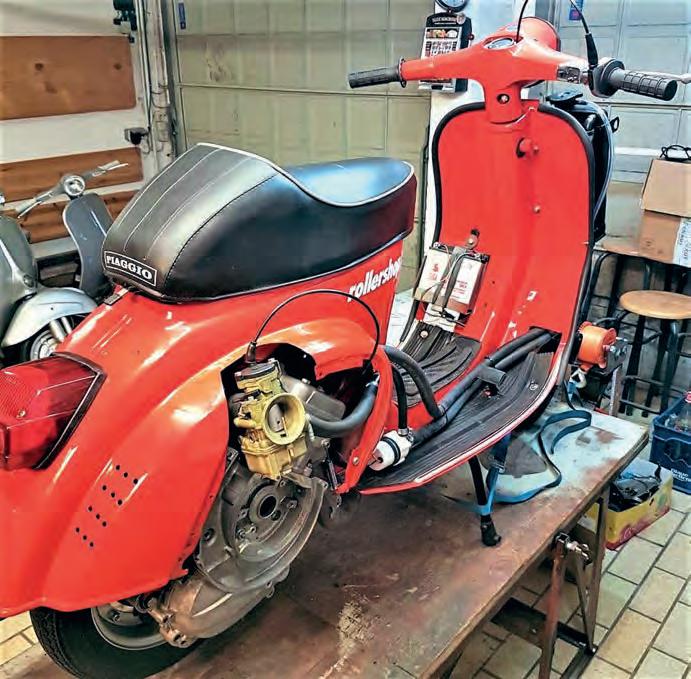
Cylinder: Eurocilindro Parabellum water-cooled 133cc 18hp.
Crank: Mazzucchelli racing crankshaft stroke 51mm.
Gearing: 2/64 primary four-speed gearbox. Original four-disc clutch. Eurocilindro exhaust
PRA radiator.
Ignition: PK 12v turned down Carburettor: Dell’Orto 34 PHBE magnesium.
Suspension: Bitubo rear with expansion tank, front original.

The Red One
Frame: Primavera ET3
Engine: Primavera ET3
Cylinder: TVR 30 water-cooled 127cc approx 25hp.
Crank: Zirri full cheek crankshaft with Tau TVR connecting rod stroke 50, 6mm.

Gearing: 2/64 primary four-speed gearbox. Original four-disc clutch.
Tau TVR rewelded exhaust.
Tau TVR: radiator with water pump from a caravan Ignition: Motoplat 6v electronic.
Carburettor: Dell’Orto PHBE 36 sz magnesium with Powerjet.

Suspension: Bitubo rear tube version, front original.
Primed and ready for its topcoat.

the machine and hatched a plan to restore it once again. This time it would be painted in its Rollershop scheme and wherever possible original parts would be used.
The red machine had also been dismantled, with the frame finally landing in the hands of a friend, Dennis Neumann Christian knew about it but with the engine lost it seemed impossible that it could ever be returned to its former glory That was until 2019, when the complete engine was offered for sale on eBay. In an instant Christian realised it was the missing piece and made sure he was the winning bidder Persuading Dennis to sell him the frame was a task easier said than done but after long negotiations a deal was struck and resurrecting the pair of machines now seemed to be a reality.
Overhauling the one-off crankshaft.
Rebuilt and ready to roll once again.
Back to red and the main build could commence.
Even with the engine in place it looked impressive.
Simply red
It seems like only yesterday these machines were built, but we are going back 35-odd years in time and left to the elements it doesn’t take long for a scooter to deteriorate. From a cosmetic point of view the red Vespa was appalling, but thankfully the frame was still structurally sound and the engine still largely complete
The first job was to strip the frame bare, carry out any repairs that were needed and finish by spraying it red again The preparation was time-consuming but worth the effort The finish is now as good as when it originally graced the catalogue’s cover, with all the relevant decals painstakingly recreated and put back in place. Throughout the project Christian was adamant that every detail must be correct to the original specification and the finished result reflects his painstaking approach.
Upon stripping the engine, it was clear to see that good old oxidation had taken hold of not just the exposed surfaces but also internally Thankfully nothing was seized so careful cleaning and restoration of the components was all that was required. Items such as the crank were fully rebuilt and for the first time, it was possible to see how high-level tuning was done back then. Even the exhaust was salvaged, adding an authentic ‘voice’ to the restoration.
Back in black
The black Vespa required a far less intrusive approach. As it had been discovered and saved much earlier than its sister machine the work was far less intense. The main problem with this build was the long list of missing original components. Thankfully Angelo Zirri took an interest in the project and was on hand both to help find original components and recreate the machine’s exact specification. Christian gratefully acknowledges that it’s only thanks to the assistance he received from Angelo and several others that the project was finished.


Born again
After several months and more than 400 hours, with the red one taking the longest, the resurrection of both machines is now complete For Christian, it had been a dream to one day own such iconic machines but there was far more to it than just that Many of the great custom and racing scooters of the past sadly no longer exist and those that still do have often required a lot of work to get them back to their former glory. Here the task was far more difficult as there were two machines to work on. What’s more important is their history is now preserved and without enthusiasm this would never have happened. Thankfully Christian is also happy to share them with the world and the two machines were recently the star attraction at Scooter Centre’s open day.
There are no plans to put them on a dyno; Christian knows that compared with today’s standards both machines are underpowered. That doesn’t matter because at the time they were built they were ground-breaking machines
For the same reason he has no plans to race them. Frankly just being able to see them, restored and back in the limelight, is more than good enough
Red or black? You decide
One of the questions these machines now pose is which one would have been most desirable back then? The red Vespa is by far the most developed with an estimated power output of 25bhp while the black one is slightly more sedate, kicking out about 18bhp. These aren’t impressive by today’s standards but with their lightweight frames both will still deliver great acceleration and a huge amount of fun. Comparing them with modern kits is also largely irrelevant – it’s like asking whether James Hunt or Lewis Hamilton drove the best car. Both are undeniably champions of their era.
When they were built there was nothing quite like these two scooters, the LC smallframes of Norrie Kerr are probably the nearest comparison. So, the answer to my question is simple, either one would have been a pleasure to own back then and both a pleasure to own now. Their resurrection has been nothing short of miraculous and many thanks to Christian Schroder for sharing their story with us
Words: Stuart Owen
Images: Christian Schroder
Additional information and help: Christian Schnieder
The black one wasn’t far behind in the race to be finished first.
Even on the bench it has a thoroughbred race look about it. | SCOOTERING | JANUARY
So passionate was Christian about the machines that he devoted years to tracking them down.


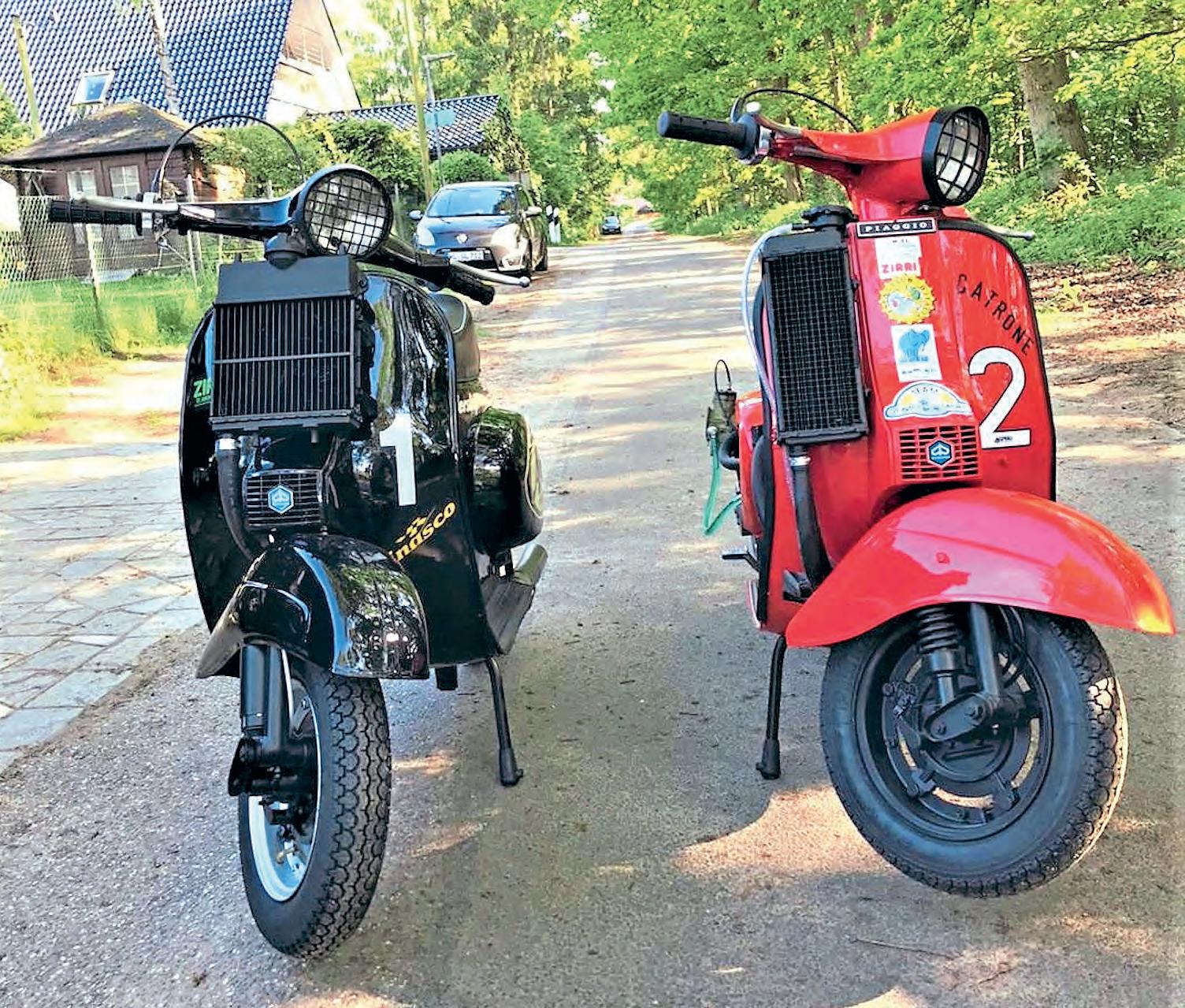
 Both stunningly restored.
Finished – and from the front, they ooze perfection.
Bruno Zirri on the left.
Bruno’s racing Vespas pictured in the mid 1980s. The one at the front would become the black one.
Both stunningly restored.
Finished – and from the front, they ooze perfection.
Bruno Zirri on the left.
Bruno’s racing Vespas pictured in the mid 1980s. The one at the front would become the black one.
WWW.SCOOTERING.COM |

Paul and his reborn Royspeed. | SCOOTERING | JANUARY
Royspeed reborn
In 1971, on his 16th birthday, Paul Gibson bought his first scooter. It came from his local dealer Roy of Hornchurch and he still rides it today.
Most of the 1970s are viewed as a fallow time for scootering, with Japanese made, budget two-wheelers replacing Italian scooters as the transport of choice for commuters Although many had moved on to new fashions and music there remained a small but passionate band of enthusiasts scattered around the country Thanks to these individuals the flame of scootering was kept ablaze, waiting to be rekindled by the Mod revival; among this small band of brothers was Paul Gibson.
Early days

Sarge: How did you first become interested in scooters, and what do you remember about getting your first scooter?
Paul: “I lived and grew up in Romford. My brother was eight years older than me, so he was around in the Mod years and had a Lambretta parked in the back alley of our house From when I was 12 or 13 I used to start it up and ride it when he wasn’t around. Romford had a strong skinhead following, the older guys were into scooters big time, we’d see them meet up at cafes, snooker halls and discos like Laurie Hall, Romford Market Place, Kims Hall, Hornchurch and Pettits Lane Youth Club. They’d turn up on their scooters looking well hard and cool. I was determined to get one of my own. Although we were only in our mid-teens we thought we were a top skinhead crew. When we turned up at a local hall disco one of us would get the DJ to play Steppenwolf’s Born to be Wild, we’d do the greaser dance, parkas flying. It was a piss-take of the local greasers, Devils Henchmen, who didn’t own a motorbike between them
“Turning 16 in 1971, our crew decided we were going to buy scooters and went down to Roy of Hornchurch. Ronnie Cook bought a TV175, Steve Mulchay bought a Lambretta Series 1 which he cut down to make a Skin

WWW.SCOOTERING.COM |
skelly, Steve Webb bought an SX200, Steve Clarke, who worked in insurance and had money, bought a blue and white GP150 to which he added a tuning kit, a Dell’Orto downdraft carb and a Snetterton seat. Keith Haxell’s mum and dad wouldn’t let him have a ‘real’ scooter so he bought a turquoise Vega. I picked out a 1962 Li150 which had one previous owner.
Recollections of Roy’s
Sarge: What memories do you have of that time?
Paul: “We’d hang about outside Roy’s all day Saturday and on Sunday mornings The shop was a magnet for solo riders and clubs for miles around Roy Cary was a bit of a character, always suited and booted. He was a brilliant salesman though. The only time I can remember exchanging more than a few words with him was when I went along with my dad to buy that first Li150. I handed over the £40 that I’d saved up working in a builder’s yard. My dad paid the tax and insurance as a birthday present. He signed the paperwork as I was legally still a minor
“Dick Sedgley was usually on the front counter. He’d announce what was going to be coming in as new stock, things like Royspeed manifolds for Amal or Dell’Orto carbs, big-bore exhausts with high clearance or Ancillotti and Snetterton seats. Over time I fitted an Amal Mk1 with a Royspeed manifold and a Royspeed 48mm big-bore high clearance exhaust. I had the ports on the barrel enlarged, a skimmed cylinder head and got an Ancillotti seat. Being only 16 I had to save up paper round money to buy them
“When I bought the Mk1 Amal and Royspeed manifold, I fitted it outside the shop and hacksawed a cutaway in the side panel. The cutaway had to be extended from my first attempt so my hand could operate the choke tickler. I remember Dick Sedgley saying a new candy metallic paint would be arriving for the following Saturday One of our crew, Ronnie Cook, was a postie so had money, he bought a couple of rattle cans of candy metallic paint, then sprayed his legshields in the street outside the shop!
“I gave my Li a home paint job, in stages,
rattle can blue legshields, a few touches of red oxide, and lots of Dulux gloss. I did the side panel designs in black, including the signwriting. I named my scooter Five-O after the TV programme. Doug May, a top scooter racer at the time, worked in Roy’s workshop, he signed one of my side panels after doing some work on the barrel ports. If not fitting new purchases on our scooters, we’d chat, have coffee and a fag, swapping ideas. Lunchtime we’d head down to The Bull for beer and skittles, pubs were only open between midday and 2pm, then we’d go back to Roy’s Our lot was The Vikings scooter club. I’ve still got my club legshield banner.”
Memories of scootering during the 70s
Sarge: Tell us some of your experiences riding your scooter in the 70s. Was there much of a rally scene and did you try your hand at scooter sport?
Paul: “One little anecdote from riding a scooter that typifies the scooter life of a teenager in the 1970s comes to mind. We’d go to Ilford Palais on a Saturday night and park the scooters up out front. One night I met up with a girl, after a couple of vodka and limes and a few dances she accepted a lift home to Romford on the back of my scooter. What she didn’t know was that she would have to hold an EverReady red bicycle lamp behind her back Typical Lambretta,

Thanks to these individuals the flame of scootering was kept ablaze, waiting to be rekindled by the Mod revival; among this small band of brothers was Paul Gibson.
| SCOOTERING | JANUARY
IN A 70s SCHEME
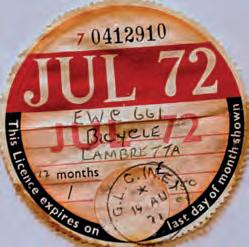

no working lights, the back lamp had fallen off on the way up there! On my own I would have just gone for it, I could easily outrun the old Morris Minor panda cars, but two up was another matter To say she was unhappy with this is an understatement, wearing her tonic suit, white woollen pattern tights and chunky shoes meant that the ride was bad enough Having to hold a bicycle lamp all the way home meant her hands were frozen too. After the eight-mile ride, her shoes and tights were filthy, covered in petrol from the open mouth Amal. We didn’t go out again…
“My scooter used to be a problem to start, especially in cold weather. One cold day at college it was playing up, wouldn’t kickstart, I tried bumping it across the icy college car park. I ran up and down, just as it fired up I fell over on some ice, my scooter carried on straight into a lecturer’s car, leaving a nasty dent in his door to say nothing of my buggered front mudguard and legshields Needless to say, I picked up the scooter and scarpered quick. Rallies were a lot different in the 1970s. We weren’t really into rallies, it was more about posing in town
“Our No.1, Steve, got us to join a scooter club, The Vikings, West Essex Lambretta Club. We went to the Isle of Wight as a club with a back-up van which must have been


around 1971-72. I guess it was an LCGB event, but can’t forget racing around the Island, fighting with greasers in old Zephyrs and Bedford vans poking scaffold poles at us We had a great time and I’ve loved the island ever since. I never tire of cruising around its country roads, the Isle of Wight was made for scooter riding.
“My first rally proper was an LCGB one in Leigh-on-Sea near Southend on a reclaimed landfill site, great fun. Old school mixed with us younger lads, scooter tug of war, scooter chariot racing on dustbin lids and grass track racing. No health and safety crap then.


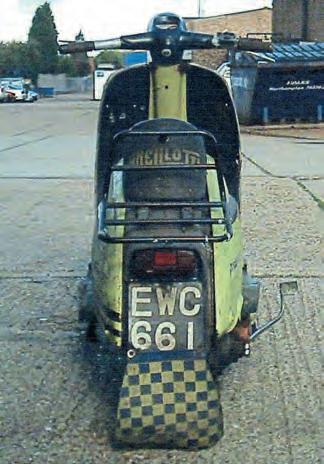
“I think it may’ve been in Kent where we went to a few scooter grass track meetings, we were affiliated to LCGB, we supported their events. We all had a couple of goes at grass track tracing. We entered on our road bikes which we’d ridden there, wearing Doc Martens, sheepskins and jeans so pretty much our everyday clothes. We were having a bit of fun on our scooters, riding home on them afterwards.

STORED
Although Paul has no photographs from his 70s scootering days, when he rescued his first scooter from his mum’s garage, where it had been stored, with a view to restoring it and putting it back on the road, he took a few before, during and after snaps. Every picture tells a story...
It’s the Five-O!
Reduce, reuse, recycle.
Original manifold and Mk1 Amal, Paul’s Royspeed exhaust was lost in a house move some years ago…”
Paul’s original handiwork has been preserved.
WWW.SCOOTERING.COM |
It felt like the older and more serious racers in their matching club overalls or heavy knit club jumpers looked down their noses at us.
“At some of the gymkhana events we had a laugh doing scooter tug of war, and chariot racing on bin lids, we even invented a few of our own games, which didn’t go down too well with the organisers We didn’t have cameras back then, they were a luxury too far, any spare money went on clothes, records, going out and our scooters, sadly I’ve not got any old photos from the 70s, just memories.”
Born again, scooter and scooterist
Making the transition from scooters to a car, getting married, raising a family and running his own business took Paul away from the scooter scene for some years. He kept his first scooter tucked away in his mum’s garage. From his 70s scooter days Paul always liked the Isle of Wight, he’d annually take his wife, and subsequently his two daughters, there for a family holiday. Purely by chance, one year not too long after the turn of the Millennium he was on the Isle of Wight on a family break which coincided with August Bank Holiday weekend.

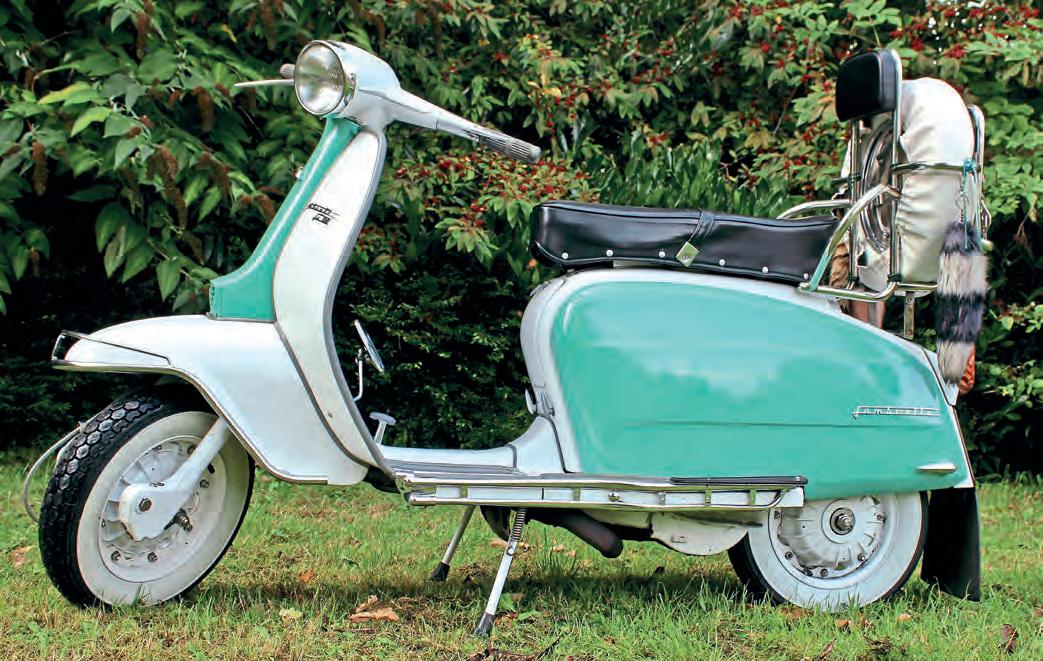
“I was having a pint at the Spyglass Inn in Ventnor over the August Bank Holiday and heard the distinctive pop-pop of two-stroke engines pulling up outside. I had a quick

chat with the guys on scooters who explained that the rally was back on, and that was it. That chance encounter inspired me to get the old scooter out of my mum’s garage and back on the road, supported by my wife who encouraged me to do it. I took my old scooter to Bedlam for a complete restoration, though I did ask for the filled cutaway in the side panel to be left rough on the inside, as a reminder of that day outside Roy’s. It took about six months for it to have a full restoration. In 2006, I got my second scooter, a Series 2, the idea being to keep my Li for best, and ride the Series 2 the rest of the time. It’s always good to have a spare, just in case!
“Fifteen years on from having it restored, I sometimes look back at what the scooter once was, and what it meant. I wonder if perhaps, just perhaps, I should have kept the old paint job and concentrated on just restoring the mechanical bits. Still, it’s done now and the most important thing is after all those years in the shed it’s living the life that a scooter should, being ridden regularly.”
When I bought the Mk1 Amal and Royspeed manifold, I fitted it outside the shop and hacksawed a cutaway in the side panel.
Restored and regularly ridden.
Words: Sarge
Images: Sarge and Paul Gibson
| SCOOTERING | JANUARY















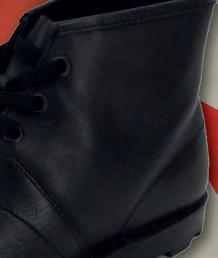



































































If you’ve ever fancied scooting in warmer climes, We Scooter, The Royal Alloy dealership in Thailand, invites you to tour this beautiful country.

| SCOOTERING | JANUARY
We’ve all fantasised about pottering around on a scooter in some idyllic location and after two years of Covidenforced isolation the rest of the world’s never looked more appealing. Fortunately Britain isn’t the only country with a strong scooterist community and Elvis Lv of We Scooter, Royal Alloy’s dealership in Bangkok, was only too keen to explain the scooter scene in Thailand.

Dealer focus
Although there are more than 21 million scooters registered in Thailand, the overwhelming majority of them are used as daily transport The concept of a scooter being used as a ‘hobby’ is a relatively new phenomenon and is mostly popular with younger riders, typically aged between 25 and 35 years old. This group has adopted the ‘retro scooter’ as its own and Royal Alloy is a go-to brand because of its classic 1960s styling. Rather like European club scootering of the 1950s and 60s, Thai riders have strong affiliations with dealerships and because of this We Scooter has developed its own club. A coffee bar has been built
next door to the showroom with the two being connected on a walk-through basis
Although the British market is dominated by 125 and 300cc scooters, thanks to local licensing and tax regimes the most popular engine size in Thailand is 150cc. Asa consequence the Thai rider gets to enjoy models that aren’t found in Europe. For Royal Alloy this means supplying the market with a single cylinder, four valve SOHC motor with a capacity of 149.8cc. (For further information see the panel on page 58.)
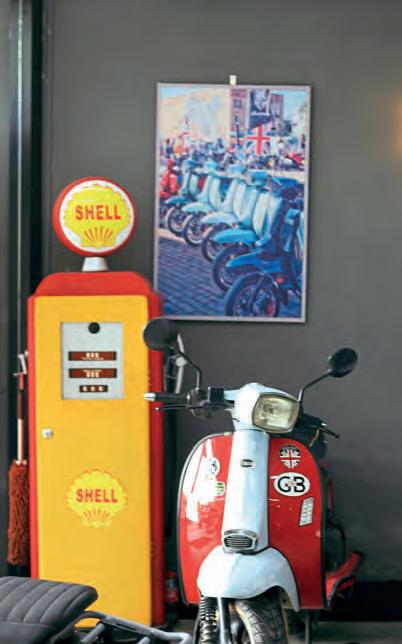


Road tripping in Thailand

As Elvis explained, Thailand is a fantastic country to explore by scooter, but it needs some mental preparation. “We encourage people to come and ride here but take care, you’ll find it very different from your home country. There are many, many beautiful sights to see when on your scooter and we’d highly recommend a visit to Chiang Mai in the north of Thailand It’s an ancient city with a perfect blend of incredible mountains and historically rich architecture. The weather here can change quickly and when the rain comes, it comes in very hard, fortunately it also dries very quickly too.

WWW.SCOOTERING.COM |
“There are also huge traffic jams in the big cities, these are often caused by scooters, but scooters are also the only way to find a way through them. Another thing to keep in mind is that outside of the main towns and cities you can’t rely on an internet signal, so you must plan and know your route first.”
Whether it’s as part of a family holiday or dedicated riding adventure, if your appetite’s been whetted and you fancy scooting Thailand, We Scooter’s helped put together a few basic points for you to consider (facing page). However Elvis’ main recommendations are simple: “Ride carefully, observe the law, take your time and enjoy all the breathtaking scenes that Thailand has to offer.”



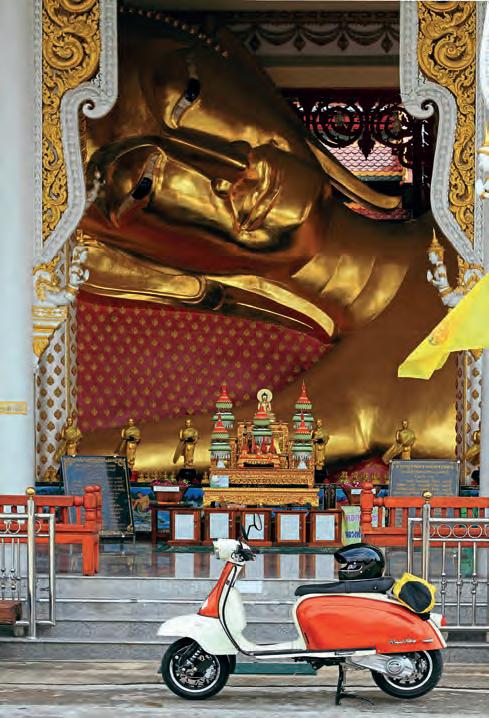
Words: Rik / We Scooter /
Chalermchai Tunsingha

We Scooter,
THAI SPECIFICATION ROYAL ALLOY
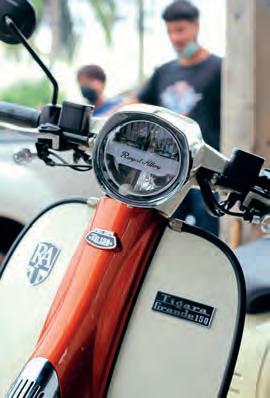
Net
Front
Elvis Lv Images:
(Nuim) / Royal Alloy Thailand / We Scooter
dealership, coffee house, good people.
(as seen in the images) Royal Alloy TG 150s Colour: Valencia Orange and Ivory Engine type: Single cylinder four valve SOHC 149cc Fuel System: Delphi EFI Start mode: Electric Max net power, rate (kW/r/min): 9.8/8500 Overall size: 1845 x 670 x 1115 Fuel tank capability (L): 10.5
loading weight (kg): 139
brake: Disc brake ABS Rear brake: Disc brake ABS Retro is hot in Thailand. | SCOOTERING | JANUARY
Insurance
If you listen to no other advice, buy a good travel insurance policy before you travel and make sure it covers you for riding a motorcycle in the country you’re visiting. Policies have different requirements but most stipulate that a helmet must be worn and you have a valid licence for the scooter you’ll be riding. If you don’t comply with their terms and conditions your insurance company is well within their rights to refuse your cover. It may seem like a faff sorting that out but the backpacker forums are filled with stories of travellers who chose to save a few pounds but now face crippling medical bills.

Helmets
Rental shops offer them for free, but inevitably they’re made of cheap plastic and probably do more harm than good in a tumble. This type of helmet is also sold around markets and busy streets, often for around $5. If you think a helmet costing so little’s going to prevent you from serious injury then Darwin probably had a point.
It’s much better to visit a main dealer and addresses for these can easily be found on the internet. It’s also possible to take your own helmet with you and it’s always worth enquiring whether your airline will allow them as carry-on luggage. If you’ve an old helmet at home our tip is to take that with you, it’ll be better than most helmets bought locally. Invariably you’re going to sweat and get dusty and an old helmet can be discarded at the end of your trip
Renting
Renting a scooter in Thailand is not a problem but you’ll have to produce your passport and driving licence. In most places it will be copied and handed back to you but some shops insist on keeping your passport until you bring the vehicle back. The local police can insist on seeing your papers in the event of an accident and not being in possession of your passport can be problematic so it’s worth negotiating a deposit that allows you to keep hold of your documents.

Before you ride off, always take photographs of the scooter, paying close attention to it, particularly to any scratches or existing damage. Make sure that the staff are made aware of them and always insist that they mark them on the rental form.
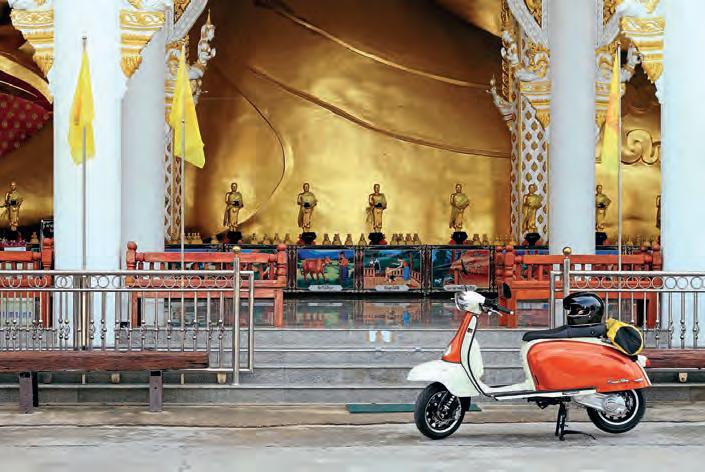
Road safety
Please bear in mind that Thailand has some of the most dangerous roads in the world Accidents are frequent, with the victims usually being expats or tourists Ride with caution and observe the traffic very critically. Stick to the left and ride at a steady pace. Remember to use your mirrors very, very frequently and always indicate, especially in the cities This is true even if the locals don’t.
Drunk driving is not strictly punished in Thailand and many people drive under the influence of drink and many other substances too! Keep your eyes, ears and wits about you.You may be the safest rider on earth but that doesn’t allow for others on the road.
Ride carefully, observe the law, take your time and enjoy all the breathtaking scenes that Thailand has to offer.
WWW.SCOOTERING.COM |
What do you get when you mate an Italian scooter with an Italian kart engine? As Stu Smith discovered, the answer’s no joke.

kart
on a mission.
Man
Ifirst saw this scooter at a local multi-meet where it was swarmed by an array of amazed onlookers. Once they’d finished snapping photos on their phones I managed to get a moment with the owner, Mark Milner, and learnt that the project had been a long time in the making.
Hard working
Mark comes from a mining village in West Yorkshire called Allerton Bywater. He grew up on a council estate there and his dad was a miner at the local pit.
At the age of 12 Mark helped on a milk round and it was during this time that his interest in go-karts developed. “The milkman’s son raced them, so they were the main topic of conversation. Eventually I clubbed together with a mate and bought one powered by a Villiers 210cc engine. We used that to make a nuisance of ourselves racing up and down the farmer’s lanes near to where I lived.”
When Mark left school he started an apprenticeship at a local engineering company. “I was earning £23 a week. My mates who’d gone straight to the pit were earning £80 per week and I couldn’t match their spending power, by Sunday my money had run out! My dad could see I was struggling and helped me get a job at the pit. It was hard work and meant working shifts, but my earnings rocketed and I finally had some disposable income.”
While Mark’s passion was go-karts, some of the lads on his shift were into scooters. “Roy Adams was a scooter racer while two others, Lance Bird and Steve Spears, rode with Kippax SC They used to bring Scooter Scene magazine into work with them and that fired my interest in scooters.”

Boy racer
Although scooters began to occupy more of his time, it wasn’t road riding that grabbed his imagination Thanks to his passion for go-karts he was naturally drawn to scooter racing and the development of performance engines.
Around that time Mark bought his first scooter, a cut-down Lambretta GP 200, which he completed on a very tight budget “One of the first times I used it was in November 1983 to go to a scooter race meeting at Snetterton. Three of us rode down and camped out. Watching the scooters race inspired me, but it was freezing. I can still feel the cold!”
During the miners’ strike Mark hit hard times “I’d gone to the pit to earn more money, but around a year later we were on strike and I had to sell my scooter.”
After the strike Mark stayed at the pit for a while but eventually started a new career. He met his wife, Maria, and started a family “I also got back into go-karts, I was racing gearbox 250cc karts and my son, William, was racing as a junior. It’s not the cheapest of hobbies and funding both of us became too costly. I stopped so we could concentrate on William, but when he turned 17 he was signed to play semi-professional Rugby League and as part of his contract he was forced to stop racing.”
This was the cue for Mark to sell up his collection of karts and equipment. “My interest in scooters had never waned and selling the go-kart equipment allowed me to buy an Italian GP200 Everything went but I kept the best engine, a Pavesi 125cc.”

Checking the route.
Although Mark’s a Lambretta man at heart there was a reason for keeping the Pavesi engine. “Thanks to its shape and size I thought the kart engine would fit neatly into a Vespa. The prospect intrigued me and I decided that I’d build myself a very angry wasp!”



Scrap to stardom
In 2018 Mark began searching for a suitable donor scooter and eventually found a cheap frame. It was in a poor state, the back end was rotten, it had no side panels and no engine. Nevertheless it had all the elements that Mark required and once the frame had been blasted clean of paint and rust Mark began turning his vision into reality “I didn’t have any written plans for the project, just the concept in my mind. Developing the build was a process of trial and error
Chain drive makes sense with the covers off.
Dry fit.
| SCOOTERING | JANUARY
I’d see if things matched or not, and when I hit a problem it was back to the work bench and several fabrications later things would finally come together.”
One of the first major challenges Mark faced was fitting the chain-driven engine to the scooter “I started by making a subframe, which I attached to the Vespa frame and then, with the rear wheel attached, I mounted the engine on to it to check the shocker fitting. I then fitted a rear disc brake to the drive axle and developed a home-made gear change mechanism. It uses sequential gear shift but operates in the same way as the traditional scooter handlebar’s movement. I also fabricated an idle sprocket to stop the drive chain coming into contact with the gear change mechanism.”
While all this was going on, Mark was also working on other areas of the scooter “I developed a set of standard PX125 forks with a modified disc brake set-up and a home-made exhaust On a go-kart the exhaust comes out of the rear of the engine and passes around the back of the seat. On a scooter it comes out of the front, so I had to route the exhaust through the frame and curl it back.”
Gentlemen, start your engines
Having got the scooter running, Mark took his angry wasp for a shakedown ride.
“Overall I was pleased but during the ride I
discovered that the carb induction noise was louder than the exhaust! To deal with the problem I fabricated an airbox silencer from a four-inch section of drainpipe and added two aftermarket induction trumpets. Also the engine still had to be bump-started so I developed a pull-start mechanism, which was actually one of the most complex parts of the job.”
The engine has three ignition maps and in ‘full kart mode’ the 125cc engine delivers an incredible 46bhp. Considering that Aprilia’s 125cc GP bike, reputed to be the world’s most powerful 125cc motorcycle, claims 55bhp, that’s not at all shabby for a street scooter.



OWNER
Name: Mark Milner.
Job: Construction manager.
Scooter club & town: Independent rider, Castleford.

First interest in scooters: In the early 80s when I got into the scooter racing scene.
First scooter: 1983 cut-down GP200.
Favourite style of custom scooter: Street racer.
Panels are a work of art in themselves.
You’ve heard of Elestart, meet elbow start.
Brace yourself!
The engine has three ignition maps and in ‘full kart mode’ the 125cc engine delivers an incredible 46bhp.
WWW.SCOOTERING.COM |
The engine’s cooled through the radiator seated neatly behind the legshields, while a constant loss battery powers the waterpump and lights, giving around two hours of use, which is all Mark needs.

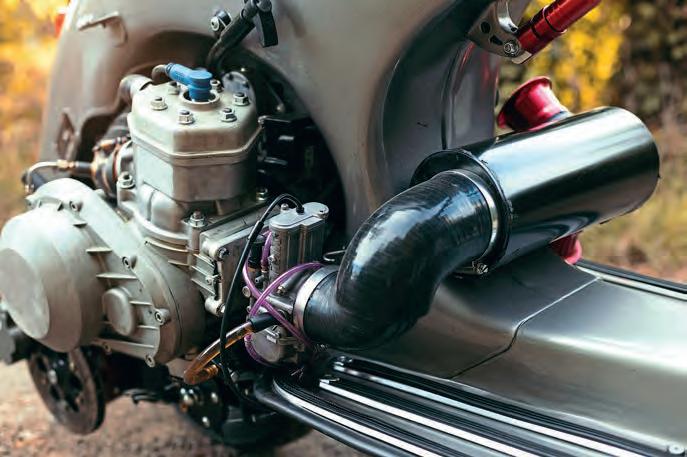
When you consider that the engine fitted to this scooter was designed to deliver its power through two wheels with a combined road contact surface area of around 20 inches, and it now puts that power through one wheel with a road contact surface area of around three inches you have to admire Mark’s courage when he’s riding it.
Mark happily describes the scooter as a ‘Thursday night thrasher’ Long distance rides and rallies were never on his agenda. It was built with one thing in mind, performance. That’s an objective Mark’s happy to say he’s achieved “It’s geared for 120mph to smooth the power delivery out but it doesn’t cruise, the power is either on or off Frankly it’s a handful and rides like a pig!”
Lasting impression

As we ended our conversation and the multi-meet came to a close, Mark fired up the scooter and moved steadily towards the end of the street to make his way home
As he left the junction he turned out of sight but the sound of him pushing the engine hard through the sequential gearbox resonated through the surrounding streets.
One thing’s certain, this is a very serious piece of engineering.
Words: Stu Smith
Photos: Gary Chapman/Mark Milner
SOUNDS SWEET
SCOOTER DETAILS
Inspiration for project: I had a Pavesi 125cc engine I wanted to put into a scooter.
Time to build & by who: Two years on and off by myself.
Any specialised parts or modifications: Engine subframe, drive chain idle sprocket, internal gear change mechanism, forks, front wheel hub, brake and caliper mounts, widened side panels, fabricated legshields by myself.
Engine spec
Pavesi 125cc reed valve induction kart engine.
Carb: 38mm Mikuni flat-side.
Exhaust: Home-made one-off custom. Clutch: Wet. Gearbox: Six-speed sequential. Dyno done by: Viper Racing UK, Oldham. Describe engine performance and scooter handling: It’s a handful and handles like a pig.
Top speed & cruising speed: Geared for 120mph to smooth the power delivery out; it doesn’t cruise it’s either on or off. Is the scooter reliable: Yes with care.
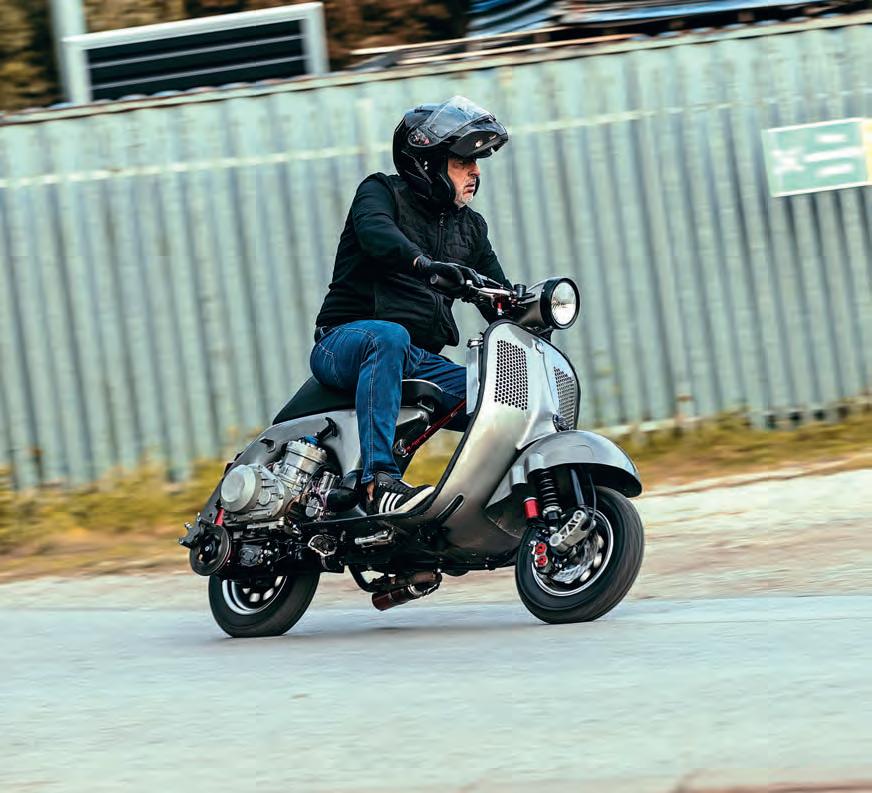
Paintwork by: Tony Haigh, Pontefract. Powder coating by: LSN, Castleford. Hardest part of the project: Finding the time!
Tech tip or advice for anyone starting a project: Just have a go and remember you’re building it for yourself and no one else.
Thanks to: My long-suffering wife, Maria (building a special is a massive drain on time) and my pal, Ian Harrison at Viper Racing UK, Oldham.
If you’re wondering what a Vespa fitted with 46bhp, 125cc kart engine sounds like, wonder no more. Just follow this link and bask in the glory that is Mark’s creation.
https://www.scootering.com/what-happens-when-an-italianshopping-bike-meets-an-italian-racing-go-kart/.
Airbox manages induction noise.
Squint and it looks like a Vespa lump.
....it doesn’t cruise, the power is either on or off. Frankly, it’s a handful and rides like a pig!
| SCOOTERING | JANUARY
Stoned Dear Stan, I hope you have a great time as editor!!
My name’s Dave Evans and I’m over 70 now. I’ve never been without a scooter since my first LD in ‘66, and have been writing short stories for a while. I don’t know if they are of interest, I attach one with a picture taken on July 5, 1969 showing us all busy on our scoots. Cliffo is the sad one in the middle with his bike on its side just before he sheared the hub bolt!!
Best regards Dave Evans
It all started well, Cliffo and I had finished work at The Mercury Block Co at around 4pm on the Friday. It was a crappy job loading hoppers all day to make cinder blocks, good for the figure anyway! We’d decided to go to Hyde Park the next day, July 6, to see the free Stones concert. It had all been a bit of a downer after Brian Jones had been found dead but they were going to do the gig anyway.
We fired up our scooters and drove to my mum’s in Dorking for some grub. Arriving about six, Cliffo decided to change the back wheel for the spare because it was a bit threadbare and we were going up the Smoke.
In those late 60s days any youth on two wheels was fair game for stopping by the Old Bill, be it scooters or bikes. They’d always find something wrong even if it was just our attitude!

Anyway, in the process of getting the wheel off, Cliffo sheared one of the wheel studs. Bloody annoying as we had a spare hub but back in Essex. He wouldn’t ride it with one missing. Bah!
Next morning bright and early, we both jumped on my TV200 and headed for the bright lights of the big city. It was a fairly good journey, the sun was already out, and it was nice and warm. As we were tootling through Tooting, near the hospital, we heard the dreaded rumbling of big 650s. About five greasers pulled out of St George’s and lined up behind us. Nobody could go fast on those roads, but on a Lambretta with too many lights there was no way of escaping. They rumbled along behind us, occasionally coming alongside and making kicking motions at us. This went on all the way to Clapham Common; I can’t say we were terrified, but we were definitely uncomfortable!
I knew there was a tea wagon on the common, so I decided to pull over as there’d be a lot of people about. You can imagine our joy as we shot a left up The
Avenue and into Windmill to see about 30 scooter boys parked up and taking tea. As we came to a halt the greasers realised their folly and began to turn in the road, one guy got his foot caught under the bike and over he went! His mates all sped off as the tea drinkers, yelling and hooting, ran towards the stricken biker trying desperately to right his bike. It was a Saturday, it was sunny, it was a great life we were living, we just surrounded him and threw tea and coffee over him, probably 20 or so cups. He was drenched, and no doubt sticky as he eventually got his bike going again and sped off with our laughter ringing in his ears.
A quick cuppa and then Cliffo and I recommenced our journey, joined by two other scooters whose riders were heading the same way. Feeling sharper than ever we rode over Vauxhall bridge and up into Mayfair. Because of our delay in Clapham, the concert had already started. It was so loud you could hear it as we rode up Knightsbridge, brilliant. We parked in The Gore and headed over to Hyde Park, listening to the sound of King Crimson who were supporting The Stones.
What a fantastic day, and we did make our way back to Essex and repaired the hub eventually!
MAILBOX SPECIAL Letters&emails&correspondence&questions&personals&thank-yous&comments&more Feedback, Scootering magazine, PO Box 99, Horncastle, Lincs LN9 6LZ or feedback@scootering.com
About five greasers pulled out of St George’s and lined up behind us. Nobody could go fast on those roads, but on a Lambretta with too many lights there was no way of escaping.
| scootering | JANUARY


WWW.scootering.COM |
Vulcan SC, 35 years young.
Vive la difference
It’s 35 years since the Vulcan Scooter Club was founded and this great Gallic institution celebrated at the Perpignan Custom Show International We sent our not-so-cultural attaché, Brad, to join them.
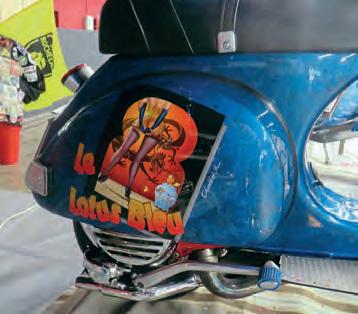



There can be few more pleasant surroundings than Perpignan to close off the summer riding season. Only eight miles inland from the Mediterranean and around 20 miles north of the Spanish border, its climate and surrounding countryside make it perfect scootering country. As the last major French city before the Pyrenees it’s also known as ‘the gateway to Iberia’ and as such is a more than suitable location for the annual Perpignan Custom Show International.
Held in the Parc Expo on the city’s outskirts, this custom scooter show is part of a much larger event which attracts entries from both France and further afield. Nestled against a display of historic army vehicles and with its own stage area, it was the perfect backdrop for the Vulcan Scooter Club’s 35th anniversary party.
Subtle, let
The censor
Down Town
Those who’ve never attended a continental custom show can be forgiven for thinking that they mirror their British equivalents but the differences are many and subtle. The trophy categories may be similar, but I can’t remember the last time I saw a ‘sexy scooter wash’ at a British rally. Before any reader cries ‘objectification’ we must point out that this was very much an equal opportunities event…
Taking a much deserved Best of Show was a former Scootering feature scooter, Dropkick Murphys, while other notable exhibits included a selection of street sleeper racers and a trio of very tidy choppers If evidence was required that the French like to do things differently, Ormotors had brought a pair of Down Town Custom replicas down from Paris While the world isn’t short of DTC tributes, what makes Ormotors’ effort notable is that their tribute is based on a Royal Enfield Continental
Within the trade fair were a number of club displays, with Riquet’s SC producing a nice variation of the ‘barn find’ theme. Of course no French scooter rally is complete without some celebratory alcohol and at Perpignan, Scooter Club du Sud-Est were pleased to offer some wine that had been specially bottled to promote the Mormoiron Rally.
With the trophies distributed there was little else to do but take a taxi into the old town and make the most of the local hospitality. While continental rallies have a flavour of their own, some things always remain the same
Words: Stan
Images: Brad
it sink in.
won’t allow us to show more of this paint job…. | SCOOTERING | JANUARY
Something for everyone...
The trophy categories may be similar, but I can’t remember the last time I saw a ‘sexy scooter wash’ at a British rally.


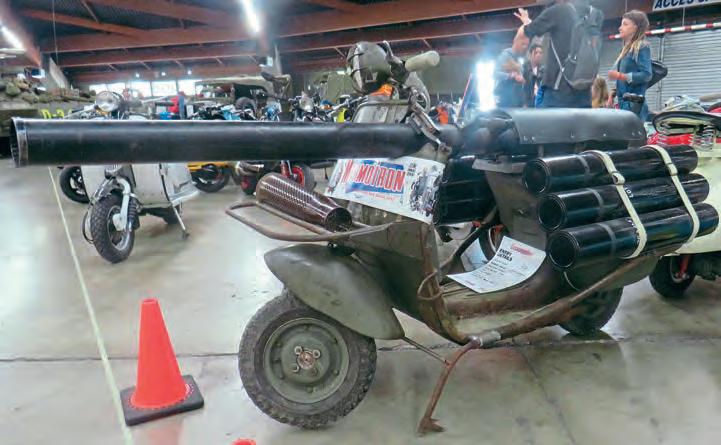


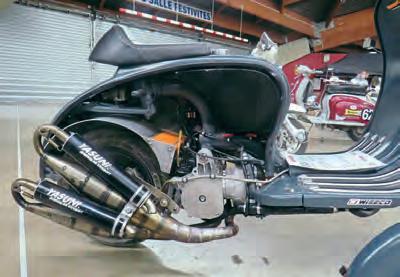
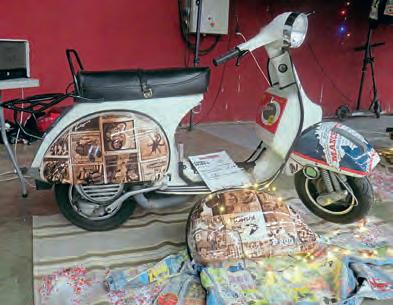

Tanks for the invite (sorry!).
 DTC with a difference.
A whole new world for patch collectors.
Series 2 meets Italjet Formula 125.
DTC with a difference.
A whole new world for patch collectors.
Series 2 meets Italjet Formula 125.
WWW.SCOOTERING.COM |




Riquet’s Rustic Repose. CUSTOM SHOW RESULTS • Best of Show: Ronan Danic (Lambretta Dropkick Murphys) • Best Vespa: Laurent Aron • Best Lambretta: Seb Lam • Best Custom: Ricky Lambretta • Best Paint: Orion Porta • Best Racer: Stephan Hass • Best Restoration: Laurent Cretin • Best Engineering: Laurent Berdejo • Best Custom Traveller: Pascal de Sete • Best Rats: Henry Mouries • Best Club: SC du Sud-Est • Best Animation: Sophie Kicking Girl • Best Engraving: Eddy Morera • Best Original Paint: Guillaume Roy • Best Chopper: Fabrice Siegel • Best Mod: Jean-Baptiste Miralles • Best DJ: Paddy A well deserved Best of Show for Dropkick Murphys. Mormoiron 2022 anyone? We get everywhere. | SCOOTERING | JANUARY
Brad’s last build
All good things must come to an end and Mark ‘Brad’ Brough, author of Time Trouble and Money, has decided that it’s time to call it a day
Back in the mid Seventies, Lambrettas were really old news and no one apart from a strange group of enthusiasts wanted anything to do with them. They didn’t really have any value and as commuters moved on to cars it was possible to find any number of neglected scooters hidden away in sheds and garages
The blue collar town of Scunthorpe was no different to this rule but it did have a handful of youngsters (as they were then) who kept the light shining, picking up scooters that were in danger of being scrapped for pennies. This led to a situation where parts were generally easy to come by, swapping scooters and parts was common and no one would dream of asking £150 for a tatty set of legshields This was the environment that Brad grew up in; scooters came and went, usually SX or GP models, and they were built
as the owner saw fit The idea of a ‘custom’ scooter, in the sense we think of them now, was an alien concept Tidy scooters were created, enjoyed and then passed on to make room for the next project.
Scunthorpe style
The healthy number of scooters to be found in the area has led to it producing several notable scooters, many of which have come from the ranks of Silhouettes SC, a Lambretta-only club that has existed almost since time immemorial. As these scooters were always intended to be ridden, they developed in a style that was peculiar to Scunthorpe Fundamentally practical and rideable, with clean lines, smart paint and the bare minimum of parts intended for show. The paint may have been influenced by race styling but these shouldn’t be confused with race replicas. It’s a simple
but effective look and few people are more associated with the style than Mark Brough, or Brad to his mates.
A scooterist in the mid Seventies, Brad (along with many others in the area) built a series of scooters that helped shape and define this style His best-known machine was probably the still fondly remembered Time Trouble and Money, a scooter that lent its name to what is widely recognised as being the best book on the early days of the Scooterboy scene.

In the mid Eighties, Brad wandered off into the rave scene, developing a passion for dancing in fields at illegal parties and being chased around the countryside by the police When you phrase it like that, and look at scooter rallies of the same era, you can see that not much changed for him really!
A conversation with a friend some years later brought him back into the fold.
Brad in his best mail order catalogue pose.
| SCOOTERING | JANUARY
OWNER DETAILS
Name: Mark ‘Brad’ Brough.
Job: Retired steelworker.
Scooter club & town: Silhouettes SC (Scunthorpe).
How and when did you first become interested in scooters: 1973-74, a few local scooter lads on our estate grabbed my attention when dossing around the streets as a 14-15-year-old.

Any stories: Too many! Buy a copy of my book for details.
If you had to recommend one scooter part or item of riding kit what would it be: A decent plug spanner and a Snetterton are must-haves. A fivespeed gearbox is up there too.
What’s the most useless part you’ve ever bought for one of your scooters: A Wal Phillips fuel injector and a andard at!
In the mid Eighties, Brad wandered off into the rave scene, developing a passion for dancing in fields at illegal parties and being chased around the countryside by the police.
The iconic story of scooterboy life.
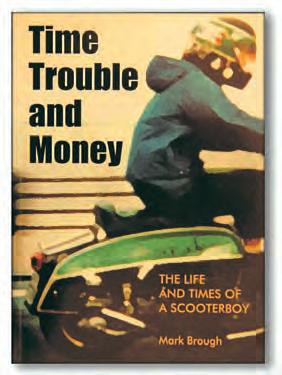



WWW.SCOOTERING.COM |
SCOOTER DETAILS

Name of scooter: Depends on which side you’re looking at! Shoot Speed, Kill Light is a blistering guitar track by Primal Scream, and apparently a veiled dodgy substance reference. Or Ecstasy, Passion & Pain which is another, similar reference but also a nod to my 80s scooter Time Trouble and Money. The reason is my love for the second summer of love, acid house music, and a time when people were ‘up for it.’
Scooter model: Lambretta GP150.

Inspiration for project: I wanted to do my final build using local businesses and at a minimum cost, Seventies style I used and upcycled all parts from my stash, apart from the seat. The colours are a homage to my old Cabaret Voltaire scooter and it was built in a proper Seventies manner using shit tools and no ramp Old style, bowing out with aching knees and back.
Time to build & by who: Built by me through lockdown. No rush there, eh?
Engine spec:
Kit: Ralph Saxelby ‘old skool’ TS1 225. Crank: AF Race.

Carb: Dell’Orto VHSB34, Flatslide. Exhaust: Original Taffspeed. Clutch: CamLam 6. Gearbox: GP200. Porting work by: Ralph Saxelby. Dyno done by: Don’t entertain them, sorry!
Paintwork & murals done by: Jonno Drayton, ex of Colourworx Paint, a local sprayer.
What was the hardest part of the project: Nothing. Old-school build using old parts meant no fettling, everything fitted without ‘adjustment’.
Do you have any advice or tech tips for anyone starting a project:
1) Don’t do it, it’ll only lead to another. 2) Get someone else to do it and stay out of the way.
3) If you insist on doing it, have faith, patience, and deep pockets.
Is there anyone you wish to thank: Jonno for the paint. Chas for the seat Lin at Retro Refits for the seat cover. Russ Thomas for giving me first dibs on the bike itself. Jez Hilton for selling the engine back to me for what I’d sold it to him for That’s proper mate’s rates. Everyone who I know or who knows me within the scene. It’s been a blast. Thank you all.
Questions were asked, deals were done, and Brad once again found himself riding Lambrettas. A string of builds followed, generally following the Scunthorpe style, culminating in what he considers his only ‘true’ custom scooter, a graffiti-themed GP called Tagged.
More builds followed, but eventually Brad came to the conclusion that he had only one scooter left in him, which eventually led to the GP that you see before you here. Bringing together the two strands of his life, Shoot Speed Kill Light/Ecstasy Passion & Pain will be his final custom.
Last of the line
Shoot Speed, Kill Light is both a blistering guitar track by Primal Scream and a veiled reference to certain chemical substances
The scooter’s alter ego is Ecstasy, Passion & Pain which is another, similar reference but also a nod back to the iconic Time Trouble and Money.
The base scooter was originally sourced for a mate on the basis that if it came up for sale Brad could have first refusal. It did and so the scooter ended up in his hands. Similarly, the engine now living in the frame was one that he’d sold to a friend some time earlier but was lurking unused. Brad paid what he’d let it go for. True mate’s rates.
True to the local style, it’s quite plain on first glance The detail doesn’t come instantly. The paint, applied by local painter Jonno, can look like a plain off-white in certain light conditions
It’s when the light catches the pearl that
it comes to life, playing on the eyes like an acid trip. Similarly, the Jackson Pollock/ Stone Roses paint ‘splashes’ scattered around the scooter come as a surprise when you first notice them. A tidy idea, and not overdone, and I suspect something we’ll see again.

Under the bodywork lies a tried and tested TS1 225, tuned by Ralph Saxelby, which is mated to an AF Race crank and CamLam 6 clutch. Fuel and air come in via a Dell’Orto VHSB34 Flatside, and leave by an original Taffspeed pipe once they’ve been used How fast is it? No idea. Brad doesn’t care. As long as it gets him to where he’s going, that’s quick enough.
What is surprising is that pretty much everything has either come from his stash of spares in the garage or is second-hand from mates. As far as he can think, the only new part is a length of fuel line….
Early in the build Brad decided that it was going to be a nod to his roots in more ways than one, and as a result was built through lockdown by the old method of working outside on a mattress with tools scattered around him, rather than on a workbench in a nicely organised garage. Perhaps taking the Seventies authenticity a touch too far?
In finishing, Brad wants to thank all the Scunny scooterists, both past and present, and everyone he’s met on the road for the memories.
As he said – It’s been a blast!
Words: Nik Images: Nik, ‘Brad’
| SCOOTERING | JANUARY
Best known as the author of Time Trouble and Money, Mark ‘Brad’ Brough has a superb portfolio of Lambretta builds to his name. Nik shows us the highlights.

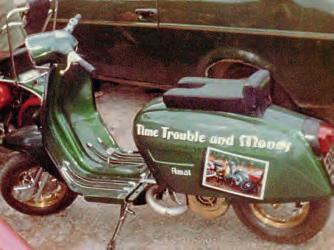


This was Brad’s first memorable build. Featuring a mixture of chrome and brass plating and a ‘rusty red’ paint job, it was typical of its time.
This was a rework of Dell’Orto Sprint, repainted in a style that gave more than a passing tribute to the old Leeds Central Race Team colours and named after the Sheffield electronic band.
Originally an AF Rayspeed Extra S Type, Brad ‘inherited’ the scooter from his brother after a crash and mimicked the original design as a tongue in cheek tribute.
Arguably the best known and most widely loved of Brad’s scooters, possibly due to it lending its name to Brad’s iconic book about the early 1980s scooter scene





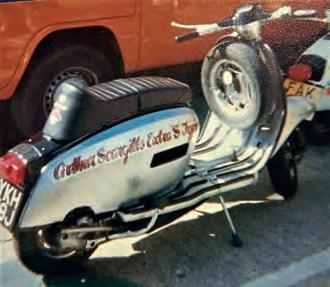
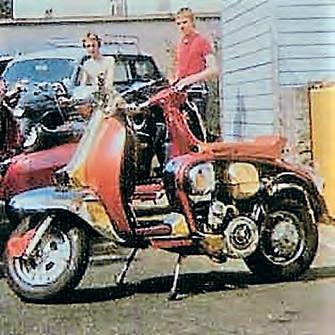
Below: Tagged remains the only scooter that Brad considers a ‘true’ custom. Its graffiti-based paint job was eye catching and marked Brad’s return to the scooter building world after a break of a few years.
Based on an original ochre DL200 that he picked up from a mate in the Midlands, this benefited from a simple paint scheme and an RB225 engine. Sadly, this was later stolen and burned out.
Left and above: As well as the scooter that has become Shoot Speed, Kill Light, Brad runs this Targa-powered GP which is regularly reworked with new graphics. A cost-effective way of keeping the simple paint up to date and fresh.
The first of his ‘known’ scooters. Dell’Orto Sprint was one of a twinned pair, the other being Dell’Orto Special, owned by Tony ‘Clog’ Clohsey. It came about after the original scooter, a tidy red GP200 Electronic was dropped on ice and needed a bit of tidying up.
WWW.SCOOTERING.COM |
P R ACTICAL SCOOTERIN G
MIND THE GAP TECH TIPS
It’s important to correctly shim a Lambretta gearbox and following this simple method makes the task much easier.
Before starting, make sure you have a selection of shims to hand.
There are many aspects of building a Lambretta engine that can be challenging, few more so than the gearbox The process of ‘shimming’ is often regarded as a dark art, but it doesn’t need to be. By going about the task in a methodical and careful fashion, the shimming process is easier than many think.
What is the correct shim?
One of the most asked questions about Lambretta gearbox assembly is: ‘What’s the correct thickness of shim required?’. The answer is there isn’t one, because all engines have different tolerances and until it’s measured there’s no way to know. It’s fair to say that Indian, Italian and Spanish casings have their own peculiarities and the
introduction of several aftermarket casings has made it even more difficult to suggest a baseline. There are a huge number of combinations that determine the correct gap including the type of layshaft, bearing and gear sets.
The tolerances involved are measured in fractions of a millimetre but it’s important to get it right. Too small a gap and the gearbox will lock up, too big and the gears will be loose, which can cause incorrect selection and jumping out of gear.

Before starting work, it’s important to have a selection of shims available Anyone who does this job regularly will have already amassed a good selection of sizes, but shim sets are available from most dealers. These not only provide a wide choice of fitments
but also have the measurement inscribed on them, making it much easier when it comes to fitting. It may seem wasteful buying a set of several shims when only one will be used but they’re not the most expensive part of a Lambretta build and they’re always useful to have around.
Preparing to measure the gap
Before any type of measurement’s attempted the layshaft must be pulled all the way in against the rear hub bearing. There are several tools available to do this but in their absence securely fitting the rear hub will suffice. The reason for doing this is because when it’s eventually fitted the rear hub will pull the shaft in slightly, meaning the shim will become loose
WWW.SCOOTERING.COM |
Use a tool to pull the layshaft towards the rear wheel bearing. The same result can be achieved by fitting the hub.
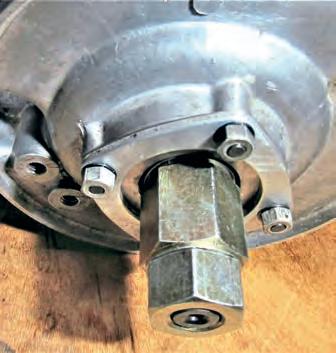
Once the end plate is fitted and secure, measure the gap between the shim and the endplate. Don’t go any lower than 0.08mm as that is the minimum gap requirement.
With the layshaft pulled in it’s time to fit a shim on to the top of first gear. The variation of shim thickness on a normal casing can be anything from 1.4mm up to 3mm in extreme cases but as a benchmark start with a 2mm shim Once in place put the endplate in position and tap it gently around its edge allowing it to sit fully home If your engine is on its side the shim will stay in place while this is being carried out However, if the gearbox is being built while the engine is in the frame there is a tendency for it to come out of its recess In this case smear its surface with grease, this will act as a ‘glue’ and temporarily hold it in place.
Once the endplate is in place, secure all six of the 7mm studs with their respective nuts. It’s now possible to take a measurement but before doing so gently try to turn the gearbox If it’s locked solid then a much thinner shim is required If it turns over, but there is some resistance, the shim only needs to be slightly thinner. If there is excessive play, the shim size needs to go up significantly The accepted gap limit is 0.08mm up to 0.3mm, a happy medium of 0.15mm being perfect.
Actual measurement
With a shim in place and the gears turning over it’s time to make a measurement. Take a feeler gauge and place the 0.08mm measure between the shim and the endplate. If this won’t fit, the gap is too small and a different shim is required. To take the measurement keep going up in gauge sizes until one sits in place with no movement. If you are in the desired range fine, but if the gap is too big then go up a size on the shim

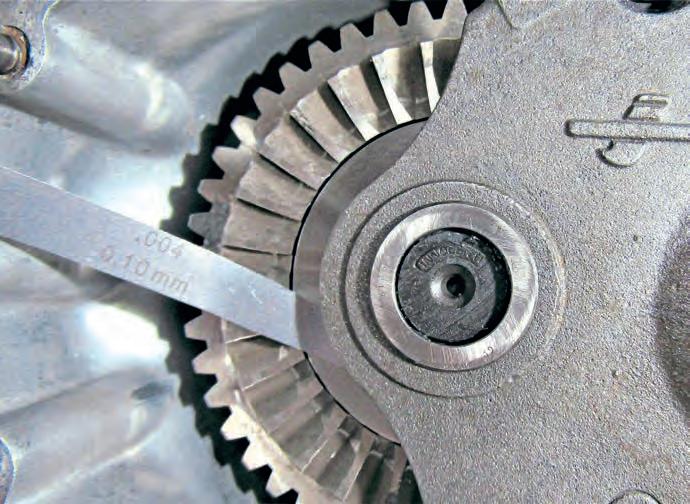

Keep going up on the feeler gauge measurement until it is a tight fit, making sure not to go past 0.3mm, which is the maximum tolerance.
Fortunately it’s fairly straightforward to work out what shim’s required to get the correct gap. As an example, if the shim fitted is 2mm thick and there is a gap on the feeler gauge of 0.4mm, going up to a 2.2mm shim should see a gap of 0.2mm and be within the accepted range. The reason for using maths rather than trial and error is that to change the shim the endplate
TECH TIPS P R ACTICAL SCOOTERIN G
Place a shim on the end of the recess of the first gear cog.
| SCOOTERING | JANUARY
MORE INFO?
Stuart Owen is the author of the acclaimed Lambretta history and maintainance series of books. For more details on a full Lambretta gearbox build including shimming,The Workshop Guide to Restoring Your Lambretta – Part 2 has an in-depth description with plenty of full colour images. Copies can be purchased through the Amazon platform.
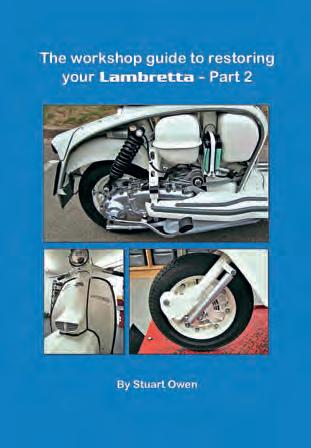
When fitting the endplate, tap it gently around its edge so it sits correctly
has to be extracted, a new shim fitted and then the endplate neds to be tightened down. Guesswork means this painful procedure will need to be repeated. Not only is this a pain, the constant loosening and tightening increases the chances of stripping a thread which causes another problem.
Be patient
The golden rule is to be patient when carrying out this procedure, even if it takes several attempts to get right. Don’t get annoyed and pull the endplate off without the correct tools or overtighten the nuts because frustration sets in. If the gap measurement is nearly there, but not quite
right, don’t settle for it. Have a brew and come back with a fresh mind
Signing off
When the measurement is acceptable it’s time to finish everything off. The most important things to look out for are the two endplate dowels that locate into the casing. Because the endplate may have been removed several times the dowels can fall out and it is imperative that they are in place. If not, the endplate will come loose regardless of how tight you secure it. Confirm that both dowels are in place and then tighten all six studs on the endplate securely.
As a final check, it should be possible
to rotate the shim because there is a small gap. It should also be possible to place a finger on the edge of the first gear cog and rock it back and forth Though there will be fractional movement it won’t be excessive because you have shimmed it correctly
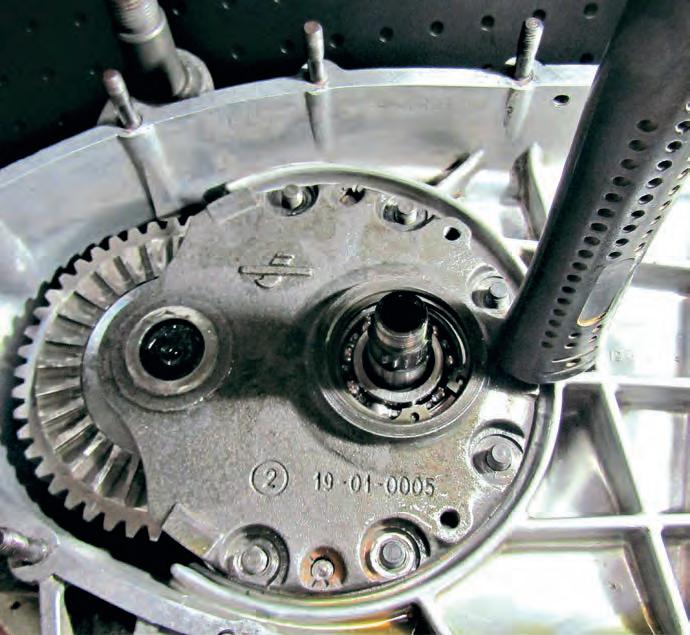

Remember once this job’s done and finished the rest of the engine build can be completed safe in the knowledge that nothing can alter and your gearbox will be working efficiently for many miles to come

Words: Stuart Owen
Images: Gary Thacker
When fitting the endplate for the final time make sure the two locating dowels are in place. Without them, the gearbox endplate will come loose over time.
Finally tighten all six studs securely to sign the job off.
TECH TIPS P R ACTICAL SCOOTERIN G
WWW.SCOOTERING.COM |
Steve Foster’s farewell.
End of an era! Mablethorpe 2021



Movember challenge and an out-of-season seaside town?
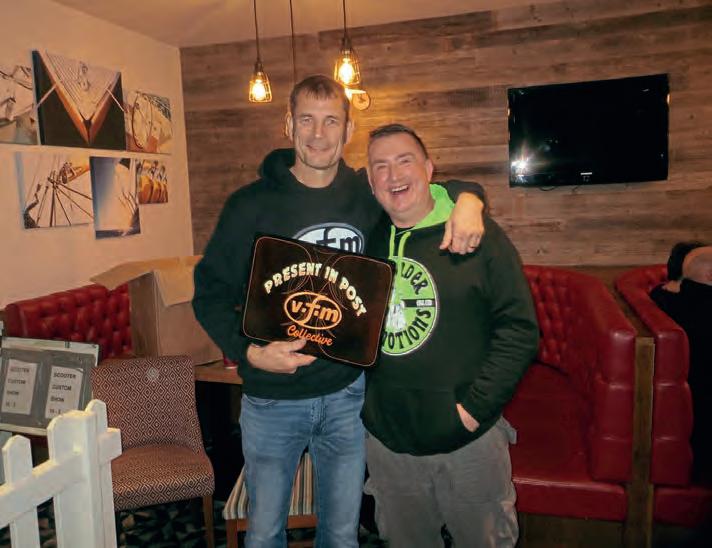
They may not be everybody’s idea of nirvana, but for VFM’s yearly finale, they’re perfect

After a cold but uneventful 160-odd mile spin up the highways and byways of eastern England, we were soon at the Haven Golden Sands camp, just to the north of the host town. As the chalets were released scooterists poured in and I’m pretty sure it was a sellout! Anyhow, after cranking up the central heating, securing our rides and donning more suitable attire we ventured into the complex. We were met by a cheeky
welcome from Big G, and once wristbanded and flyered up it was over to the bar VFM had taken over the internal sound system so related tunes were pumped throughout the venue. After several years the rally set-up is pretty much prearranged and sorted. There are three main rooms, upper Soul Room, Dr Kitch’s Boss Tunes in the arrival bar and the usual suspects and live acts in the large function room The latter also doubles up as the parts fair on the Saturday daytime
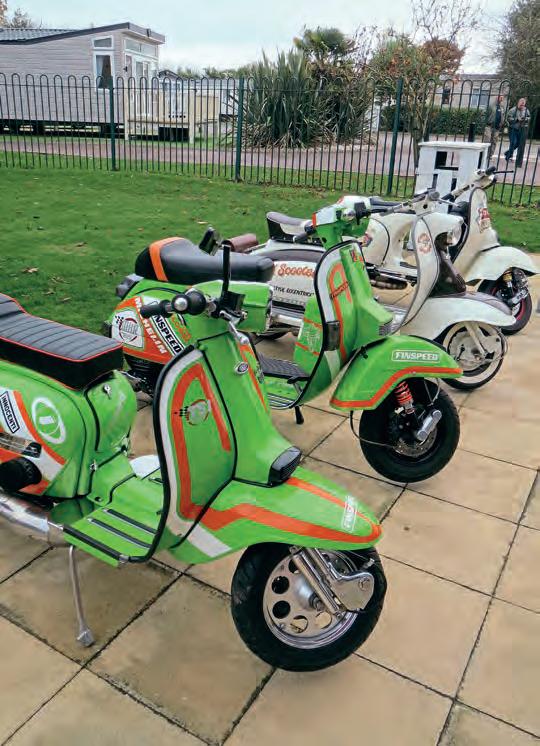
| SCOOTERING | JANUARY
Lest we forget
On Remembrance Sunday, Scooterists across the country show their respects. This year Stan joined the Wasps of London SC on their ride of Remembrance.




There’s no correct way to celebrate the act of remembrance. For some it’s an occasion for quiet, solitary reflection, while generations of squaddies will remember it rather fuzzily as ‘Drunken Sunday’. For the past 13 years Wasps of London SC has taken its own slant on the day by organising what’s become London’s largest scooter rideout. Like most scooter-related events it’s had its peaks and troughs and although attendance has now settled at around the 300 mark, in its heyday the event attracted in excess of a thousand riders.
Although I’m very much a ‘northern lad’, one of my dirty secrets is that I worked in London for a while, and I quite like the place. However, despite having flitted around its streets for a couple of years, I’ve never actually ridden through the centre. With my trusty southern chum Brad offering to act as guide, the Wasps’ rideout seemed like the perfect opportunity to put that right.
Milk and memorial
In some ways the rideout is a victim of its own success and thanks to an uncooperative attitude by the powers that be, the rideout now assembles at Eel Brook Common. Although of no significance to
Remembrance Sunday, the site has access to plenty of parking and a lovely little coffee shop. Brad will tell you to get your order in before the milk runs out though, as it’s fair to say that he hasn’t been converted to the joys of a soya milk latte.
After observing the two minutes’ silence there was just enough time for more soya milk before the rideout assembled and made its way along the marshalled route.
| SCOOTERING | JANUARY
Although there were no road closures in place the group managed to hold itself together, winding through Chelsea and on to Hyde Park.

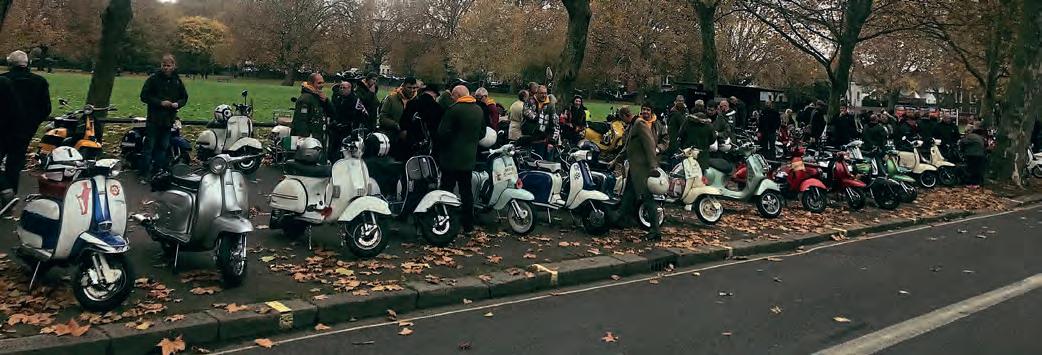
Here I said my farewells while the majority went on to lay wreaths at the Hyde Park Memorial. The day was rounded off with an afternoon charity fundraiser and auction at the Hercules Pub in Lambeth.
Fun and fundraising
Although the Wasps are predominantly a Mod Scooter Club, this was a very inclusive event There were plenty of autos, some very tidy street racers and whether Mod or modified many of the ridden scooters were more than capable of stealing a show trophy or two

Having split away from the main group I went on to scratch my Central London itch, riding along The Strand, through Piccadilly Circus and past the Tower of London. My PX and I may have been the ultimate tourists, but it was certainly memorable.
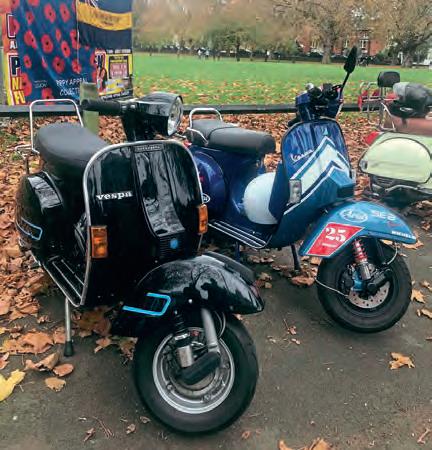


In many ways this is a rideout that happens to take place on Remembrance Sunday, but in one very important respect it isn’t and that’s the fundraising aspect Each year the auction raises money for the Royal British Legion. Last year, even though the rideout was cancelled due to Covid, the fundraiser went online and raised more than £9000 Over its 13-year history the London rideout has raised a small fortune to help veterans and their families Quite honestly, I can’t think of many better ways to spend Remembrance Sunday.
Words: Stan/Wasps of London SC
Images: Stan/Wasps of London SC
Over its 13-year history the London rideout has raised a small fortune to help veterans and their families
THE WILD BUNCH(ofFive)
There’s no doubt that Lee Palethorpe loves a smallframe. he just likes to enjoy them on his own terms
It was back in 1983 as a 17-year-old that Lee bought his first scooter, a 125cc 1968 Douglas Vespa, and it was this smallframe that ignited his love of the diminutive scooters. During his younger years Lee owned and rode a P Range or two, and, along with his mates, would religiously attend the National rallies
Since then Lee’s rarely been without a
scooter and although he’s now much less active in ‘the scene’, he’s still very much a part of the scootering world
Around five years ago, quite unintentionally, Lee found himself building what’s become a tidy but also very fluid collection of smallframes.
“For some reason quite a few of my mates, who had in the main been Vespa
riders, all seemed to be getting old Lambrettas,” he began. “I thought to myself, ‘I’m not going down that route.’ I found a smallframe, a green Vespa 90, with a Quattrini 144 and Egig Mamba curly pipe for sale at Vinos in Southampton. I’ve still got it and it’s a great little scooter, great to ride both around town and out on open roads. That wasn’t meant to be the start of

| SCOOTERING | JANUARY
anything but since then I’ve been buying smallframes, having a bit of fun riding them, maybe making a few changes, then selling one on to make room for another.
“I have self-imposed criteria that have to be met before I buy: they have to be of an age where they’re tax and MoT exempt, with a decent paint job and a nice engine. The beautiful thing about smallies is that there’s plenty of engine options, from standard 125, through 135, 136, 144 – even 200cc kits or engines. As things are I can’t buy another, I've not got the room I'm limiting myself to no more than five at any one time

“Rallies don’t really appeal to me, they were great in the 80s, these days I’ve got better uses I can put my spare time to than getting pissed. I do meet up with a few mates and go on local rideouts to places like Windsor, it’s a fun day or half-day out, get to enjoy a ride on one of my smallframes, and meet up with some other scooterists, talk scooters for a while and then ride home That suits me these days, I work hard and get to choose when I ride my scooters.”
To the uninitiated, uninformed and the
It’s a small world for Lee.
uninterested, Lee’s five smallframes appear to be very similar. Yet each of these smallies boasts significant differences both from how they rolled off Piaggio’s production line and from each other.

Each of them has a trick, tuned or
tweaked engine while the rest have other upgrades or non-stock changes too. In many ways it’s less of a collection and more an exploration of what a smallframe can be. Most importantly each of them is ridden and they’re ridden on Lee’s own terms.
As things are I can’t buy another, I’ve not got the room. I’m limiting myself to no more than five at any one time.
Do you havea collection to share? If so we’dlove to hear from you.Drop Stan a line at stan@scootering.com and we’ll take it from there.
WWW.SCOOTERING.COM |
CUTE QUATTRINI
The scooter which began Lee’s collection was this V90 with a Quattrini 144 engine, complete with a 28mm Keihin carb, Falc clutch and Egig Mamba exhaust. “If really pushed to make a choice, today I’d say this is my favourite of the five. It’s good to ride in town and on open roads, but ask me another day and I’ll probably have a different answer.”
ROYAL FLUSH
Having restrained himself for a year, his next acquisition was a green and silver V90 with a 125 motor, which he owned and rode for a while, treated to a new candy paint and then sold on. This was replaced with a royal blue Vespa 50 Special, which came with an ET3 125 engine and non-standard curly exhaust. During his period of ownership Lee’s had the paintwork professionally polished, giving it a deep shine.



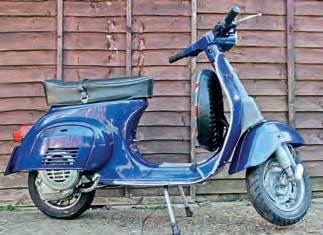








Kit: Quattrini 144

Keihin
Mamba
125
pipe
SCOOTER DETAILS Kit: ET3
Carb: Standard 19mm Exhaust: Curly
Clutch: Standard Gearbox: Four-speed SCOOTER DETAILS
Carb:
28mm Exhaust: Egig
Clutch: Falc Gearbox: Four-speed | SCOOTERING | JANUARY
The next real addition to his stable of smallies was his air force blue metallic Vespa 50 S, which has a D135 kit, a Polini exhaust and LED lights. Lee’s currently considering whether to have a few coats of lacquer blown over the paintwork to enhance the



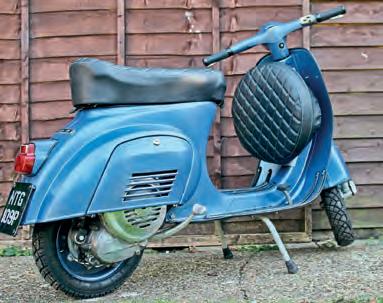


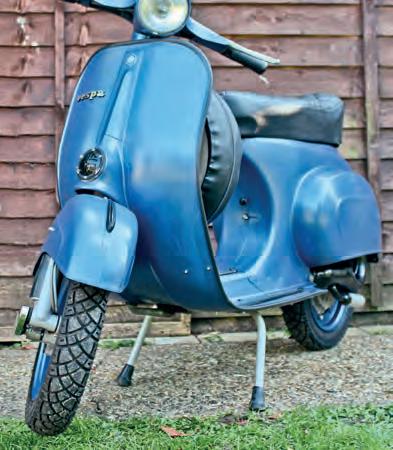
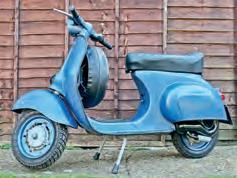
SCOOTER DETAILS
Kit: DR135 Carb: 19mm Exhaust: Polini Clutch: Vespa 50 Special three plate Gearbox: Four-speed
HALF CUT OLD GLORY
In April 2021 Lee sourced this deep yellow Vespa 50 Special, which features an unusual halfsized legshield toolbox. As with all his smallies this too has a trick engine, in this case Malossi 135 kit, 24mm Dell’Orto carb and Simonini box. It was beautifully constructed by David Payne at Small Wheels in Wales.


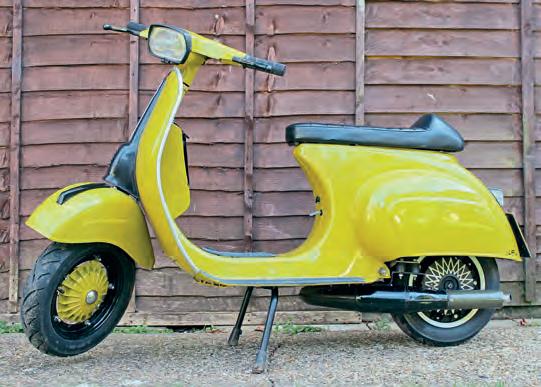
SCOOTER DETAILS
Kit: 135 Malossi reverse barrel Carb: 24mm Dell’Orto Exhaust: Simonini Gearbox: Four-speed
The most recent addition to Lee’s collection is a yellow patinated Vespa 50 Special. The patina effect was created by Lee himself. The engine benefits from a Malossi 135 top end kit, SIP racing crankshaft, PK race spec clutch, 26mm VHST carb and a Simonini pipe.


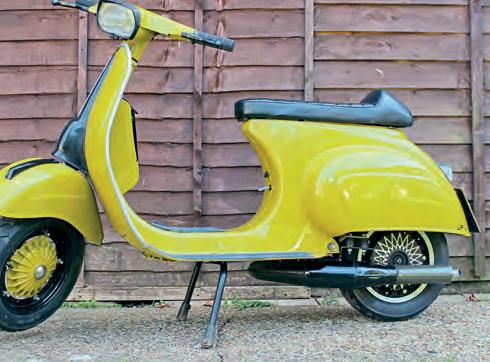
SCOOTER DETAILS
Kit: 135 Malossi Crank: SIP race Carb: VHST 26mm Exhaust: Simonini Clutch: PK race
BLUE TWO
WWW.SCOOTERING.COM |
Red Champion

The tale of a unique red (and sometime black) Vespa GS160 and its attentive owner.
The industrialist and inventor, Henry Ford, is famously quoted as saying on the subject of his best-selling Model T Ford: “Any customer can have a car painted any colour that he wants so long as it’s black.”
There is a possibility that the Piaggio Company might well have paraphrased this comment with reference to the Vespa GS160 as in: “Any customer can have a GS160 painted any colour as long as it’s white.” But in Italian, of course (to be strictly accurate) the beautiful newly minted GS was adorned in the Pontedera factory with paintwork that was Grey White (Bianco Grigio), or in the UK importer’s Douglas Vespa terminology –Tuscan White; and, to be honest, the GS160 looks gorgeous in this pristine colour. But it has been said that it would be a boring world if every GS was this colour and almost from the word ‘Go’, enterprising owners often had their two-wheeled chargers resprayed in a colour choice to suit themselves; in fact, they possibly had little choice following an accident or a minor scrape.
FRANK OCKENDEN AND HIS GS160
Frank Ockenden’s first Vespa was a green Sportique. His brother Patrick, also a Vespa enthusiast, purchased a red one.
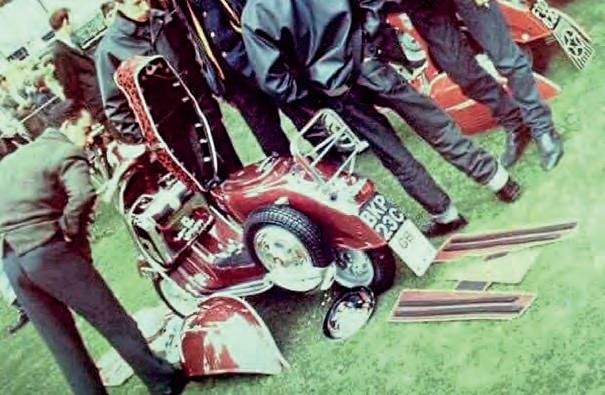
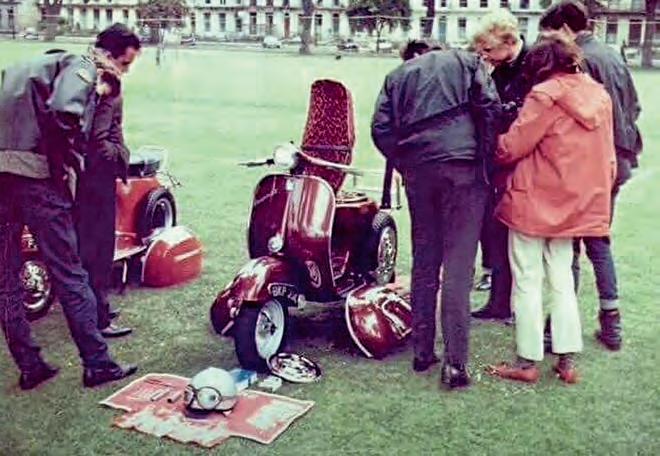
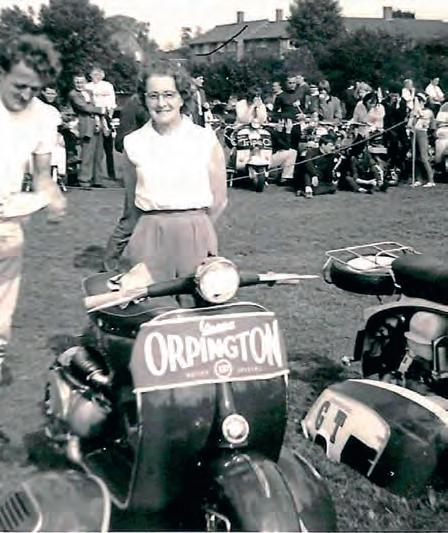

There is some great history surrounding Frank’s later purchase of a GS160 (BKP 23C) as this scooter went through a few colour changes and additions in its life and was more than once a concours show winner. In its first non-standard colour scheme of black, Frank rode the GS to the national rally on the Isle of Man. Unfortunately, while competing on his GS in the Night Trial, he had a serious
accident with a car and spent a month in hospital on the island where he was operated on and ended up being fitted with a metal plate to the bone in his leg. The accident resulted in Frank having a permanent limp for the rest of his life.
WWW.CLASSICSCOOTERIST.COM114 CAMPIONE ROSSO
Alternative view of Frank’s red GS.
Frank can be seen on the left of the picture .
“Some of the small details feature Frank’s fitting of a chrome wheel accessory trim to the spare wheel that has a highly polished tyre and the ‘half-moon’ spare wheel cover that has been chrome plated.”
It must have been some consolation to the injured Frank when Douglas Vespa in the UK transported his machine back to the mainland, repaired it and delivered it back to Percy’s shop, Fiveway Scooters, in Chislehurst Road, Orpington. Fiveway had the advantage of being close to Frank’s Kentish home of St Mary Cray. Percy’s shop (for those unfamiliar with this long-lost Vespa dealer) was tiny by any standards and could only hold up to three scooters and had a notoriety locally for being untidy.

Frank moved from Orpington VC to Bromley VC with his immaculate black GS, but he now decided his bike needed a facelift and had it sprayed in a deep metallic maroon which
looked fabulous. While it was being sprayed, Frank removed the engine and had the casing ground and polished until it looked just like chrome.
One story Bill Simmonds remembers was when he went to a National VCB rally in Torbay shortly after the new format, non-black and white number plates were announced. Not to be outdone by this new legislation, Frank matched the yellow and hand-painted and varnished a black and white number plate for the front of his GS and a black and yellow one for the rear. However, one keen-eyed policeman in Torquay spotted them and the result was that Frank was prosecuted because the home-made plates were not legal. Frank
hadn’t realised that it wasn’t the colour of the new plates that was the issue, it was the fact that the new ones were reflective!
This GS160 wasn’t Frank’s last foray into the world of the Vespa, as sometime later he purchased a Vespa SS90.


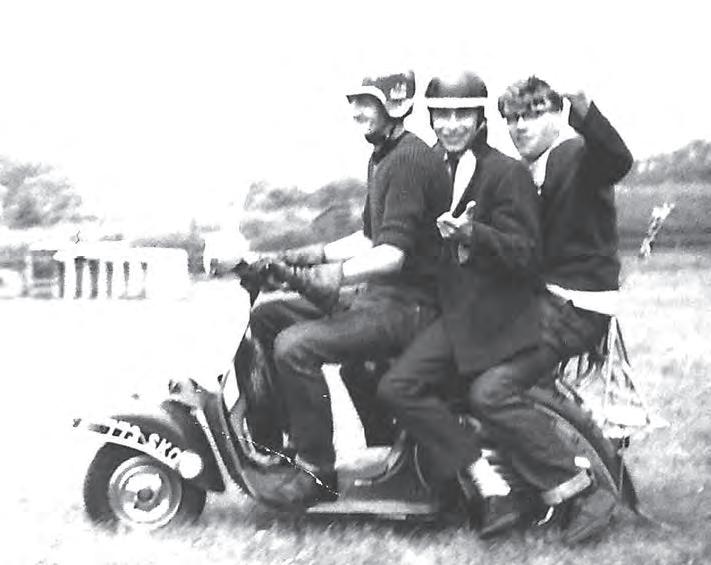
FRANK’S GS IN DETAIL

We are lucky to have a number of photographs of Frank and his GS, some being in the relatively rare colour format – quite expensive in the day. These are from the collections of Patrick Ockenden, Frank’s younger brother, and Frank’s best friend Bill Simmonds. From these images the various changes in colour and accessories of Frank’s GS are recorded. Some are quite striking, like the ‘faro basso’ or mudguard low light on the black painted version, and as fitted by Andre Baldet to his own ‘Mona’ GS160s of the same period.

115MAUSPENCER@CLASSICSCOOTERIST.COM
On Frank’s Sportique: Frank, Alan Cox and Johnny Evett.
This old newspaper pic shows Frank with some of his trophies.
Under the Bromley VC banner Frank wins concours at the Chelmsford Rally (note the low light).
In the news again…
The most striking of these are the concours d’elegance competition shots of the fabulous dark red painted example (concours awards were also given to the GS in black on other occasions) and serve as a tribute to Frank’s eye for detail, his good taste and great care in the realisation of the overall effect. This is far from the ‘everything but the kitchen sink’ accessorising often seen. Some of the small details feature Frank’s fitting of a chrome wheel accessory trim to the spare wheel that has a highly polished tyre and the ‘half-moon’ spare wheel cover that has been chrome plated. Also noteworthy is the fact that Frank has removed some of the trims
and body panels to allow extra scrutiny from the judges of parts otherwise hidden to the casual observer. Frank won one of these competitions at the Vespa International Rally held at Chigwell in Essex.

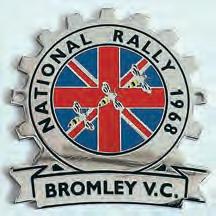
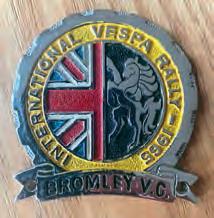


IN MEMORIAM
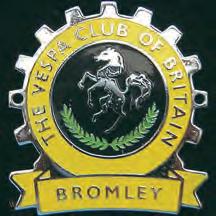
Sadly, Frank Ockenden passed away in 2002 and this feature marks 20 years since his death.
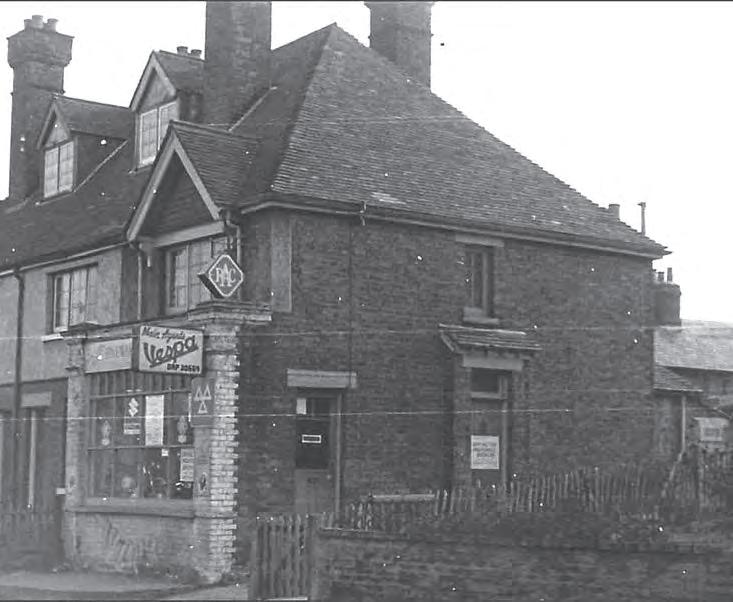
Vespista
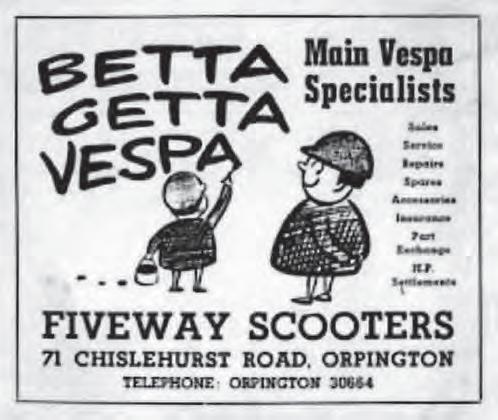
[Many thanks to Nick Tolley and Bill Simmonds for their help in both providing information and securing the images for this article.]

WWW.CLASSICSCOOTERIST.COM116 CAMPIONE ROSSO
Frank (centre) on his GS when it was paintedblack to the back of the frame.
Rear view of Frank’s red GS160.
Memories of Fiveway Scooters: A picture of the old premises alongside one of its period adverts.
A selection of Bromley Vespa Club cog badges from the 1960s and 70s.
Scorcha!
Skins, Suedes and style from the streets, 1967–1973
Authors: Paul ‘Smiler’ Anderson and Mark Baxter
Pages: 304
Publisher: Omnibus Press Publication date: 2021
9781785584930
As a follow-up to Mods: the New Religion, a title that was assumed to be Paul ‘Smiler’ Anderson’s definitive history on the subject, we now have Scorcha! – written this time in collaboration with Mark Baxter.
Despite the subheading to the title, this weighty book could be described as volume two in a series, as Scorcha! covers much the same ground historically as the previous ‘New Religion’ title as far as Modernism and the preceding UK youth movements are concerned, but featuring new information and graphics on those subjects.
Although some might have preconceived negative notions on the Skinhead movement, after digesting the very detailed testimony within the covers of this volume, most will lose all prejudicial ideas with regard to the notionally violent, racist beliefs surrounding this youth cult. In fact, this book rationalises with great objectivity the positive side of the Skinheads – repurposing and correcting the very negative contemporary tabloid press’s stark banner headlines and anti-youth biased views in their editorials of that period.
Focusing on the current ‘hot potato’ subject of racism, Scorcha! goes to great lengths to reinforce the nearly forgotten facts regarding the merging of the styles and influences, both musically and sartorially, of the incoming immigrants from the Caribbean and the
contemporary youth movements of the time. This was always a ‘given’ with the ethos and camaraderie between the Mods and these relatively new UK citizens, but lost in the murky waters much muddied by the media in respect of the Skin/Suedeheads who were arguably just the next generation following on from the ‘Hard Mod’ subculture and far from the ultra-violent, bone-headed hooligans reported by the established press and TV.
One very telling anecdote in the book on the race hate theme refers to a group of Skinhead lads on their way to a football match who found their approach to the local train station being blocked by a gang of individuals from a far right political party who picked on the only black person in the Skinhead group. This unacceptable behaviour is quite rightly treated in a classic Dirty Harry ‘make my day’ retribution style with the fascistic perpetrators being left lying on the floor – instant karma.
In its layout, Scorcha! is very similar to that of the ‘New Religion’ majoring on personalised transcripts taken from interviews with individuals active within the varied movements of the time, or from observers of the same. Some of the contributors are notable in refusing to be pigeon-holed as one of a generic youth ‘tribe’ and prefer to be recorded as stylists in their own right. In fact (and not so wary of being stereotyped) there are a number of welcome contributions by a certain Paul Weller of Woking, as well as a foreword to the book from Suggs (11 years old in 1971), just to namedrop two of many contributors.
Subjects covered in detail include football, clothing, the clubs, the music, films and books – with an entire chapter reserved for the purely fictional, but very influential at the time, 18 books written by Richard Allen (aka
None of this stopped his first book selling a million copies and becoming the unofficial Skinhead handbook.
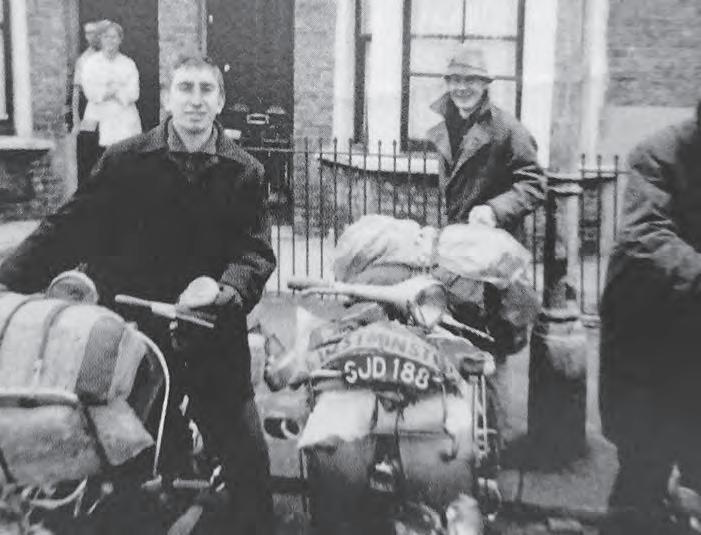
The contemporary picture count within the Scorcha! covers is vast and in the most part consists of previously unseen and evocative pictures including teenagers ‘dressed to impress’ for the football, posing alongside the inevitable scooters, or just candid, unposed snapshots – all absolutely dripping with period detail. Memorabilia, records labels, advertisements and flyers are added points of interest. Purely absorbing, the graphics within Scorcha! would involve weeks of study and their extent is a tribute to the scholarship of the authors, not to ignore their vast network of contacts who have donated these images to be put forward for publication.

As for the Scorcha! book title…
Possibly only those with a focus on the music themes of the period covered by Scorcha! are in on the secret that the word is in fact West Indian patois used in reggae lyrics and featured in at least one song title –Officially Scorcha.
A SAD FINALE…
It is with great sadness that, on completion of this review, we heard of the untimely passing away of Paul McEvoy whose skills in the design and layout for Scorcha!, Mods: the New Religion and the earlier Fleur de Lys work are so apparent. The artistry demonstrated in these eye-catching books will remain both a testament and a memorial to his lifetime’s work.
117MAUSPENCER@CLASSICSCOOTERIST.COM BOOK REVIEW
ISBN:
Price: £30
James Moffat), who – strangely enough – was a 48-year-old at the time of writing Skinhead and of Canadian birth.
Dave D
Although the GT looked good, the engine wasn’t. We decided to go to the August Bank Holiday three-day Festival of the Flower Children at Woburn Abbey; we were only interested in the ‘free love’ and managed to sneak in free (but no love). Remember, this was the Sixties (sex, drugs and rock and roll); I managed to get a fair amount of two out of the three (but won’t admit which two). One of my mates was on the back of my GT and on the way there, I left the others behind – but not on the way back, as they kept up. After passing my test, I rebuilt the GT but wasn’t happy with it. Then I spotted a dealer in Mill Street, Bedford (Glanfield Lawrence, below Pascal’s Coffee Bar) had a new Vespa SS180 in white with metallic pink flashes sitting in their window; I spent some time with my nose pressed up against it, wondering if I could afford it? Not sure how I did (more money on the drip I think) but on 02/01/1968, I collected this beauty, leaving the dealer with the GT. After the problems I’d had with the GT, I carefully ran in the SS. I kept it for a few years, but somehow ended up with a Series 2 Li150 as my only transport. It had two single seats, but the rear one had no cover, just rusty springs to sit on. When my then girlfriend (later my wife) wanted to sit on it, I’d stretch a woollen bobble hat over it (luxury; I knew how to treat a lady). We married in August 1971, hiring a Mini for the honeymoon (well, you have to splash out for these things). But the Li was our only transport, so the wife did the shopping using buses (not very convenient with bags of groceries, etc.). So a move to four wheels was on the cards.
THE BUG BITES AGAIN
Time moves on and around 2010, Bedford’s 60s Mods Reunited was formed and a number of social events were organised. I’d also been nursing a desire to get and rebuild a scoot as I’d have wanted it in the Sixties, but I didn’t have the funds at that time. A Lambretta Series 3 would have been my choice (the reunions did push me in this direction).
In June 2016, I took early retirement. Still thinking about the Series 3, I looked for a winter project and around October 2019, I attended the Wicksteed Parts Fair in Kettering. There was a pristine SX150 frame for many thousands of pounds, which set me back somewhat. It was almost 50 years since I’d had anything to do with scooters, so my knowledge and memory were questionable and I wandered around getting more confused. Then I noticed a guy unloading scoots from a van; among them was a blue/ white 1963 Series 3 Li150 for £1500. It was all there; the engine was free, it had compression and was quite tidy, although the paintwork wasn’t great.

The deal was done and he delivered it to my house later that afternoon.
My first job was getting it started; it had a good spark and after a few hours cleaning and fettling, I managed to fire it up using the existing Italian fuel in the tank. I test rode it and most things worked, but it was still a pig to start. I purchased Sticky’s ‘Spanners’ manual and started my rebuild keeping a running log of items purchased on a spreadsheet; the total cost was unbelievable and far higher than I’d envisaged.
Looking on Google I found a regular scooter painter – JC Paintwork of Oakley, Beds –complete with a menu of prices and a gallery of previously completed projects. I agreed a price with him and an estimated timescale; my plans had changed and I replaced my previous Candy Apple Red scheme with Rosso Carmen metallic. With the paintwork under way, it was time to start on the engine. With much cleaning and removal of crud from the gear casing, etc., I removed the cover and found the drive chain was slack with all adjustment fully used up, so a new chain, clutch and adjustable tensioner were required. I managed to obtain a first u/size piston and rings (the piston was manufactured by MAHLE albeit in India; on the packaging it stated that it was packed in July 1986, so it had been on the shelf for the best part of 34 years)! The engine was ready to go back in the frame but the frame and panels were still at the painters so a bit of a wait…
Come January 2020 I collected the frame, legshield, toolbox (chrome), headset (chrome), bars, front mudguard, rear boards, horncast and forks. A new stainless fuel tank, rear mudguard, wiring loom, new inner and outer cables, speedo drive and many other items were also purchased.
LET THE REBUILD COMMENCE
Following the ‘Spanners’ manual, the rebuild could begin, with wheel bearings replaced and a new Veloce digital speedometer installed (a good piece of kit I can thoroughly recommend).
119MAUSPENCER@CLASSICSCOOTERIST.COM
MAGICAL MOMENTS






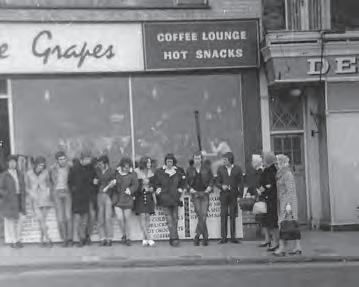


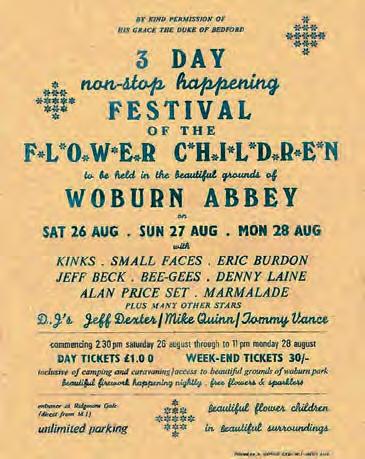

121MAUSPENCER@CLASSICSCOOTERIST.COM
A nostalgic event that is fondly remembered.
Margate (Easter 1968): I’m on the far right on my SS180. On the left is a ‘Steve Stringer Special’ complete with ape hangers; centre left is a Lambretta SX200 and centre right is another SS180.
My 1968 Vespa SS180.
Margate (Easter 1968): The opposition – a gang of Greasers.
Five of us with our scooters outside my mate’s house.
More Margate mayhem.

WWW.CLASSICSCOOTERIST.COM122 NEW JOURNEY FOR A GAINLY OLD GAL
Loads of life left in this old GAL yet!
There are many ways of preserving history – but the level of recorded details kept by the original owner of this Lambretta Cento takes that concept to a whole new level.



Our story opens on March 15, 2021, when Steve Fellows purchased a Lambretta Cento for £1000 from a local builder who was carrying out extensive restorations to a bungalow which had been owned by a family friend. The bungalow in question had been owned by a gentleman named Paul Jowett who lived there up until his death in 2019. The Lambretta Cento –GAL 57D – was originally purchased by Mr Jowett and as it turned out, it would appear that he had not only been a passionate scooter rider, but he was also a stickler for detail – not just in keeping details of the scooter’s history, but also of the memorable times he and his wife had riding the scooter – even to the point of keeping a record of all the journeys made, where to, how many miles and even the amount of fuel he had used (including cost)!
Mr Jowett’s love affair with his Cento began in Newark where he lived at the time. And having purchased the scooter brand-new from Northgate Garage in Newark, he and his wife carried out numerous runs on the scooter from his house on Farndon Road, Newark They later moved to Kirton, near Boston in Lincolnshire, before arriving at their final residence in Leasingham (where the scooter was discovered after his passing).
It’s not known exactly when Mr Jowett finally gave up riding the Cento, but it would appear that he used it as transport for a period of around 10 years; in that time, he had kept anything and everything remotely related to his scooter-riding experiences back in the day. And as we arrive back at March 15, 2021, when new owner Steve Fellows purchased the scooter, it also came not only with all the maintenance records and historical documents (including Mr Jowett’s original licence), but also with all his riding gear and the matching open face helmets that he and his wife had worn on their travels (I must say at this point, that looking at the heavyweight riding gear and imagining this being worn by the Jowetts while riding two-up, the weight that little Cento had to carry would have been phenomenal for its physical size – I can’t imagine the pace of the journeys was very fast!).
CURRENT OWNER:
Name: Steve Fellows.
Scooter club: Not affiliated to any club at present, but former member of Stateside Scooter Club (Grimsby/Cleethorpes)
1978-1982. Meeting at Seagull Cafe, Cleethorpes.
First interest in scooters: 1978, through friends I met at the Winter Gardens (Cleethorpes) during Northern Soul Alldayers.
First scooter: Lambretta GP200 purchased new from Robspeed in Cleethorpes (1978).
Favourite scooter style: The one I’m riding at the time.
Favourite custom scooter style: I liked the style of my GP once I’d striped it, chromed it and had a metalflake paint job.
First scooter rally: Brighton (May 17-21, 1979).
Best scooter rally: Rhyl (July 1979) as we stopped over at Wigan Casino for the night.
123MAUSPENCER@CLASSICSCOOTERIST.COM
The originality theme even continues under the seat with Mr Jowett’s original puncture repair kit and work rags…
REFURBISHMENT DETAILS

stator and flywheel
rebuild kit
pipe

STEVE TAKES UP THE STORY
“Having transported the scooter to my bungalow, I cleaned it, treated the surface rust spots, obtained a replacement key and registered her in my name. As a non-runner and having sat in a garage for 45 years without striking up, the old GAL then awaited the opportunity to be brought back to life by someone who had the knowledge and skills to do this work sympathetically, while retaining her originality.
“In June 2021, Rob Castle (founding member of the Sleaford All-Knighters SC) collected the scooter, as he’d kindly agreed to carry out the work necessary to bring the old GAL ‘back to life’. Later in the month, he sent me some pictures he’d taken of the scooter while in his garage; this was also accompanied by a short video showing the old GAL’s engine running, along with the comment ‘SHE LIVES’! Needless to say, I was elated. Rob has since replaced many essential parts, along with carrying out a full service of the

clutch corks
clutch springs
case gasket
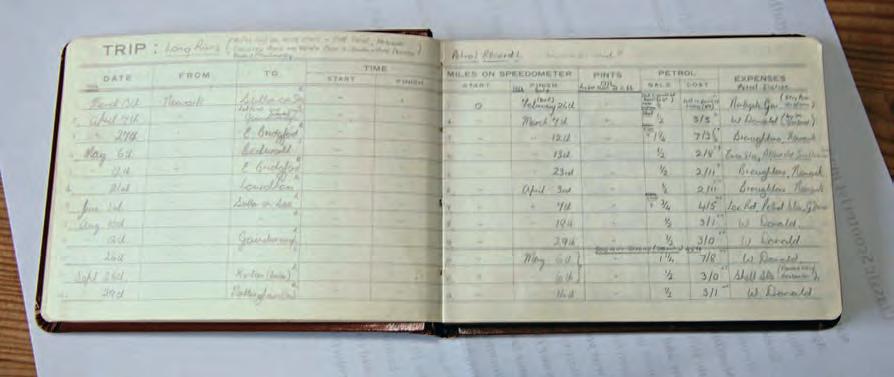

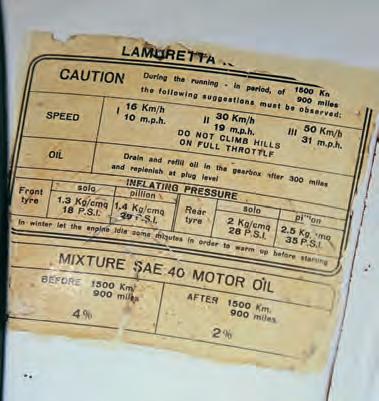

gearbox
Michelin
rear
cleaned and adjusted front
new kick-start pawl
and re-grease gear and clutch
and re-tap head cowl
clean fuel tank
air filter
fuel tap
Clubman exhaust (purchased with scooter)
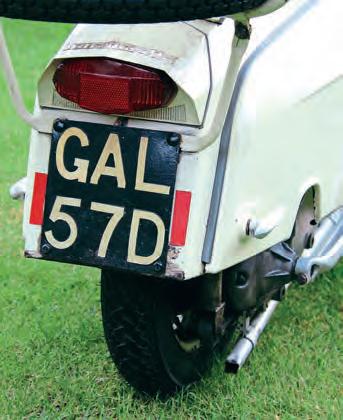
new rear bulb
and clutch cables replaced
NEW JOURNEY FOR A GAINLY OLD GAL
In memory of Paul Brook Jowett (March 10, 1938 to March 30, 2019).
Dealer plate showing original supplier.
The original riding gear that belonged to Mr Jowett came with the scooter.
Left: Mr Jowett’s original driving licence.
■ New
■ Crab
■ Fuel
■ Replacement
■ Replacement
■ Chain
■ ST90
oil ■ 2 x
S83 tyres ■ Stripped,
and
brakes ■ Fit
■ Clean
cables ■ Drill
■ Acid
■ Replaced
■ Replaced
■ Fitted
■ Fitted
■ Gear
The riding log containing intricate details of each trip.
GAL 57D HISTORICAL TIMELINE
■ Lambretta Innocenti ‘Cento’ 100 (J Range).



■ Produced in Italy at the Milan Lambretta factory during 1964.



■ Shipped to UK, then to Newark Northgate Garage and first registered for sale to Mr Paul Brook Jowett of 125 Farndon Road, Newark on February 23, 1966.
■ Scooter first insured on March 1, 1966 by Mr Jowett.
■ Last insurance document expired on March 1, 1976. It is thought that Mr Jowett may not have ridden the scooter after this date and the scooter was left in his garage at Leasingham, Lincs, laying untouched for 45 years.


■ Having been the owner from new, Mr Jowett passed away on March 30, 2019. Scooter, original helmets, waterproof riding suit and associated paperwork purchased by current owner on March 15, 2021. The inspiration was to maintain its originality.
A sneak look at some of the documentation that came with the scooter.
“Maintaining GAL’s originality is the most important aspect for me; It’s clear from the paperwork that the scooter was ridden for approximately 10 years by the owner from new. During this time, it was serviced and maintained; aside from a few light touches with a paint brush, the old GAL has been maintained in its original condition since it was purchased new in February 1966.”
GIVE STEVE AND THE OLD GAL A TOOT!
Now back on the road again, Steve uses the Cento as it was meant to be, if only for short or intermediate journeys in and around the Sleaford area – and he is enjoying every single minute he spends on the old GAL riding both solo and as part of a group (he’ll be the one at the back, trying to keep up with the others). If you see him, give him a toot!
Words/images: Mau
125MAUSPENCER@CLASSICSCOOTERIST.COM
“Maintaining GAL’s originality is the most important aspect for me...”
Steve’s nostalgic memories come flooding back

A personal collection of historical pictures consisting of the scooter runs; the people; the scooters; the memorable journeys; plus, newspaper cuttings of how the press portrayed scooterists during that period of time.
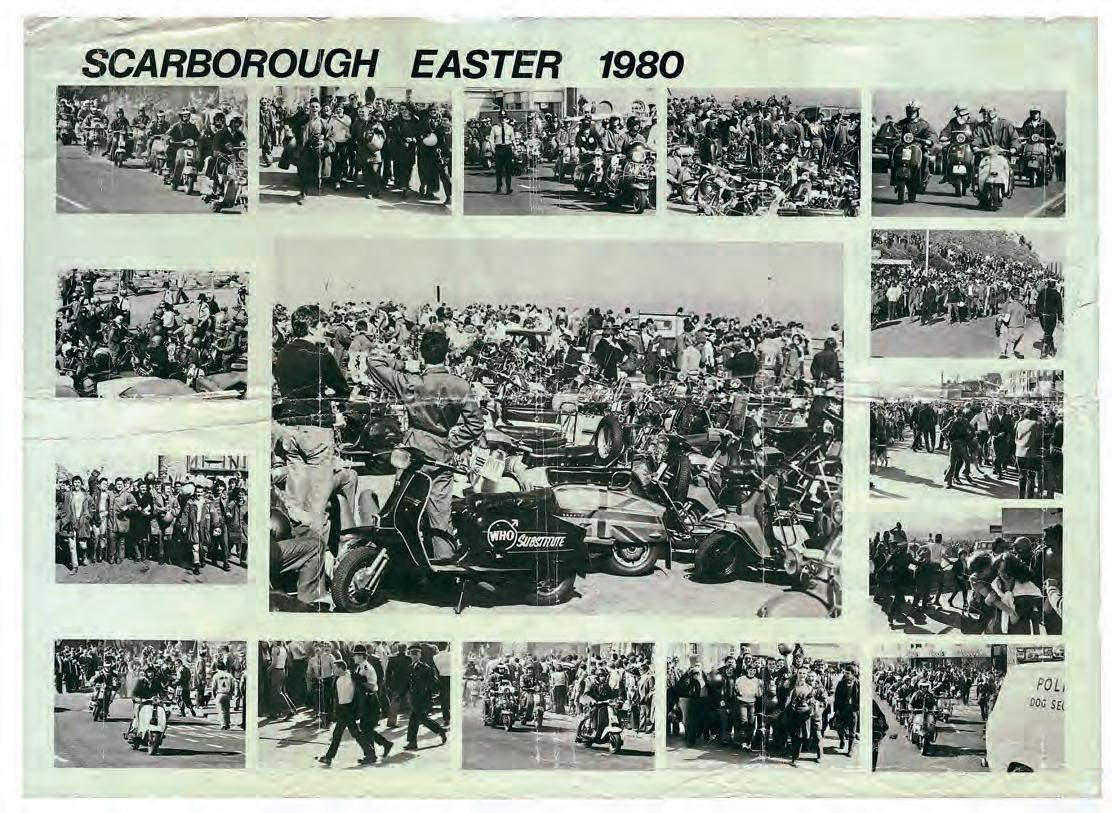
On the previous pages we told you about Steve Fellows’ latest acquisition, his Lambretta Cento; here, however, we reflect on his long association with, and his love of, all things surrounding scooters.
Back in the late 1970s and early 1980s, he was a member of Stateside SC, based in Grimsby. It proved to be a memorable period of time for him during his younger years; he also had the presence of mind to take photographs at a lot of the events he attended during that time (which would have been an expensive thing to do at that time, given the costs of developing, etc.).

Most of us have heard the phrase ‘a picture is worth a thousand words’ and here we take a look at a small selection from his vast collection of nostalgic images, which reflect a period of time that will never be repeated.
Words: Mau Images: Steve Fellows
WWW.CLASSICSCOOTERIST.COM126 THROUGH THE LENS
STATESIDE SCOOTER CLUB
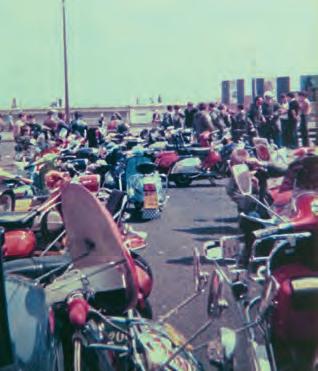



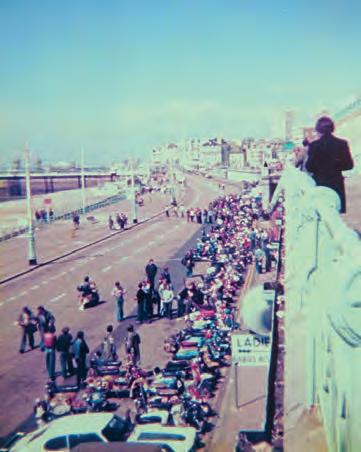



As previously mentioned, Steve was a member of Stateside SC who were based in the Grimsby/ Cleethorpes area. Club members were fairly well organised, even to the point of producing their own newsletter; topics often included news, advice and directions to rallies, plus snippets of technical advice.





127MAUSPENCER@CLASSICSCOOTERIST.COM
1979: GREAT YARMOUTH 1979: BRIGHTON


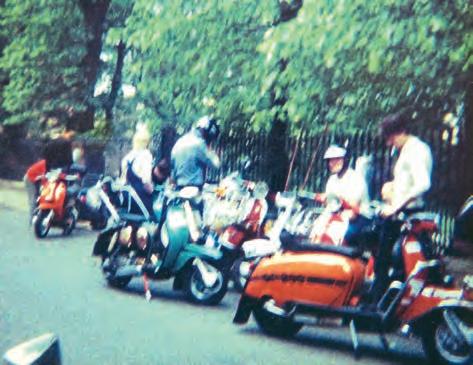

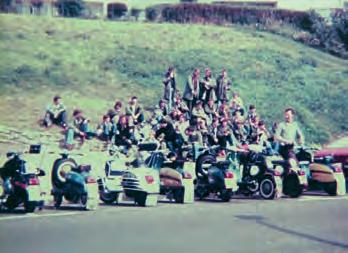
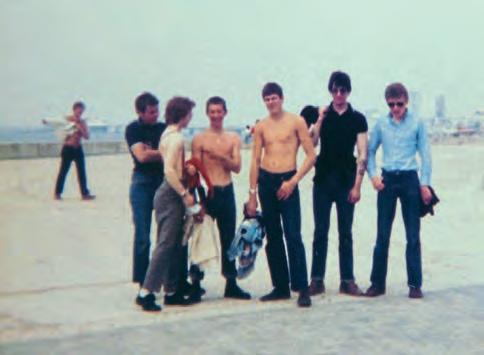







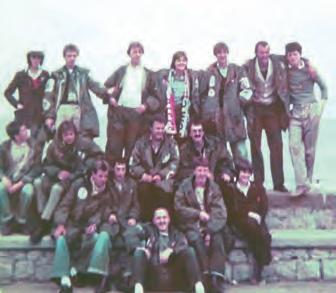

WWW.CLASSICSCOOTERIST.COM128 THROUGH THE LENS 1979: SOUTHEND 1980: BRIGHTON 1979: RHYL

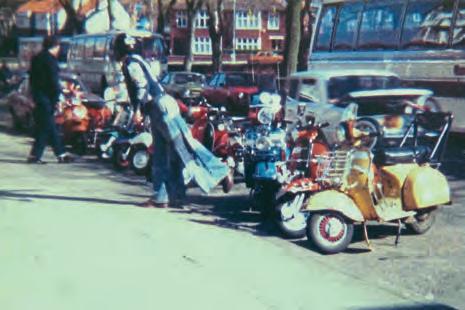

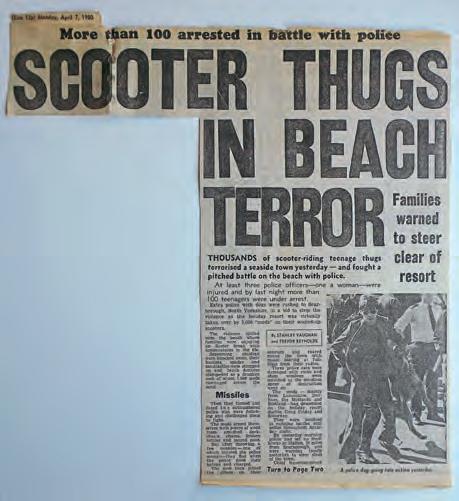



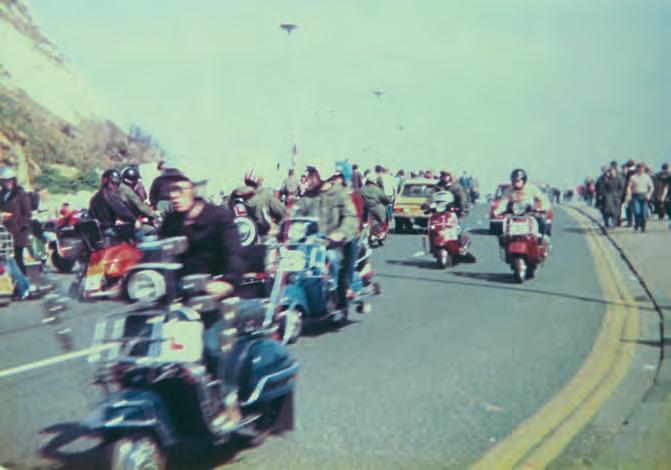
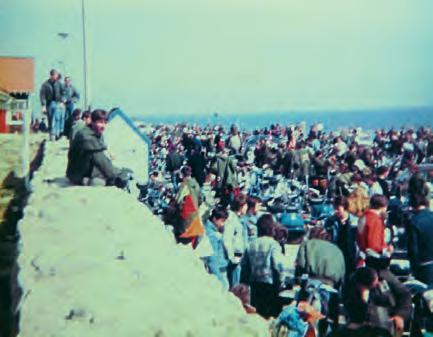

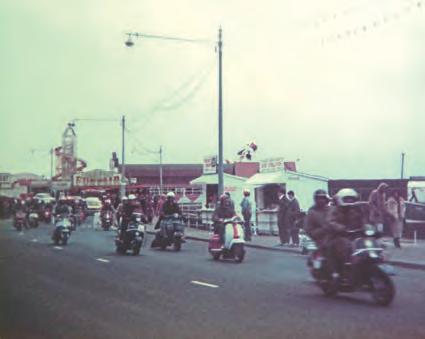
129MAUSPENCER@CLASSICSCOOTERIST.COM 1980: SCARBOROUGH 1982: SCARBOROUGH
LENS
THE MAGAZINES OF THE DAY
Also in Steve’s collection were copies of two magazines that were available during the 1970s and 1980s; they were very rudimentary as can be seen in these two examples here.
It’s interesting to note the different approach to the scooter scene in the north and the south of the UK; events and rallies were heavily featured in the north, while music was more to the fore in the south.
NORTHERN MOD SCENE

Produced in Scarborough, four issues were published per year with the content mainly being made up of event reports, road tests and technical advice.
MAXIMUM SPEED
A southern-based publication produced in Stamford Hill, London, which had more of a bias to the bands on the music scene of the day.




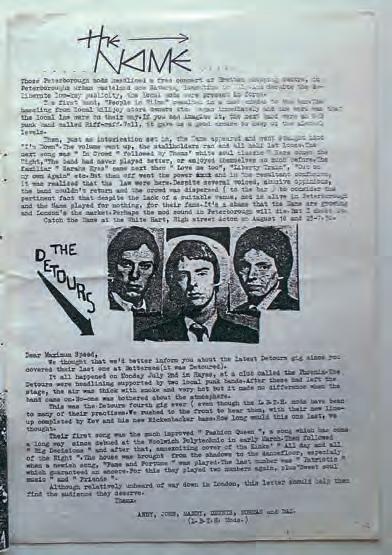



DO YOU HAVE ANY NOSTALGIC MEMORIES TO SHARE WITH OUR READERS?
If so, please email Mau (mauspencer@ classicscooterist.com) – our readers are waiting to see them.
WWW.CLASSICSCOOTERIST.COM130 THROUGH THE
Rocky Rally Aussie style
The sounds and smells of two-stroke reminded us all of how much we miss the UK scooter scene but I wouldn’t swap what we have for the world The rally is hosted by Rockingham Crusaders Scooter Club and is held at a camp that’s normally used to provide holidays for kids with illness or families who otherwise would not be able to visit this pristine bit of Perth. The camp is the scooter club’s chosen charity, so the rally kills two birds with one stone.
The rally started at 4pm sharp on Friday evening with Perth’s finest DJs spinning classic vinyl Mod, Britpop, Ska and of course Northern Soul. Next on to the stage was John Peel Experience belting out the finest punk covers from the Clash to the Pistols Refreshments (beer and cider) were on sale at the ridiculously low price of $3AUS a bottle. That’s about £1.50 so it should come as no surprise that more than 2000 bottles were sold! More from the DJs during the interval and the band brought the house down with their final set. An outside 24-hour bar was set up next to the beach and was well attended (trust me, it’s the future).
The following morning after a slap-up breakfast it was outside to find/check/start your scooter. A rideout took everyone to a local cider brewery about 25km away where we enjoyed a quick pint and were back on the road. Next stop The Swinging Pig Bali Bar for more DJs and beer. The scoots lined up outside for photo opportunities and then each rider took their scooter back to the camp, tucked them up for the night and then boarded one of the two minibuses bringing thirsty folk to the bar
The Saturday evening started again with DJs playing everyone’s favourites and a few original rarities from the ‘$100,000 box’ The evening’s entertainment was provided by the immaculate Captain Pugwash and the cabin boys, the final song being Rhinestone Cowboy, which is a Crusaders favourite. Everyone then retired to, you guessed it, the 24-hour bar


The last drinkers left at around 5am and there were some very tired eyes for the final fry-up. Over the course of the morning the Crusaders banded together for a massive clean-up.
Although we do miss the UK scene we live in a wonderful country with wonderful friends and still get to enjoy those amazing scooters.



Words and images: Mark Leahy

After two Covid-induced cancellations the Rocky Rally finally went ahead in Rockingham, Perth, Western Australia. Only seven months late!
| SCOOTERING | MARCH
Young Scunthorpe lass
Margaret Hurst (nee Moody) wasn’t there at the genesis of the scene, but in 1961 she followed in her elder sister’s footsteps and bought herself a Lambretta Li150. While her sister, June, had owned a Series 1, Margaret bought the more up-to-date Second Series and used it as her day-to-day transport to and from her job at the local steel works.

The Young Ones
On one of these journeys, she was flagged over by a dashing young man riding an LD150 who invited her along to Scunthorpe Lambretta Club (SLC), which met regularly at a club just on the outskirts of town. Intrigued, she accepted, this being the start of an adventure-filled few years with the club.
As is still the case with scooterists today, SLC members weren’t happy to stay within the town’s boundaries. They’d regularly head off to Lincoln for roller skating and make trips up and down the East Coast to towns that are still regular scooterist haunts today, such as Cleethorpes, Whitby and Scarborough. There were trips further afield too: an annual trip to Belle Vue in Manchester being one of them. There were also journeys to Chesterfield where the club sampled the delights of the local Wimpy Bar and a regular ride to Hunstanton, which invariably seemed to involve someone breaking down on the way home!
Margaret’s scooter story
The club’s members were attendees at many rallies, including one at Barnsley where Margaret was encouraged to take part in a trials type treasure hunt on her Series 2.
At the start, she was dismayed to see that the course looked more suited to specialist motorbikes but set off anyway. Giving it her best over the awkward course, she was happy to have completed it without serious damage to either the scooter or herself, but was surprised to be awarded a plaque for winning the women’s section, which came with a pair of gloves!
At a local event at Baysgarth Park, Margaret was involved with the club’s display team. The highlight of their exhibition was leaping a Lambretta through a ring of fire! Somehow I can’t see that happening today without insurance companies getting a panic on…
Summer Holiday
There were holiday trips taken on scooters too, and bear in mind that it was a different riding world from the one we know now. Less traffic but no motorways or fast ‘A’ roads, while a wide variety of road surfaces from tarmac to dirt tracks made highways completely different from those we have today. These journeys were true adventures for a young woman.
A holiday on the Isle of Wight was booked for her, her boyfriend (Steve, the fine chap with the LD) and two other
young couples in a pair of caravans, all riding down on Lambrettas. “Two caravans,” Margaret laughs, telling the tale, “one for the boys, and one for the girls… But it didn’t always stay like that!” she says, winking!
After a long journey with the usual collection of adventures, they embarked from Plymouth docks, which was not like it is today with roll-on, roll-off boats. In the early Sixties, it was a much more industrial process. The pillions boarded as foot passengers while the riders placed their machines in a metal stillage with a chain at each corner. They then sat with the scooter as it was hoisted over the dockside and placed in the boat through a hole in the deck where they had to stay, keeping the scooter upright, until it

…a wide variety of road surfaces from tarmac to dirt tracks made highways completely different from those we have today. These journeys were true adventures for a young woman.
Images from the earliest days of scootering tend to be of cheerful couples, with a lady sat beaming over the shoulder of her partner, but not all women were happy to be assigned the role of pillion.
Husband Steve’s little sister and his LD.
Margaret and Steve pose in state-of-the-art early Sixties riding attire. (Parrots optional)
| scootering | MARCH
docked again a good hour later.
(No more complaints about the way scooters are strapped down on ferries in future from me).
On the return leg of the journey, they sheared the rear hub and had to wait while a travelling companion hared off to the local town to find a replacement, the RAC not being a part of riding life back then!
Other long distance journeys were undertaken on their Lambrettas, including a trip to Margate, where she and Steve were photographed holding parrots in their finest early Sixties riding gear.
It wasn’t all plain sailing though when using the scooter as daily transport. Inevitably Margaret had her share of accidents and incidents, the most memorable being a wipeout on ice when the scooter shot from under her, leaving her and the scooter spinning off in opposite directions.
Her first reaction when a passer-by reached her? “How’s my scooter?” –of course!
But all good things come to an end. Margaret sold the scooter in 1964, just as the Mod boom was spreading North, and married Steve.
Wonderful Life
Selling their Lambrettas marked the end of an era but it didn’t put an end to their riding adventures. Steve later owned a motorbike, and Margaret a moped. One evening Margaret was out riding with her

The club’s Christmas get-together was a different beast from today!
A close group, there were at least eight marriages within the club.
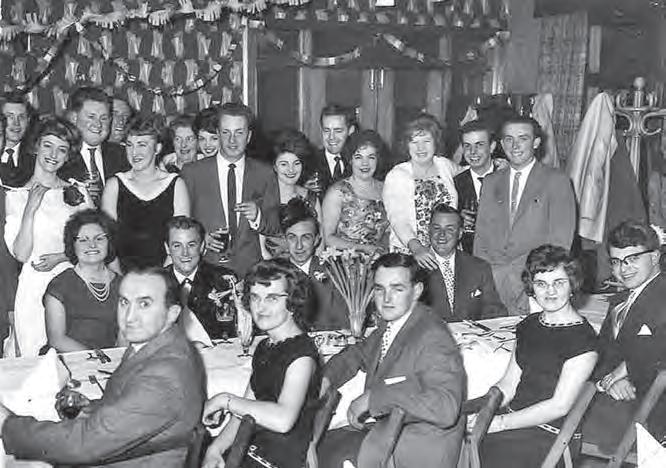
daughter as pillion when the police pulled her over. Expecting to find a couple of young yobbo types on the machine, the officer was most surprised, and somewhat apologetic, to find it was a mother and daughter!
Around the turn of the millennium, Margaret and her husband were wooed by a couple of automatic scooters and spent a few years running around on those before Steve sadly passed in 2018 after 54 years of adventure and happy memories together.
While it may not have been a life of continual riding, it certainly goes to show
that once it’s in your blood, scootering is hard to shake at any age. During my writing of this piece, I rode my GTS up to see her when I returned the photos seen hereabouts. Margaret came out, and we had a further pleasant chat about the changes to scooters, how it was still recognisably a Vespa regardless, and how comfortable it looked. Perhaps I should have asked if Margaret still had her helmet in the garage, and if she fancied one more trip around the block..
I suspect she may have been tempted.
Words: Nik
Images: Margaret Hurst
Margaret is on her Series Two Li on the left of this photo.
WWW.scootering.COM |
Vespa Rally 200 ‘Femsatronic’
In the early Seventies Piaggio unleashed a scooter of near legend Some will argue that it’s the finest ever to leave the Piaggio production line.

Piaggio finally entered the 200cc race with the introduction of their Rally 200 Electronic in 1972 It retained the layout of the outgoing Rally 180 model, being complete with 1950s VS5 derived forks, enlarged headlight, legshield glovebox and a spare wheel mounted under the left side panel. Although its engine was developed from the Rally 180 three port rotary valve motor, the new engine not only boasted an increase in cubic capacity but also extra power and torque (reputedly more potent than the P200E that would follow). More revolutionary was its points-free 6v electronic ignition produced by Femsa. Hence, ‘Femsatronic’.
Immediately recognisable by the ‘Electronic’ sticker running across the nearside panel’s speed stripe, there were a number of other upgrades to the new machine. A specially manufactured exhaust gave a distinctive noise while an ignition switch mounted in the headset gave an air of exclusivity, and a new mudguard trim in satin black along
with new badges fore and aft all served to subtly make the Electronic stand out from the crowd.
Also available, but seldom taken up in the UK and Europe, were mechanical oil injection (‘autolube’) and flimsy, easily damaged indicators mounted on stalks The US with their own lighting regulations had different light units that are possibly best described as ‘not enhancing the lines of the scooter’!
Unfortunately the Rally arrived in the middle of a troubled time for Italy’s economy and its manufacturing sector depended largely upon the import of cheap steel from the Soviet Union. As they were manufactured from poor quality steel and subjected to years of abuse few Rallys have survived unscathed Finding a British registered from new example that’s still fitted with its original engine and sometimes fragile Femsa ignition is a difficult task. Finding one in its original Cornflower Blue factory paint is almost impossible, but here it is.
This particular machine was first registered in April 1977 in Glasgow where it accumulated a mere 1754 miles before being taken off the road in 1981.
| SCOOTERING | March
RALLY 200 THE ABC
Model: Vespa Rally 200 ‘VSE1T’.

Launch date: 1972.
Production numbers: 41,275.
FACTORY PERFORMANCE FIGURES
Power/revs: 12.5bhp @ 5700rpm.
Maximum speed: 97kmh (60mph).
Accelleration: 0-80kmh (0-50mph) 10.7sec
Fuel consumption: 2.8 litres/100km (83mpg).
NB Metric to imperial conversions are approximate
ENGINE
Capacity: 197.97.
Bore x stroke: 66.5 x 57mm.
Compression ratio: 8.2:1.
Cooling: Air.
Induction: Rotary valve.
Carb: 24mm Dell’Orto.
Petrol/oil ratio: 2%.
Ignition: Electronic.
DIMENSIONS
Length:1770mm.
Width: 670mm.
Saddle height: 810mm.
Wheelbase: 1230mm.

Fuel capacity: 8.5 litres.
Weight: 106kg.
Blue Unicorn
This particular machine was first registered in April 1977 in Glasgow where it accumulated a mere 1754 miles before being taken off the road in 1981. Moving south to St Neots along with its owner it eventually resurfaced in 2008 when it was offered for sale and quickly snapped up by Mark Freer from Luton. He used it for touring France and Belgium before it was sold on, first in 2012 then later in 2018 Entrusted to Stefan Manoli for a mechanical overhaul in 2021, the scooter is now owned (cherished?) by its present owner Stuart Roberts Incredibly it has still only covered a paltry 8079 miles.
The fragile Femsatronic unit; later models were fitted with Ducati ignition.
With a couple of other modified Rallys in his ownership, Stuart keeps this machine’s mileage down so as to avoid the need for any modification. You might think it sacrilege to have drilled the original seat to fit a Bradford flip flop backrest but fear not
This was an accessory sported by so many machines in the Seventies and Stuart wanted to see that classic outline. The seat however is not original to this particular machine; that’s been safely stored away, unmolested and ready to be fitted again
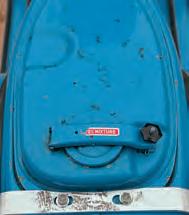
Riding-wise, the suspension is typical of unaltered Vespas with a spongey front end This is immediately forgiven as soon as the ignition key is turned and the engine pops into life. Still retaining its original pipe, this scooter’s exhaust note is authentic to a fault and distinctive enough to be recognisable among other Vespas.

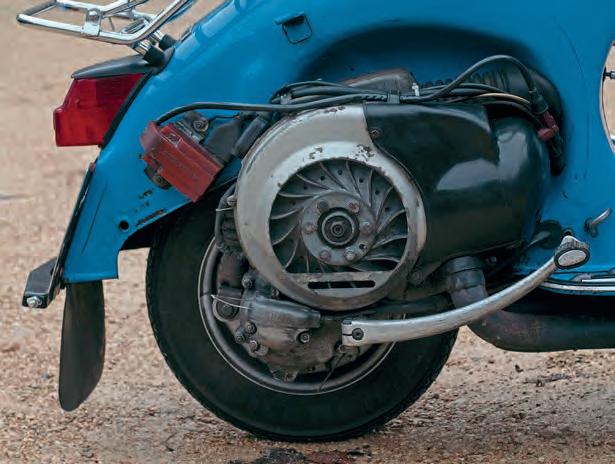
Forget about Johnnie Walker’s radio show – for those who grew up surrounded by Rallys, this is unmistakably the sound of the Seventies
The lights aren’t great on dark country roads but some things obviously have to be sacrificed for such a time-warp example of the marque.
Words and images: Richie Lunt
WWW.SCOOTERING.COM |
Vespa Rally 200 That was then...
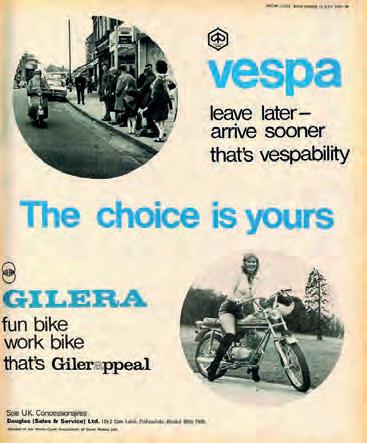

When Motor Cycle was given the opportunity to test the Rally 200 in July 1975, Peter Kelly found it to be an experience barely worthy of the £347.50 admission fee.

“Peter Kelly casts off those rose-tinted spectacles” –Vespa’s Super Scoot The 200 Rally
It’s amazing how the scooter has kept selling despite the massive onslaught of conventional motorcycles from Japan and the Continent. True, you don’t see nearly so many scooters around these days because so many good small capacity motorcycles are available but the scooter still seems to appeal perhaps to someone who likes neatness and tidiness and doesn’t like having to wear the full motorcycling gear all the time.
A scooter owner is probably more interested in reliable, economical service than in performance, and doesn’t like inconvenient jobs like adjusting chains
and mending punctures. But despite its good points a scooter does have its drawbacks You have to mix your own oil and petrol, and hand-operated gearchanges can be clonky and lose adjustment.
When we were offered a 200cc Vespa Rally, I looked back with rose-tinted spectacles to the days when such a machine was the ultimate. In the everpopular scooter rallies, the ‘big’ model was king; it would whisk you and your girlfriend, plus all your luggage, from Land’s End to John O’Groats and back in turbine smoothness. Since then, however, we’ve grown spoilt with high performance, multi-cylinder bikes from Japan and elsewhere, and unfortunately those rose-tinted spectacles show a somewhat distorted picture of the scooter’s true merits.
But perhaps it’s unfair to compare the Vespa with a conventional motor cycle, anyway It would be difficult to think of many improvements without losing the concept of a scooter completely During my initial try out of the Vespa Rally, in the busy streets of Bristol, where Douglas (Sales and Service) have their headquarters, the first thing that struck me were the incredible brakes. Even in the dry I had to be very
A scooter owner is probably more interested in reliable, economical service than in performance, and doesn’t like inconvenient jobs like adjusting chains and mending punctures.
| SCOOTERING | March
careful to avoid locking both wheels In the wet, I was scared, so I settled for just riding slowly It’s not often we find a machine overbraked but overbraked the Rally certainly is
Once I got used to the idea of steering around corners rather than laying into them, I found little to criticise on handling. With the small wheels and fairly hard suspension, it got a bit bumpy on uneven surfaces. A queer handling trait I discovered when cruising along the M4 from Bristol, at about 60mph, in the slipstream of a huge lorry. This disturbed air attacked both ‘pods’ and a sickly weaving motion set in The front end began to feel strangely light, but I just sat there, fascinated, letting it shake its head. A bit like the Manx Maid on a rough day!
Unfortunately I was stuck with this sensation for many miles because at 60mph, the Vespa did not have enough reserve to overtake. Even downhill it wasn’t possible because the lorries increased speed too. The alternative would have been to settle for a 45mph cruising speed, unthinkable!


Apart from being a bit clonky, the Vespa’s fourspeed gearchange, on the left handlebar, gave no trouble Selecting first required a double-jointed left wrist, producing a few aches after an hour in heavy traffic.
The fan cooled, horizontal engine, with the cylinder snuggling beneath its cooling hood on the right-hand side of the machine, never faltered. The claimed maximum speed of 68mph is an honest figure, though past 60mph vibration could be felt through the seat and footboards. But the claimed fuel consumption of 94mpg is unrealistic under normal circumstances. If you’re pushing it, 60 to 65mpg is about right. And that’s still good by today’s standards. The only problem is the small (1.8 gallon) fuel tank. I ran on to reserve on the M4 and took it gingerly for 18 miles to a filling station. They had no two-stroke oil or dispensers so I had to buy a pint of ordinary engine oil. But with a ratio of 50 to 1, you don’t use much oil in 1.8 gallons and I had to give the rest of the tin to
a motorist. A measuring container is provided, with a good toolkit, in the locker behind the legshields
The horn, like an angry wasp, rose and fell in frequency with the engine revs and was pathetic. The lights compensated though. They gave a good clear beam easily adequate for the performance. There’s an ignition key and starting was never more than a threeprod affair. I stalled in traffic once but merely had to push my right leg down and it fired immediately The choke control beneath the front of the seat had to be pulled right out for early morning starts, but could be pushed back almost immediately The large efficient silencer was tucked away neatly beneath the foot-boards The test bike had a spare wheel and tyre, an optional extra, fitted neatly beneath the left-hand ‘pod’. You can’t adjust the Vespa’s handlebars and I got a crick in the neck after 50 miles But the seat is firm and comfortable and the riding position isn’t a bad compromise for a rider of average build.
To sum up the Vespa offers good value. It’s easy to clean, simple and economical to use, and should give years of reliable service And that, after all, is what a scooter is all about.
Images: Mortons Archive

WWW.SCOOTERING.COM |
Vespa Rally 200 This is now...
Everyone has their favourite Vespa and for Alex Barth, CEO of SIP, that’s the Rally 200. For years he tried to find a good, solid example but even when you run one of the largest scooter shops in the world a good Rally can be hard to find Having almost given up on his quest, as is so often the case he heard of a Rally that might be available locally. A deal was struck and his love affair with this particular example began to flourish.


Is
it possible to improve on perfection? SIP’s Alex Barth certainly believes he’s managed it with his state-of-the-art Rally.
| SCOOTERING | March
First born
Initially Alex rode the Rally almost as Piaggio had intended, only a few pieces of black powder coating were added to complement its silver paint Unfortunately the Rally’s famous performance failed to impress Even after taking so long to locate a good example, Alex realised that he’d always find some reason to ride another scooter and leave the Rally at home Despite its shortcomings Alex never fell out of love; his dream of Rally ownership was 50% complete, it just needed performance that matched its looks.
The goal was to build a durable, powerful touring scooter that had enough torque to manage the terrain around SIP’s Bavarian headquarters and that was also safe to ride on main roads. This decision was made around the time that Polini released its 210cc aluminium cylinder kit and his own machine seemed a good way to test this product. The first build with the Polini 210 cylinder incorporated a long stroke crankshaft, SIP Road 2.0 racing exhaust, SIP clutch, the original SIP 24 Dell’Orto carburettor and the variable ignition from Vespatronic. The only component left from the Rally’s original drive train was the gearbox

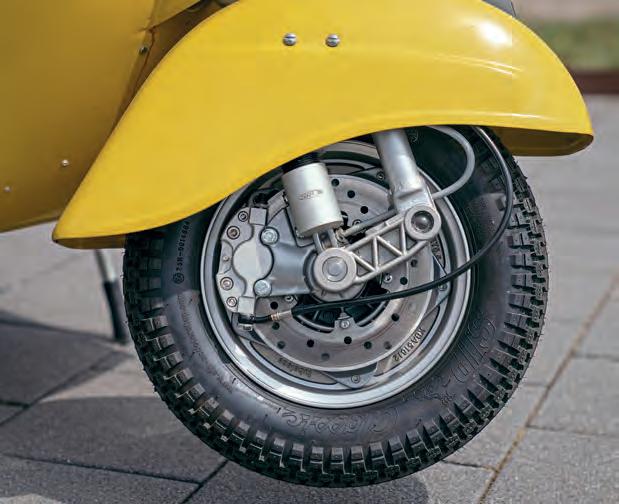
ENGINE SPECIFICATION
Crankcase: PX Lusso.
Cylinder: Racing cylinder Polini 210.
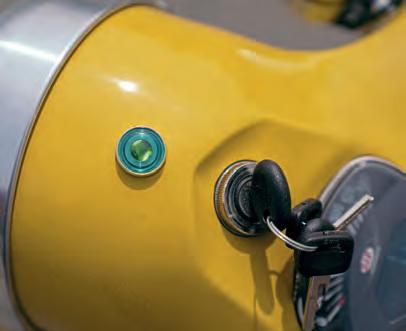
Cylinder head: MMW PX200 Touring for Polini
210cc.
Spark plug: NGK BR9ES.
Ignition: SIP Performance by Vape.
Crankshaft: Flowed racing crankshaft Serie Pro by W5 (57mm).
Carburettor: Dell’Orto/Spaco by SIP SI 24.24.
Air intake system: Pinasco VRX-R 24.
Exhaust: SIP Road 3.0.
Clutch: SIP Cosa 2 Ultrastrong
Clutch friction plates: SIP Cosa 2 Race.
Gearing:
Primary: 23.
Input shaft: 12-13-17-21.
Driveshaft: 57-41-36-33.
Twisted sister
With his engine nearing completion Alex turned his attention to the chassis It’s a good bet that at this point most builders of both Vespa and Lambretta press on without giving any thought to the state of their frame Rust is tackled as a matter of course but few bother to check its alignment. Tracking down a jig can be tricky but if this step’s omitted the scooter will never ride properly So it was with Alex’s Rally The jig revealed some nasty accident damage but after some tweaking this Rally’s probably better now than when it left Pontedera
Although a straight frame’s important, a scooter will only handle as well as its suspension permits. Although Alex had intended to retain the Rally’s original front fork set-up it quickly became clear that this was never going to achieve the handling he sought.
Since disc brakes are simply more reliable, one of SIP’s P Range steering column conversion kits was installed, specifically the version with its leg shortened to 185mm, which retains the Rally’s original stance. As many builders have discovered, this is only part of the battle The single shock arrangement simply won’t fit inside the profile of a classic mudguard and although most opt to sculpt the mudguard’s profile, Alex took a different route, altering the shock’s position. This, together with a slight adaptation to the mudguard’s mount, means that the suspension has freedom to travel without snagging. More importantly the Rally’s profile remains unaltered As this is a SIP build it comes as no surprise that SIP 2.0 shocks are fitted front and rear.

WWW.SCOOTERING.COM |
With the forks in place, it was now possible to turn attention towards stopping power. An obvious choice was the Grimeca kit but with the distinctive ‘spiders web’ machined off the hub.

At the business end a SIP caliper fitted with Malossi pads provides the necessary stopping power with its hydraulic needs being fed by a rather clever conversion by Crimaz. Critically this requires no modification to the headset, a critical factor given the value of original Rally parts.
Few, if any, owners of classic Vespas will argue that the factory went overboard with their lighting fit Fortunately this is another area where classics can now be sympathetically upgraded and a new headlight was fitted, this being framed by an LED lamp ring. Finally indicators by Motogadget were fitted, the ensemble being fed from a 12v DC conversion and linked by a SIP wiring loom.
Deep in the heart of Texas
Though the chosen colour of Giallo Texas can’t be described as subtle, it is period correct and as such masks perfectly the changes that lie beneath the Rally’s skin It’s also nice to note that the paint has been applied using a two-component lacquer with a ‘nitro finish’ This ensures full UV protection but gives a matte effect, as if the paint had naturally aged

Movin’ on up
One thing that can be said about Alex and Ralph, the two owners of SIP, is that they put in plenty of scooter miles, both enjoying and testing the products they sell. The build we’ve described above actually took place a couple of years ago and new products have since found their way on to the Rally. Notably Alex has fitted a SIP performance ignition and the exhaust was replaced by the SIP Road 3.0.
Followers of SIP on social media will know that the company hosts regular tours and it’s on these that the Rally has proved its worth. As Alex explains: “The Rally has real power from the bottom up and is not designed for peak performance Between the construction of the engine and the

| SCOOTERING | March
first time on the road lay seven years, two children and a move of the SIP headquarters. A lot has happened in terms of parts The next time the engine is opened, for sure one of the smoothrunning SIP long-stroke crankshafts will go in Let’s see, maybe a Quattrini too...”
The Rally 200 may be celebrating its 50th anniversary but as Alex and the SIP team have shown, there’s plenty of life left in the Rally yet!

Words: Stan/Alex
Images: SIP
Special thanks to: the SIP team and friends, especially to: Joscha, Robert, Sebastian, Jürgen, Ludwig and Christoph

The goal was to build a durable, powerful touring scooter that had enough torque to manage the terrain around SIP’s Bavarian headquarters
WWW.SCOOTERING.COM |
Most of us have a scooter that we regret parting with For Michelle Cooke the only way to ease that heartache was to build a tribute and it’s called Dave.

| SCOOTERING | MARCH
For Michelle scootering started at a very early age. “My mum and dad were scooterists in the 1960s and our scooter wasn’t just our family vehicle, it was also my pram!”
Being a rally-going scooterist is in Michelle’s blood “We used to go to the gymkhana events of the day and I used to travel in the scooter’s sidecar on my mum’s lap. There was no seatbelt and no helmet, just a canopy over the top with a plastic cover; safety was entrusted in my dad’s riding capability and my mum’s grip!” With such a start in life it should come as no surprise that she reached the status of Number One, her club being The Tiswas Flan Flingers Scooter Collective 1974.
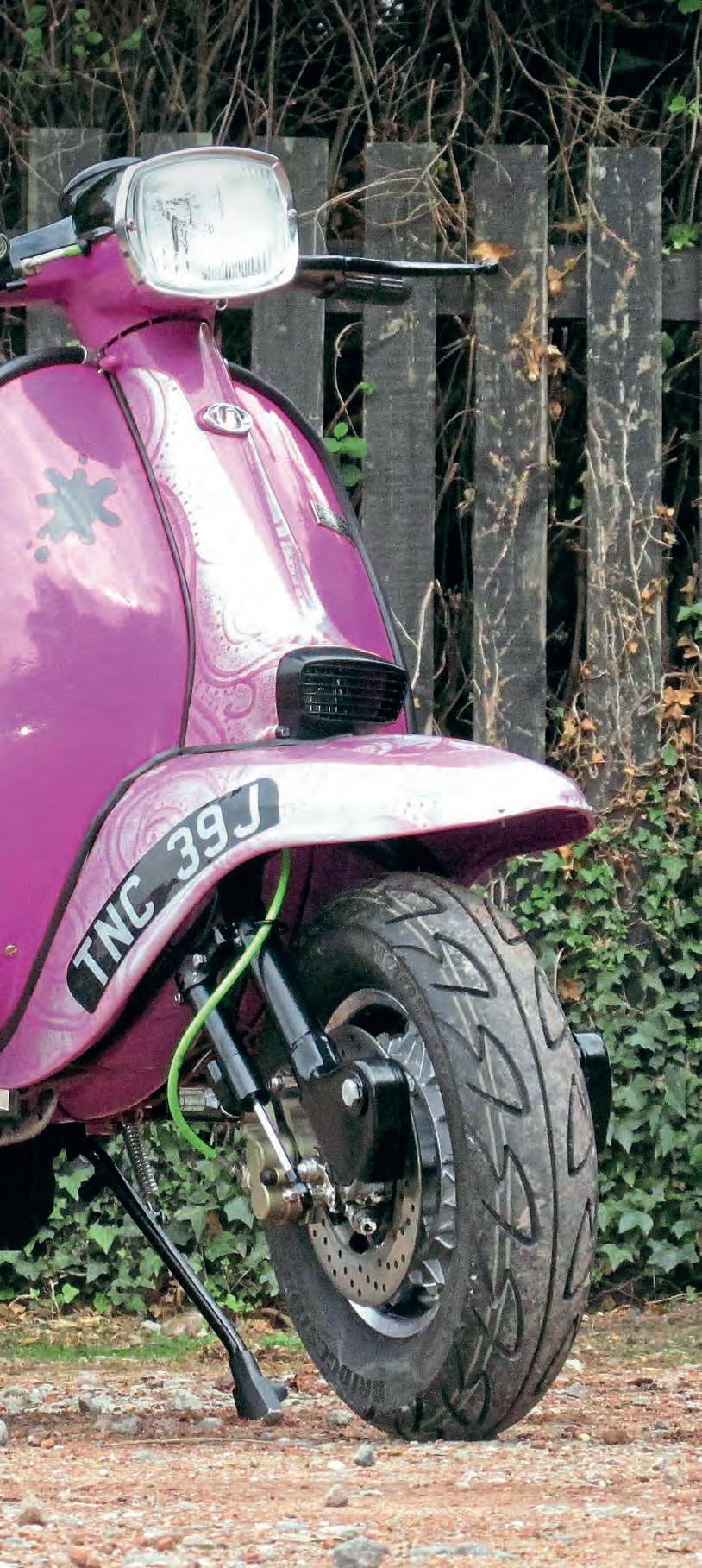
Having developed an eye for the open road from an early age Michelle’s involvement with scooters was inevitable When she discovered the associated music scene in her teens, it was a fascination that would prove to be irreversible “Although my mum and dad had introduced me to scooters, they were big Elvis fans and that didn’t interest me. I used to go to a youth club in Leicester where we lived, I got into The Jam and TwoTone along with the Stingrays, The Vibes and The Purple Things.”
As a teenager, Michelle made it very clear to her parents that she wanted a scooter of her own, but it took some years of persuasion to get the all-important parental seal of approval. “Eventually my dad finally gave in to my constant nattering. He agreed to show me how to ride a scooter on a piece of waste ground near to our house.”
Having been successfully taught how to ride a scooter and proving her competence to her parents, when Michelle was old enough they bought her a Lambretta Li150.
Dear Prudence
In the meantime, at the weekends, Michelle would hop on the train from Leicester with her pals and a few cans of beer and later they would arrive in London where the bands they were following would be playing.
After a year or two of following those bands Michelle’s weekends moved back to the scooter scene. “I joined my first club, The Homicidal Axe Wielding Maniacs SC and bought a black full-bodied GP from a Mod guy in Leicester The scooter wasn’t really my style, but I had an idea in my mind of what I wanted.”
With this in mind Michelle approached one of her Homicidal Axe Wielding pals, Martin Pope, who owned the custom scooter Law of the Land “I asked Martin if he could help me develop my scooter into a custom bike. I wanted it to have a two-pack paint job and a lace effect finish. While we were talking about the project, one of my favourite songs Competition Ain’t Nothin came into the conversation. This had a nice ring to it and not just because of the song, it also hinted at the engine upgrades I had planned. Ultimately it became the name I chose for the scooter.”
WWW.SCOOTERING.COM |
Having agreed the details, Michelle handed the scooter over to Martin. “One of the side panels was damaged, which Martin turned into an opportunity to cut both panels down and remove the back end In the meantime, the engine was given to Harry Barlow and was upgraded to a pro-ported item. When the scooter was finished I paid Martin with 12 cans of lager!”
Over the years Michelle’s owned numerous scooters, all of which have come and gone, but of all of them, Competition Ain’t Nothin, which also had a pet name of Prudence, was the one that stood out. “I’m not sure what it was about the scooter; it could have been the
Prudence.
combination of its paint, the engine set-up, its handling and development, but somehow I connected with it and I loved it.”
In 2016 when Michelle was at the Leicester Phoenix Nights Scooter Rally she met her future partner, Adrian Finch, who she endearingly refers to as her ‘Old Man’. “After we’d been together for a while I moved to Great Barr, Birmingham to live with Adrian. Between us we’ve owned lots of scooters and during our scooter conversations I’d regularly mention how much I’d loved Competition Ain’t Nothin Being a fellow scooter nut Adrian realised how much the scooter meant to me and together we decided to build a modern-day version of it.”
Turning back the clock
In November 2020 Michelle and Adrian got in touch with their trusted pal, Hodge at Supersprint Restorations After explaining the project to him they bought a ‘Lambretta in a box’ and along with the parts they had at home they started to develop the scooter.
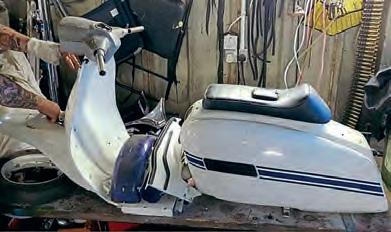

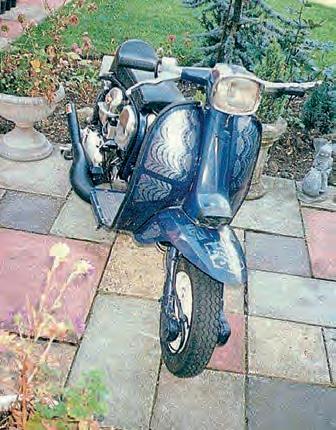
With the foundation for the build organised, it was time to start thinking about the paint. “Adrian owns a couple of custom scooters and he’d previously commissioned Jamie Harvey and her mum, Jackie at DNA Deadly Nightshade Airbrushing to complete the work. The results were fantastic, so I
approached Jamie and her mum to complete the work.
“Michelle came to us with a pink Lambretta and she was pretty certain about the design she wanted,” said Jamie “She even provided us with the net curtain she wanted the scooter’s paintwork to be based around Michelle also sent us a picture of her old scooter and explained that she wanted this one to resemble it as much as it could. We followed her instructions and used the net curtain she provided as a stencil. We gave it a light dusting of silver flake to get the effect she was looking for and Michelle chose the font for the graphics from a list we had.”

In the meantime Michelle commissioned her long-term Leicester scooter pal Pete Gray to build the engine using a set-up she and Adrian had already started working on.
Everyone has a mate called Dave
When Michelle was deciding on the name of this scooter the choices were between Competition Aint Nothin and another of her favourite tracks, Turning My Heartbeat Up. “If I’m honest I don’t know why I called the first version of Competition Ain’t Nothin, ‘Prudence’. But when Adrian and I were developing this scooter, the name ‘Dave’ popped into my mind out of nowhere. Rather than changing the name to Turning My Heartbeat Up it helped me decide to stay with Competition Ain’t Nothin Even though the scooter is a tribute to my original scooter, christening it Dave has given this Lambretta its own, unique, identity. Looking back, I’m not sure which took most effort, building the scooter or deciding on the name!”
Words: Stu Smith, Images: Stu Smith, Michelle Cooke
2020, the bare bones of a project.
Michelle’s mum with one of the family scooters.
| SCOOTERING | MARCH
Lace curtain templates, old school cool.
Speedo’s also had a makeover.
OWNER DETAILS
Name: Michelle Cooke.
Scooter club & town: Tiswas Flan Flinger Scooter Collective 1974, Birmingham.
Any interesting or funny scooter stories: Coming out of a scooter shop in Leicester with my mate We both had red T5s and we’d parked them next to each other That was the day that I found out that my key fitted his scooter and vice versa. I got home to find him waiting for me and wanting his scooter back!
What’s your favourite and least favourite Scootering magazine features: Dare I say it, my Old Man’s scooter, Lembretta which was in Scootering magazine. In his interview he says it as it is and it’s what a lot of us think!
Your favourite custom/featured scooter of all time: Rhapsody in Blues by the late Pete Robinson and Living on the Breadline.

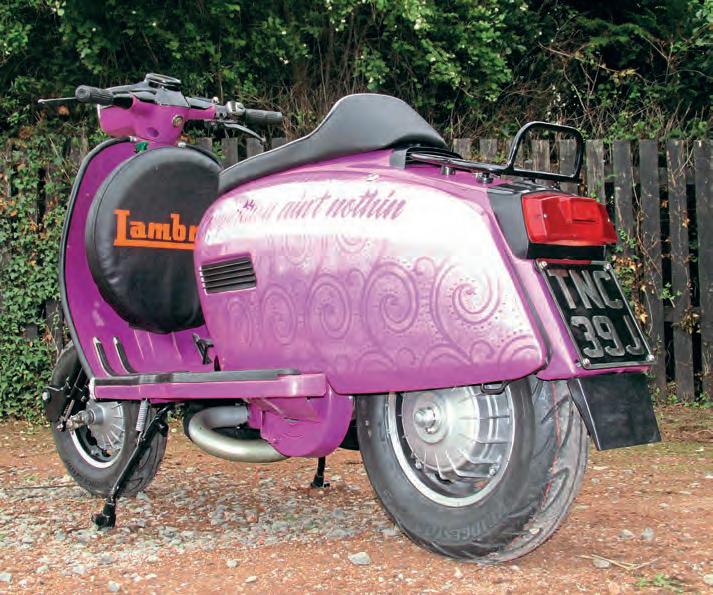
What is your favourite style of custom scooter: One where cheque books aren’t left open.

SCOOTER
SPECIFICATION
Name of scooter: Dave (Competition Ain’t Nothin).
Scooter model: Lambretta GP225.
ENGINE SPEC
Kit: Iron Barrel 225. Crank: Standard GP. Carb: 30mil Flat-Side OXO. Exhaust: AF Clubman. Clutch: Standard. Gearbox: GP200.
Paintwork & murals by: Main frame power coated by Classic Reproductions, Birmingham Lace effect and graphics by DNA Deadly Nightshade Airbrushing.
Powder coating by: Classic Reproductions, Birmingham.
Seat by: Short Ancelotti (one-off design)
What was the hardest part of the project: Waiting for the bits to come back.
Do you have any advice or tech tips for anyone starting a project: Patience. Think of a price and treble it!
Is there anyone you wish to thank: Adrian Finch (my ‘Old Man’), Classic Reproductions, Jamie Harvey at DNA for the paintwork and lace pattern, Hodge at Supersprint Restorations for his input, Pete Grey (Knacker) for the engine rebuild, John Walklate and his magic hands and David Payne (On Small Wheels).
Although my mum and dad had introduced me to scooters, they were big Elvis fans and that didn’t interest me.
Brought up in California, Jennifer Parker now lives in Prague and was the first woman to be presented with the Vespa Trophy for Lone Rider She spoke to Caroline about her love of scooters “I love to ride!”

What prompted the move to Europe?
A riding accident in 2009 left me unable to walk for almost a year. Four years and seven operations later, my job offered me an early retirement package that I couldn’t turn down. With no job and no place to live, I set off to start a new life.
What do you own/currently ride?
I keep scooters in two countries! In Prague I have Ruby, my GTS 300, but when I want to have fun or I’m riding with Vespa Club Praha, I use Monti, a PX150 By the end of this year I’ll also have Star, a 1964 Lambretta Special 125, back on the road. A lack of parts in the Czech Republic means that rebuild’s been slow going.
In California I have my favourite baby, a 1962 TV175 that’s in pieces all over the garage. I don’t know if I’ll ever get her back together, but we have created countless memories. I also have a 1963 Li150 with a 190 kit, but he needs some work. I also have Brooke, a 1962 Riverside with a 190 kit. I don’t have a car in California so use a GTS 250 fitted with a Malossi 300
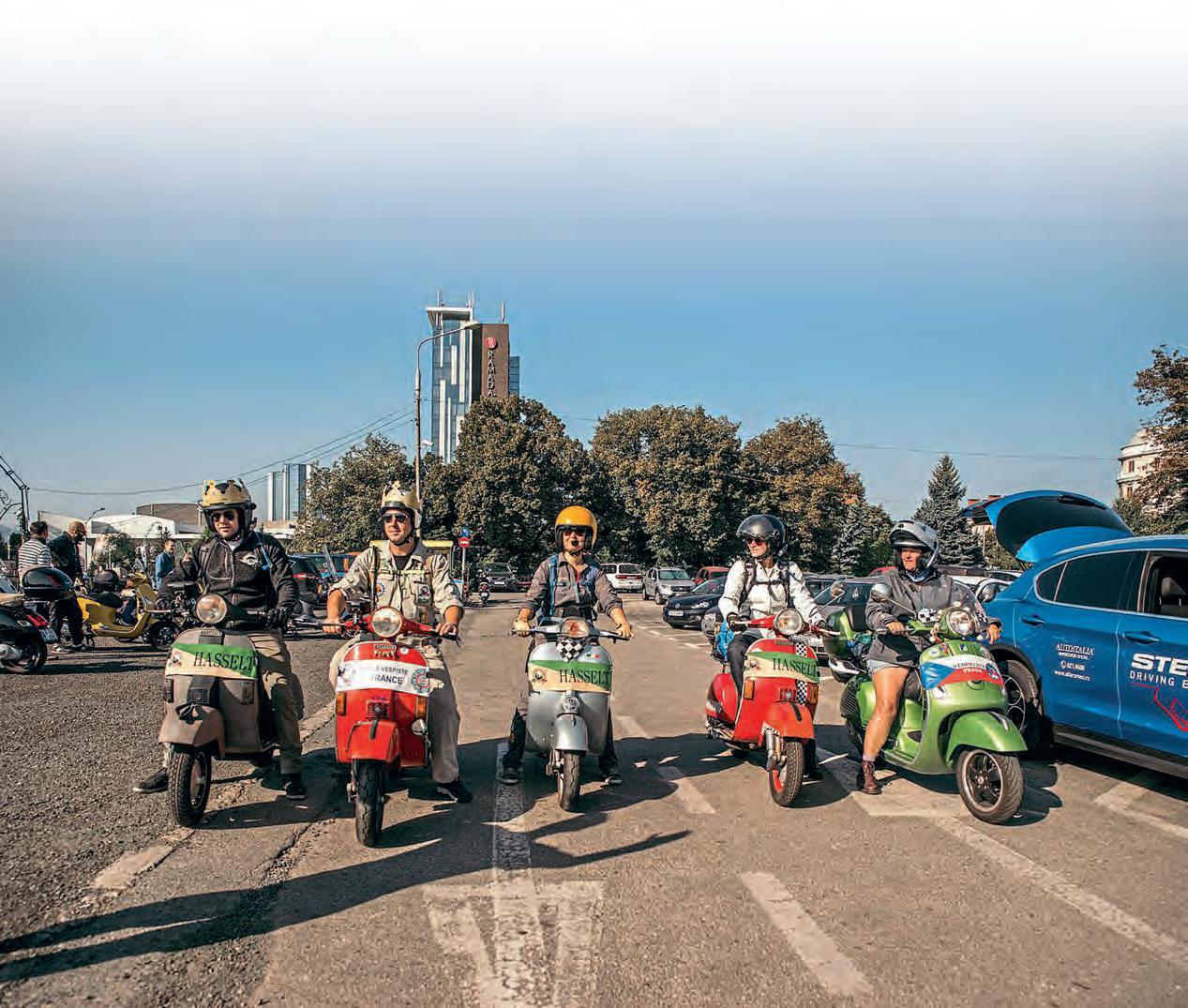 Castle Ride, Transylvania.
Castle Ride, Transylvania.
How does the European scene compare to the States?
It’s quite different due to the topography and distance between cities. It’s very difficult to get anywhere without travelling long distances on motorways. It’s not unusual for there to be more than 100 miles between petrol stations so we tend to haul our scooters to events, unload them and ride them for the weekend The itinerary is usually: Friday night meet and greet at a bar. Saturday, meet up for coffee and donuts, a day-long rideout with a stop for lunch or a barbecue with games and a gymkhana, and then a band in the evening. Sunday is a repeat of Saturday but ending early so you get back home for work on Monday In Europe, what really excites me are the threeto-five-day rides instead of rallies! I’ve been on a couple now in Romania and Sicily.
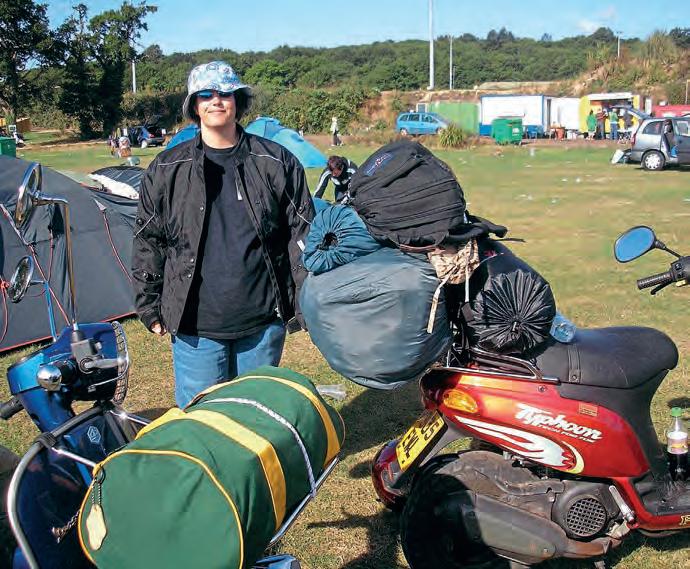
What is the best/most memorable ride you have completed?
It is so hard to pick! And from which country? I have ridden in so many I’ll tell you about my first solo European ride, which is where all this craziness started.
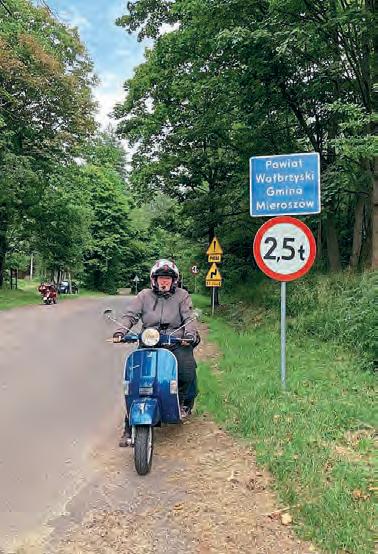
I was well enough to start riding again in 2013 For my first real ride, I decided to do three rallies, three weekends in a row, in three countries! I flew to London and picked up a modified Piaggio Typhoon. While my heart belongs to Lambretta, I don’t care what I’m on as long as it has two wheels!

I set off from London and headed to Preston to meet up with Dee, who I’d met at Berwick Border Bash, and ride to Kelso Now, I am a Southern California beach gal from sunny San Diego so British weather was a shock. Before long I started to freeze
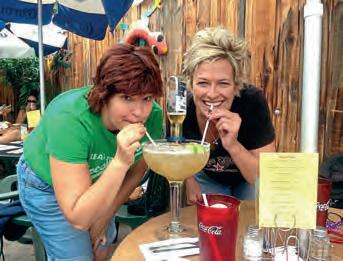

and then down came the rain, at one point I had to hide under a bridge because of hail! I barely made it to Peterborough.
Cold, wet and miserable, I was ready to give up, but instead, I bought some dishwashing gloves and plastic bags for my feet, had some hot tea and set off again. What should have been a four- to six-hour ride took about 12!.
That was my introduction to a proper riding kit and shoes. In California, we ride in shorts and pumps. Thankfully Dee found some of her old gear and dressed me for the ride to Kelso.
After Kelso, I rode to the Isle of Sheppey for the Sid James rally. I had met Wils at Mersea Island rally before Facebook was invented and had stayed in touch. Year after year, he sent me invitations to Carry On, and finally I was able to attend!!!
Polish border.
Star on her way to Poland.
Denver – Mile High Mayhem rally.
My club – Cercle Vespiste de France.
Isle of Wight 2006.
WWW.SCOOTERING.COM |
After my miserable experience riding to Preston, I asked on Facebook if anyone was riding from London and could I tag along. That’s how I met Martin McGowan. Along the journey, we stopped to see some sights and meet friends. I was telling them how I planned to attend EuroLambretta in Avignon. My plan was to rent a car, but I was informed I’d do no such thing when I had a scooter to use!
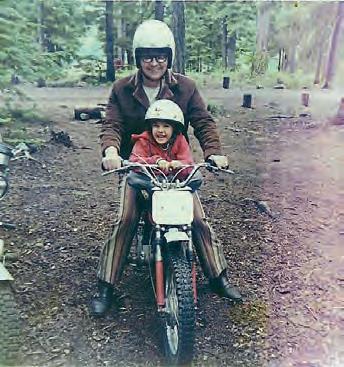

I accepted the challenge and entered mainland Europe for my very first time. That was a culture shock! Navigating through France, and the streets of Paris, was both scary and exhilarating! I couldn’t speak French, not even ‘hello’ or ‘thank you’. Then I realised I had a fuel leak but managed to find a Piaggio shop and using a lot of gestures, got the guys there to fix me up!
I won’t bore you with the rally details because I am sure many of you were there, but I will tell you of my trip home
The journey started off uneventfully but later in the day the skies grew black, and I knew I needed to get off the road The next day I was exhausted and should have stayed in bed for
the day, but I didn’t listen to my body. I loaded and fuelled up, put the choke on and set off.
I stopped a couple hours later for lunch and realised I never turned off the choke.
Shortly after lunch I seized! Don’t ask me how, but I finally managed to get recovered The driver took me to a little town, found me a room and told me he’d take me to a Piaggio shop in Lyon in the morning.
At the shop they just got started and then closed for lunch, sending me away for two hours. After lunch, I got a translator on my phone and learnt that they couldn’t get parts I decided to abandon the scooter and get a train to Paris, then the Eurostar to London. No sooner was I on the train, then everyone got off. Huh? I gathered my belongings and asked what was happening. The conductor says they switched trains and I needed the one that left two seconds ago!
I caught the next one but had to change trains in Paris I didn’t know there were two stations in Paris and I finally arrived at the right one two minutes late! So I decided to find a place to sleep and get a train the next day, just making my flight back home!
I have to do a four-day ride in Sicily one weekend, get to Las Vegas the next weekend for the Hard Pack SC 30th anniversary rally, and to Belgium the weekend after for EuroLambretta!!!
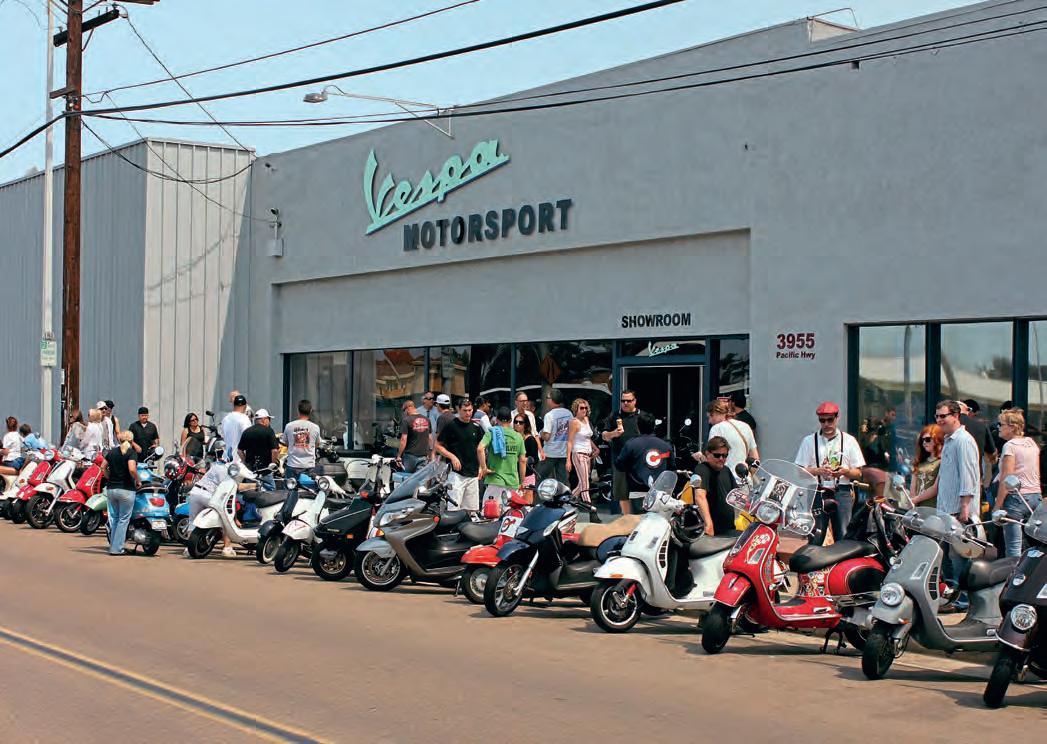 Vespa Motorsport, San Diego.
Getting greasy.
Jen’s first ride.
Vespa Motorsport, San Diego.
Getting greasy.
Jen’s first ride.
| SCOOTERING | MARCH
Do you have any tips or advice to share?
Pack light When I first started doing these rides, I packed so much. I can now do a three-month trip with just the items in my top case. Invest in good gear; I can fit my tent, sleeping bag, air mattress and pillow along with spare jackets under the seat of my GTS. It’s expensive but will last you over a decade!
Most importantly, listen to your body. Every time you stop for fuel, fuel your body too. Drink a bottle of water and eat something. When your systems start to drop, poor decisions are made If you start feeling drowsy, pull over and sleep on the side of the road for 20 minutes. It can save your life
What’s your next adventure?
I fly back to Prague on March 1 for our Northern Soul Weekender. After that I head to Cognac, to meet up with Le Cercle Vespiste de France. Then it’s back to Prague for the summer, which will be challenging as I have to do a four-day ride in Sicily one weekend, get to Las Vegas the next weekend for the Hard Pack SC 30th anniversary rally, and to Belgium the weekend after for EuroLambretta!!!
Damn it’s cold!
I haven’t thought too much past that I know there’s a ride in Serbia I’d like to attend, the Three Castle Ride in Romania if it happens and the Bulgarian ride is a must. Then there’s EuroVespa in Portugal, rallies in Greece and I must get to Shkodra, Albania and Poland to see some friends this year.


Pre-Covid I had planned a ride through Germany, down to Munich, Salzburg, Ljubljana, Split, Sarajevo, Shkodra, Tirana, Ohrid and down to Athens. Next a ferry over to Turkey, ride up to Troy and then circle the Sea of Marmara and into Istanbul I then planned to go along the Black Sea to Varna, Bucharest, Sibu, on to Kosice, and
Day job – teaching ATV safety.

visit Tokaj, Budapest, Bratislava, Vienna and finally home The idea was to do this in four to five weeks!
But for 2022, I think my biggest ride will be a two-week ride in Vietnam hosted by Saigon Scooter Center. My boyfriend has been on this ride twice. I will not miss it this time!
If you want to know more, Jennifer has her own blog: adventuresinscootering.com
Words: Jennifer/Caroline
Images: Jennifer
Selenute, Sicily with Ruby.
WWW.SCOOTERING.COM |
Role Models
The involvement of women in scootering has varied over the years, often due to the influences and trends of the time.
From its inception in the 1950s, scootering has generally been considered to be an activity dominated by men, but many women have also enjoyed the thrill of owning and riding their own scooter.
From the outset both Piaggio and Innocenti were keen to promote the advantages of their scooters over traditional motorcycles The enclosed bodywork, no oily chains and better weather protection meant that clothes had less chance of becoming dirty or stained While this was a benefit that applied to both sexes, the scooter’s stepthrough design also brought an unexpected bonus for women.
In 1950s Italy, while scooter sales were aimed at the masses, women found that they could sit and ride one easily, while still maintaining their modesty. As a result women embraced the scooter and the freedom it gave them, making them ideal targets for advertisers.

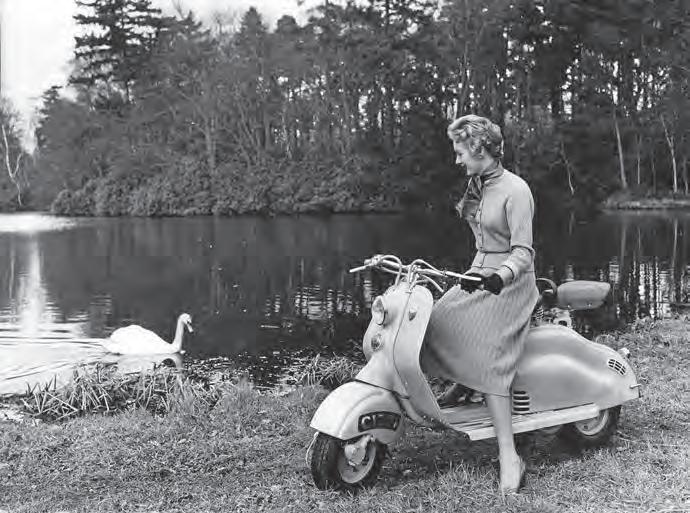
| SCOOTERING | MARCH
Scooters were promoted in lifestyle magazines predominantly aimed at women, with manufacturers and advertisers focusing on the step-through design. The adverts depicted women on scooters while working as nurses, secretaries and air stewardesses, selling the idea that owning one would give them freedom and independence. The same magazines also featured stories of the exciting adventures women were having on this new form of transport The strategy worked and sales of scooters to women soared.
All of this was in total contrast to the role of women in the growing number of scooter clubs, with many images from the 1950s showing women as pillion rather than rider However, with the introduction of longdistance and endurance events, women began travelling the length and breadth of the country on scooters and there are many examples of competition entries where both the rider and pillion were women.
Sex sells
The freedom of the post-war 1950s was followed by the 1960s, a decade which saw more social change than any other, particularly for women. The cultural and sexual revolution was seized upon by advertising agencies and the positive images of the 1950s were replaced by sexually provocative ones.
It was a backward step not only for women in scootering but also for women in general
Lambretta and Vespa rallies would almost always have a best female competition.
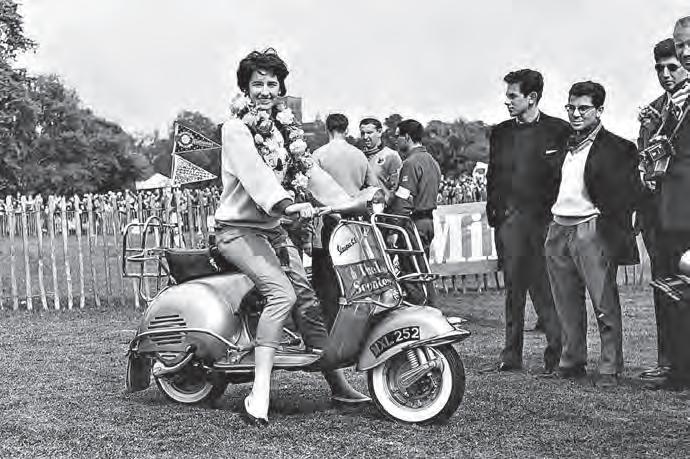

Advertising agencies proactively targeted men by creating adverts for scooters with semi-naked women sitting astride them
This tactic wasn’t unique to the world of scooters and quickly became standard practice across the advertising industry
Then, as now, advertising took a huge chunk out of a company’s budget and with the campaigns resulting in healthy sales, the predominantly male boardrooms were happy for them to continue.
By this time scooter ownership was growing rapidly among young people
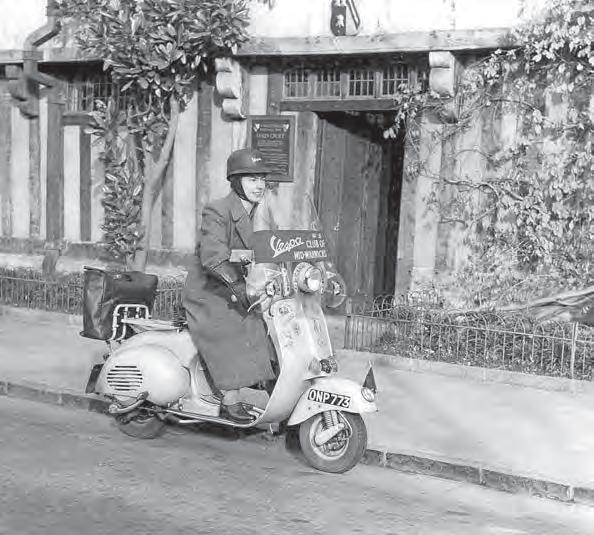
and scooters were being used as leisure vehicles rather than a primary form of transport. In the UK, Lambretta edged ahead of Vespa in respect of sales and in order to maintain its growing customer base Lambretta introduced several organised events Two of these, the annual Miss Lambretta and Queen of the Road, were targeted at women scooterists
They were extremely popular and widely contested, with the Queen of the Road becoming a prestigious award in its own right.
...it became increasingly apparent that not only were these women talented riders, they were also utterly fearless.
Margaret Farquhar, an inspiration to all.
WWW.SCOOTERING.COM |
Sprint and sport
The Atlanta V speed record event was another successful advertising campaign directed at women by Lambretta Concessionaires. Despite the fact that at that time women weren’t allowed to establish land speed records, Lambretta only invited women to apply as riders. Not only did the interest from the press provide a huge amount of free advertising, it also generated an unforeseen development for women scooterists.

The Atlanta V was designed to travel at speeds of more than 100mph and wasn’t for the faint hearted Despite this, the interest from women riders was immense. As the numbers reduced, it became increasingly apparent that not only were these women talented riders, they were also utterly fearless At the end of the project the successful rider, Marlene Parker, used her experience to launch a racing career outside of scooters. Many other women who applied and demonstrated their skills as part of the Atlanta project became involved in the growing sport of scooter racing and competed on equal terms with their male counterparts.
Women including Beverly WakefordBrown, Christine Jackson, Ann Weir and Christine Riley were now being taken seriously and became scooter celebrities in their own right. The rivalry was intense, with these pioneering women determined to prove that they had earned and deserved their place in top-tier scootering.

Despite the success of these women, it was difficult to change broader attitudes and the advertising campaign which heralded the Grand Prix Lambretta’s arrival proved that. There was no attempt to disguise sexual innuendo, the crude words and the images were carefully chosen.
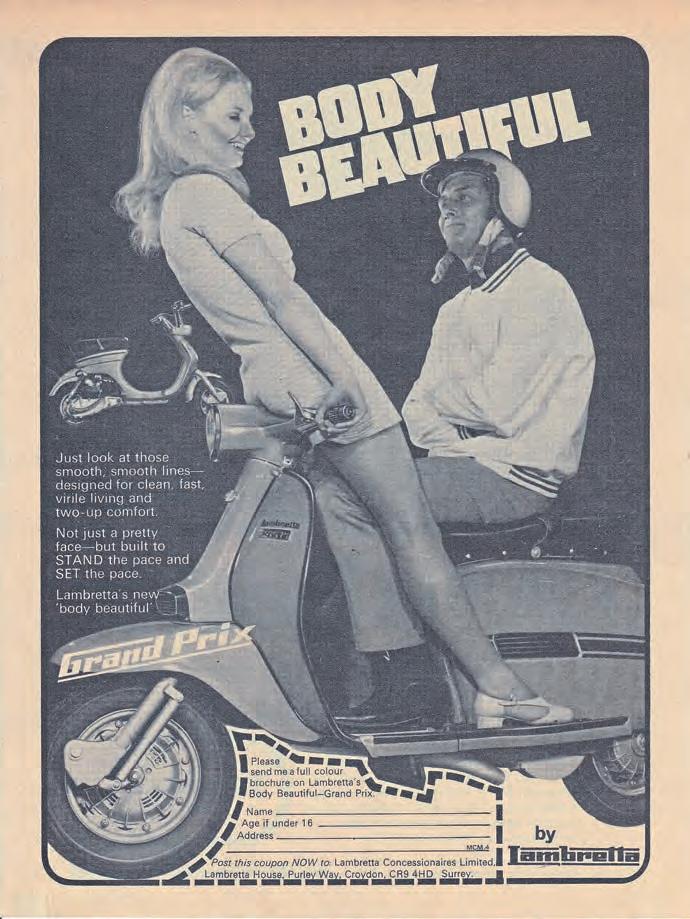 The Atlanta V may have been a lightweight, Marlene certainly wasn’t.
Joan Thorne, who won Queen of the Road and Miss Lambretta international titles in 1966.
The Atlanta V may have been a lightweight, Marlene certainly wasn’t.
Joan Thorne, who won Queen of the Road and Miss Lambretta international titles in 1966.
| SCOOTERING | MARCH
The campaign remains as a snapshot of contemporary attitudes.
A gradual shift
The scootering flame was reignited in the 1980s with a generation of young scooterists and with them the modern scooter rally was born Women were once again involved and attended the rallies, some as pillion but many riding their own scooters.

While many scooter clubs were a mix of both men and women, some all-women scooter clubs began to emerge in towns and cities across the country Unfortunately outdated values and attitudes were still prevalent and sexualised photographs of women appeared on the front cover and centre pages of this very magazine in order to promote sales Slowly that portrayal died out and as attitudes changed so too did the scooter scene, with male and female scooterists enjoying the pleasures of scootering together as equals.
At the very top
With its best-supporting member championship, The Lambretta Club of Great Britain paved the way forward for women who got their own, keenly contested, championship The gruelling effort of riding the miles required to win it demonstrated the dedication of those involved. This dedication was carried forward into the club, with women such as Mandy Hensby-Green taking on committee roles. Three women currently serve on the LCGB committee, playing an active role in how the club is run and giving a voice to women riders.
Likewise for the Vespa Club of Britain when in 2016, Jo Turner won the attendance award by becoming the first woman to attend every event that year.



In an article this size it’s inevitable that the contributions of many individuals, past and present, will go unmentioned. However no discussion of this type would be complete without mentioning the late Margaret
Farquhar An Honorary Life President of the Vespa Club of Britain and recipient of the FIV Silver Star of Merit, her scootering career began in 1952 and lasted into the 21st century Whether as commuter, club scooterist or for her work promoting the Vespa cause, few people will dispute that she was, and remains, a source of inspiration to all scooterists.
Society has changed a great deal over the past seven decades and so has the way we use and appreciate our scooters Women have been part of the scootering story from its inception, but at times their contribution has been diluted or corrupted We can’t change history but we can ensure that the past, present and future achievements of women scooterists are recognised Not just in this ‘special edition’ but routinely. After all the only thing that really matters is a passion for scooters.
Words: Stu Owen
Images: Stu Owen/Mortons Archive
Christine Jackson had a successful career in scooter sport.
Glynis Elgey is one of the well-known female faces of the modern scooter scene.
Mandy Hensby-Green, a long-time Lambretta rider and member of the LCGB committee.
Jo Turner, Vespa attendance winner in 2016.
WWW.SCOOTERING.COM |
If you were around in the 1980s it’s almost certain you will have seen at least one of the Mad Max films. Set in a future postapocalyptic world it may have been the characters and storyline that got the viewer hooked but, for many, it was the vehicles that stole the show. Most of them resembled cobbledtogether pieces of rusting metal and looked like something from TV’s Scrapheap Challenge. One of the standout cars in the film was Razor Co a machine based on a 1973 Ford Falcon coup and also referred to as Caltrop No 6 It was this vehicle that became the inspiration for th scooter that you see in front of you
Fury

Tony Lewis has been involved in the scooter scene for some years, in fact it’s an obsessio that predates the first Mad Max film’s releas in 1979. Though his favourite scooter is the Lambretta GP and he admires some of the top custom Lambrettas that have been built over the years, his choice for this project wa a humble 1985 PX 125. Using Razor Cola a the inspiration he started the project some s years ago, so he’s certainly taken his time to ge it right! In the first three films of the franchis Ford Falcon still has some resemblance to the car that first left the factory However, in 20 fourth film was released and it’s this instalm of the Mad Max saga which inspired the loo Tony’s creation.

Altering the state of an existing object is not as easy to do as it looks, but when it’s executed correctly the results are astounding
| SCOOTERING | MARCH

WWW.SCOOTERING.COM |
That film is called Fury Road and in it the Ford Falcon is destroyed completely but, from its ashes, the bare metal machine of Razor Cola is born. Before members of the Royal Society for Prevention of Cruelty to Scooters get in touch, Tony didn’t destroy a scooter as part of the creative process (there’s a challenge there if someone wants to accept it though!) What Tony did have was a clear idea of what he wanted to achieve. The finished machine would be in bare metal, meaning there was no worry about expensive paintwork. As the look would be achieved by fabricating parts and adding them in a way that represented Razor Cola’s home-built feel there was also no need for precise finishing. It’s a simple concept but a huge amount of work, and skill, has gone into achieving the right look Making the finished product look like scrap that’s been welded and riveted back together isn’t as easy as it sounds.
Thinking outside of the box
Although the Mad Max vehicles are of different shapes and sizes, they all appear to have been assembled from materials that happened to be available. It’s an idea that Tony’s exploited to good effect, going outside the parameters of what’s normally expected when building a scooter. To start with, he cut down the main bodywork as if he was building a cutdown. This changed the shape we associate with the Vespa, an illusion he developed by adding parts that were sourced from the most unexpected places

The main cross member from the front legshields to the tank was inspired by a 1932 Ford car axle. The front fork support, with a skateboard wheel on one end and a bullet case the other, is connected by a con rod. A spanner was reshaped and used as the kick-start, while the rear light unit is actually an old Amal MkII carburettor. This list goes on and on but rather than describe them all it’s worth taking time to study the images This is a scooter that rewards close attention by constantly revealing new aspects of its construction. It’s this clever use of what is basically scrap that starts to make the desired look come together in a strange sort of way.



Alter ego
While the use of alien components is imaginative, I’d argue that the real skill of Tony’s build has been in the way that he’s reimagined original parts All around the build, Vespa components have been modified, giving the impression that they’re something else. A sort of alter ego effect. To start with, Tony lowered the front end by two inches, adding shortened forks and a horncasting both taken from a T5 As a result the front end is unmistakably Vespa but it’s hard to determine which model. The wheels are made up by using four of the wide half Vespa rims with the extra valve hole on each one welded up. The front uses a 90/90 x 10 tyre while at the rear it’s a 120/90 x 10. This gives the impression of odd wheels dragged from the scrapheap To finish off extra holes have been drilled around the rims with Allen bolts and domed nuts fitted, totally changing their appearance.
Elsewhere there are bits of fabricated metal fitted all over the place, most of which have generous amounts of holes drilled through them. Some of these are left blank while others have button head bolts added to give the impression rivets have been used. This clever but effective engineering has transformed a Vespa PX into something almost alien-like, exactly how it is in the film.
| SCOOTERING | MARCH
OWNER
Name: Tony Lewis.
Scooter club & town: Shrewsbury.
What was your first scooter and how did you first become interested in them: An old Vespa 125 my mum bought me for £40 when I was 14 The bloke who lived over ‘Skin’ Roberts, had Lambret up and sold them. I think he Shrewsbury at that time (197 Any interesting or funny scoo look of confusion and shock Ricky’s face, when he won for his ‘Apocalyptic Prelude scooter at the Taffspeed Op 90s.
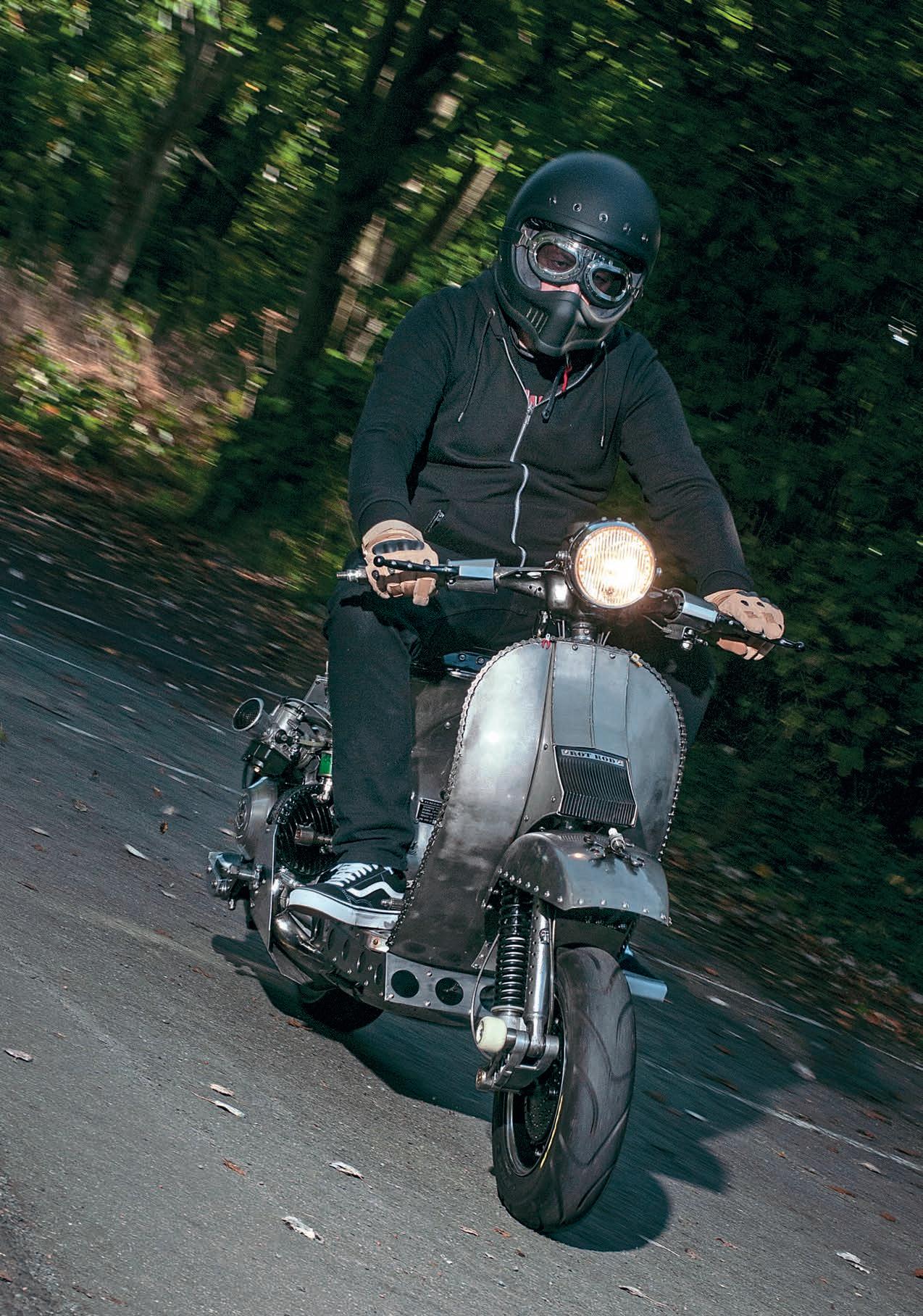
Your favourite custom scoote Warrior LOL, Spiritwalker (a changer at the time).
What is your favourite style

Any scooter that has had a imagination gone into it.
This is a scooter that rewards close attention by constantly revealing new aspects of its construction. It’s this clever use of what is basically scrap that starts to make the desired look come together in a strange sort of way...
Tony, ready for the apocalypse.
WWW.SCOOTERING.COM |
Charged
Having gained a reputation as the go-to Vespa mechanic in his area it is no surprise to see Tony has carried out the engine build himself. In the films, the engine in the car is heavily modified. Most of it sticks out of the bonnet, a none-too-subtle hint that it’s some sort of immensely powerful supercharged lump Therefore the Vespa needed to have something more than standard. This one uses a Malossi 210 ported by Tony with a Mazzucchelli crank, 28mm Dell’Orto carburettor, and PM tuning exhaust Though it provides plenty enough power for what he needs, just like Razor Cola, the engine has been cosmetically enhanced to make it appear even more monster-like That has been done in two ways, firstly by adding outer metalwork to the engine and putting a huge bell mouth on the carburettor. Secondly, and far more subtle, is the second. On the footboard centre is a huge bottle and gauge similar to that used for nitrous oxide injection. They don’t actually do anything and are purely cosmetic but that’s not obvious to the casual observer It’s a great example of what makes this scooter so clever. It gives the impression that it’s something else even if we’re left unsure of what it actually is.
What if
The Mad Max films are set in a world that’s dissolved into chaos with scavenging being the main source of obtaining resources. Imagine the same scenario but with scooters instead, what would they look like? The answer is simple enough, they’d look like this I think Tony has got the look of his Razor Cola spot on Although he’s used a selection of automotive items in his design, the execution is nothing short of stunning. There are so many clever ideas in this design and for me, certainly when judged on fabrication, this is one of the best custom Vespas I’ve seen in years.
Words: Stuart Owen
Images: Richie Lunt
SCOOTER SPEC
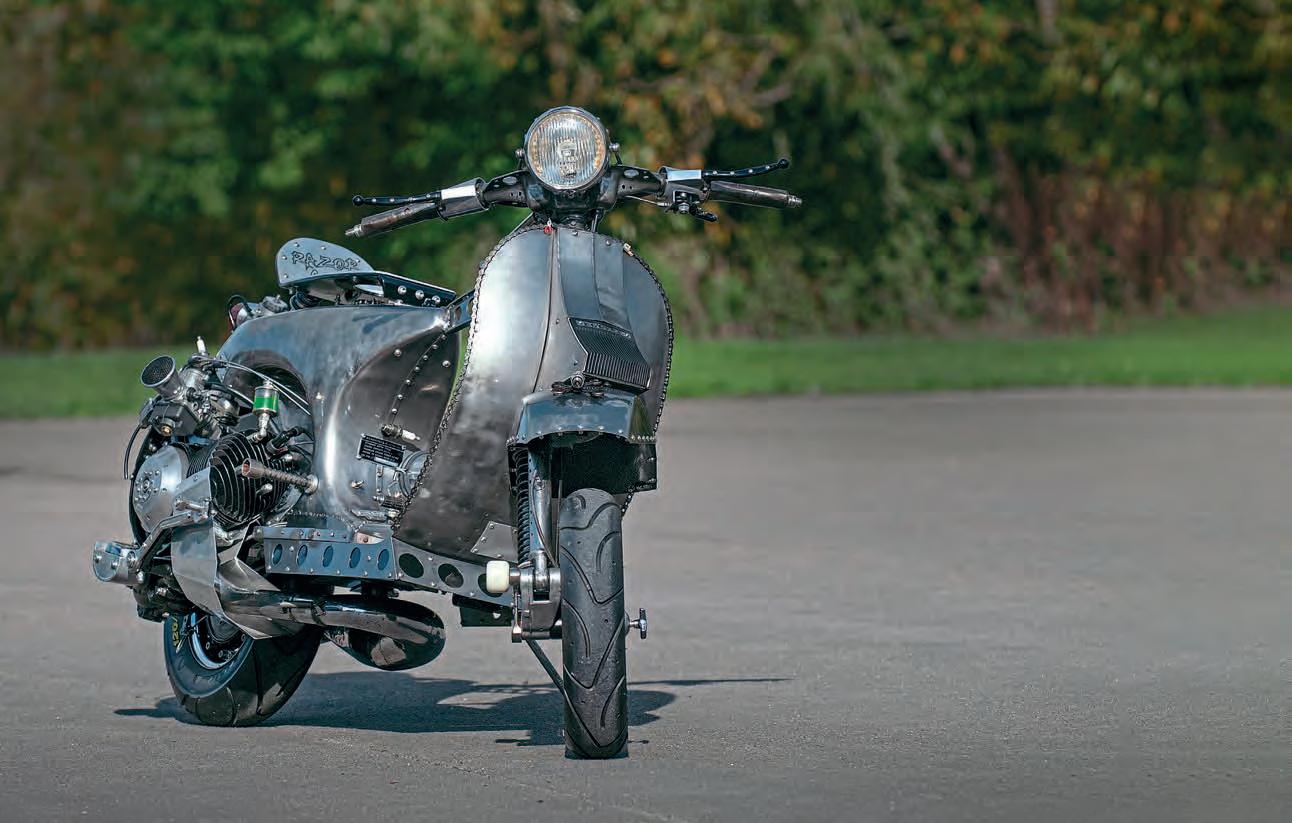
Name of scooter & reason: Razor Cola. The name given to Mad Max’s car, when it was stripped back to bare metal in the Fury Road film Keeps the connection with my other scooter Road Warrior
Scooter model: 1985 PX 125E
Time to build & by who: About six years on and off, started in 2014, built by myself.
ENGINE SPEC
Kit: Tuned Malossi 210.
Crank: Mazzucchelli (cut and flowed by myself).
Carb: 28mm Dell’Orto.
Exhaust: PM Tuning.
Clutch: Old style seven spring with Surflex four-plate conversion.

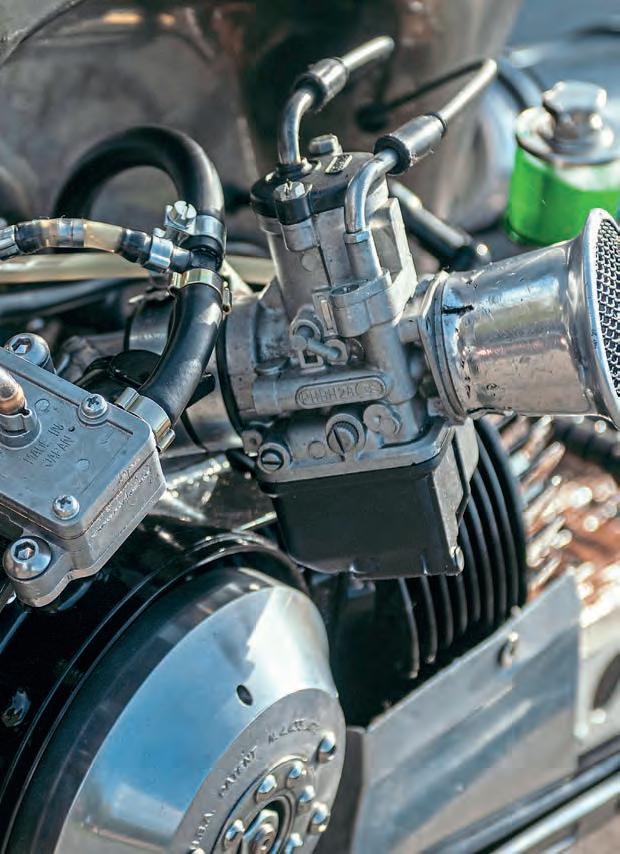
Gearbox: PX200E with T5 fourth gear.
Engine dressing by: Myself. Fins removed from standard flywheel, Direct cooling air scoop.
| SCOOTERING | MARCH
Back in the day my wife would get up at some ungodly hour and sit in the van, bleary eyed, for the journey to sunny Wigan. There she’d pass the time patiently with magazines and doze off in the deckchair while us boys played scooters, but nowadays she’s getting more involved and that really is a good thing.
The wives and girlfriends (and they are mainly wives and girlfriends) of BSSO bring a great dimension to the weekend world of scooter racing. They have their own social scene and can certainly party! I once gatecrashed a caravan party feeling proud that I’d armed myself with a tray of flapjack, only to find the girls drinking wine from crystal glasses and laughing a lot. Fair play to them. They also quietly reduce the levels of testosterone flying around and help to remind us all that it’s for fun (sometimes… ).
Don’t tell Boris, but some of the best parties aren’t held at Number 10 but are to be found in race paddocks around the country. Our partners have been influential in lightening the sometimes pressured atmosphere of a race meeting with food, huge curries, wine and fancy dress. The ‘Darlington ladies’ are the true masters of this art, and the paddock would be a

Party people
Our partners put up with a lot but they’re also more than capable of beating us at our own game.
poorer place to be without them.
Their sense of fun and the laughs they bring contribute greatly to everyone’s enjoyment of a BSSO track event.

Although the track has been devoid of female riders for too long, Nikita Donaghue’s recent success has demonstrated to everyone that scooter racing isn’t a male preserve. She’s become something of a hero to the ‘WAGs’ and team loyalties are set aside for them to cheer her on. It’s fantastic to see that sense of camaraderie and I sincerely hope that Nikita’s success encourages more women on to the track.

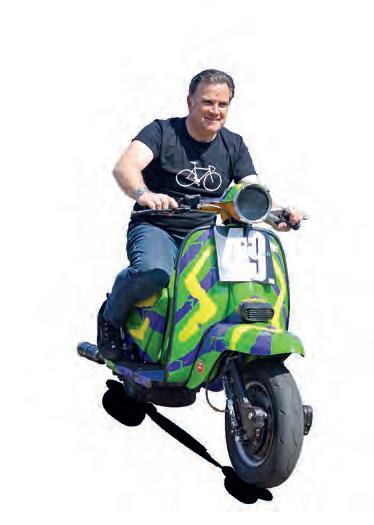
When you stop to think about it we have come a long way in the last 30 years or
so. Our partners have gone from being long-suffering ‘race widows’ to completely taking over parts of the weekend. I would say that they join in very much as equals but that’s not fair. The truth is that we ‘husbands and boyfriends’ are no match for their superior partying skills!
Don’t tell Boris, but some of the best parties aren’t held at Number 10 but are to be found in race paddocks around the country.
WWW.scootering.COM |
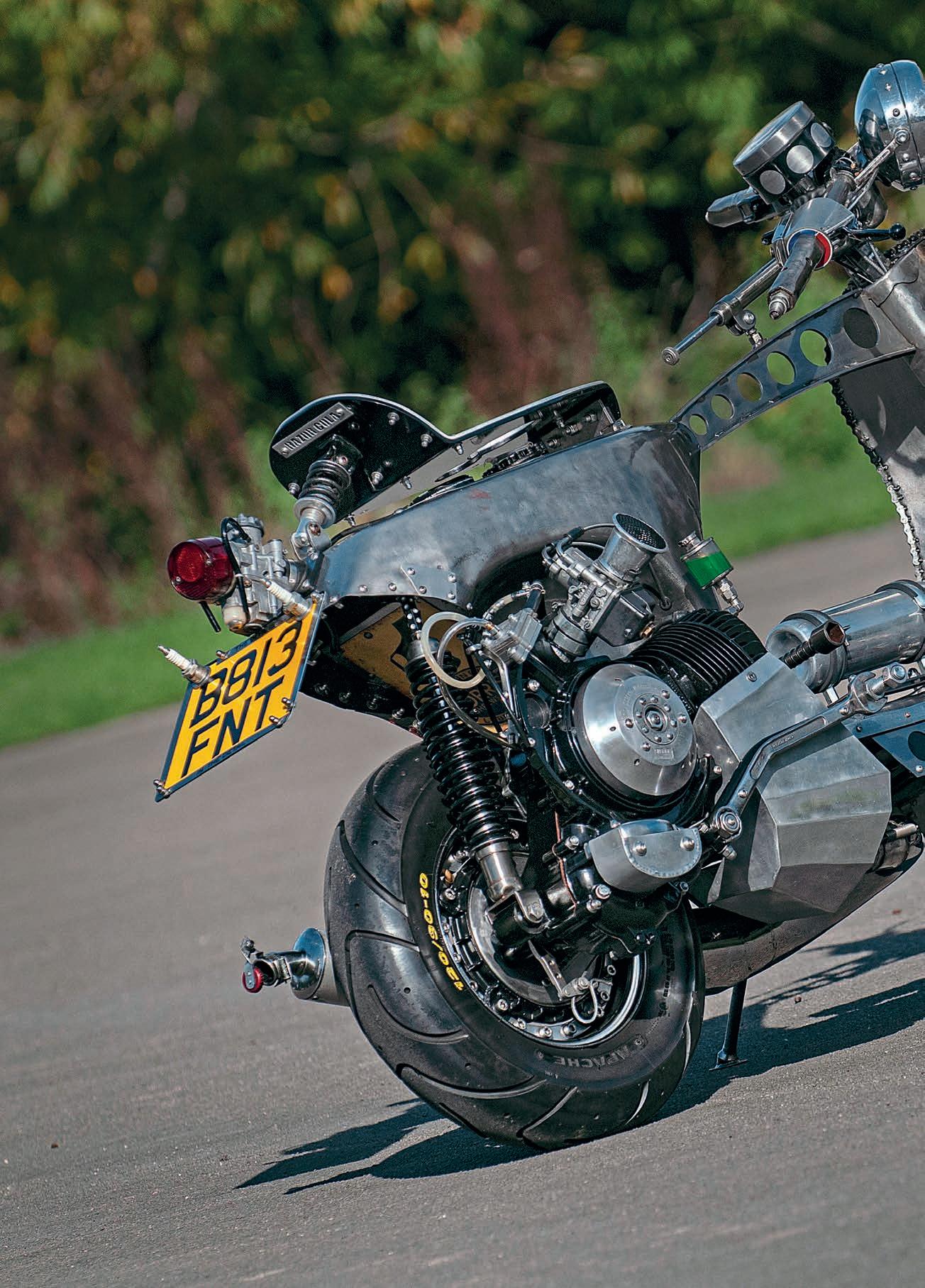
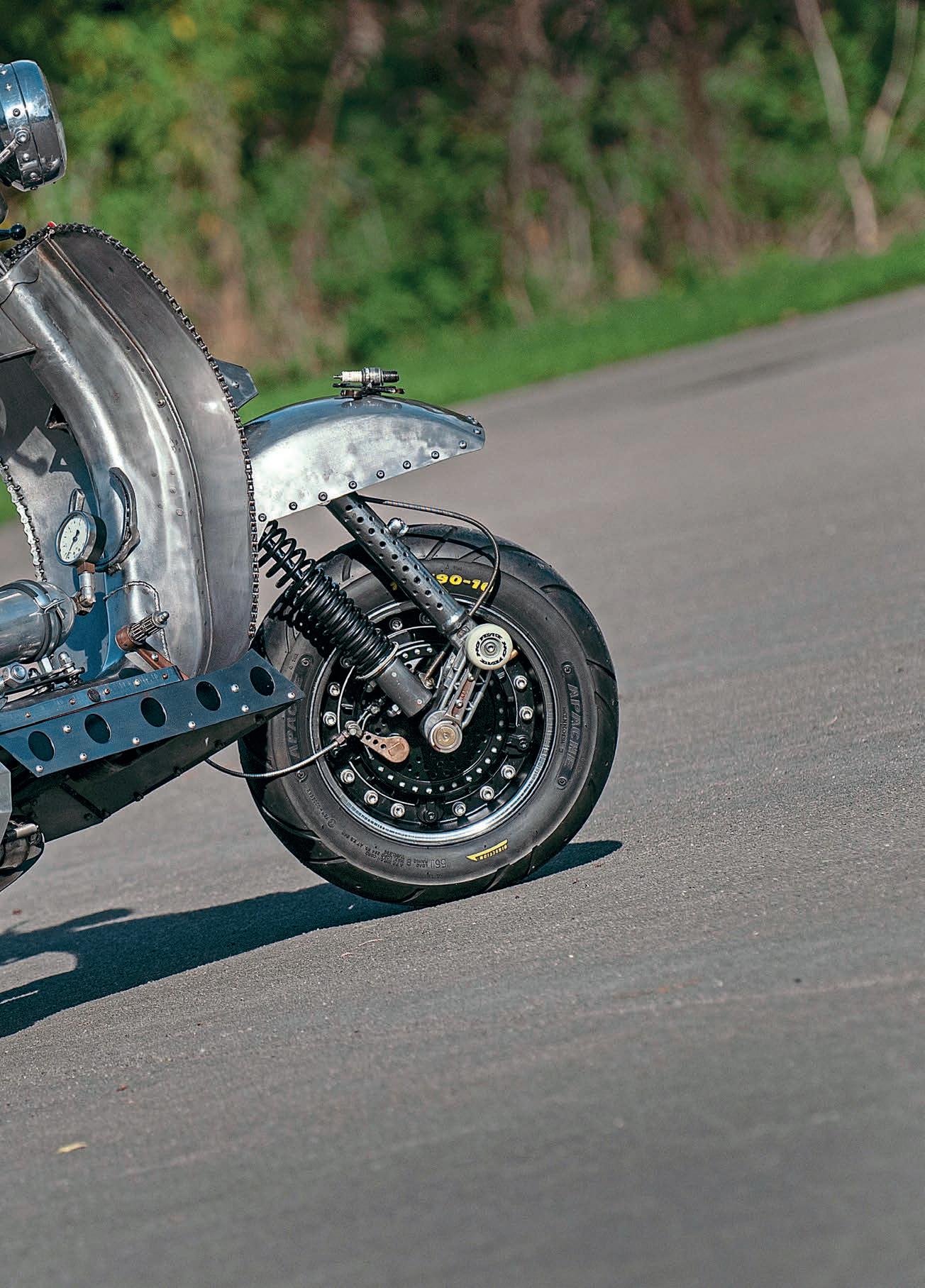
Latest rebuild, a Series 1.
A chip off the old block
Most of us know a ‘bloke in a shed’ who we turn to for repairs, upgrades and fixes For scooterists around Preston, that ‘bloke’ is called Helen

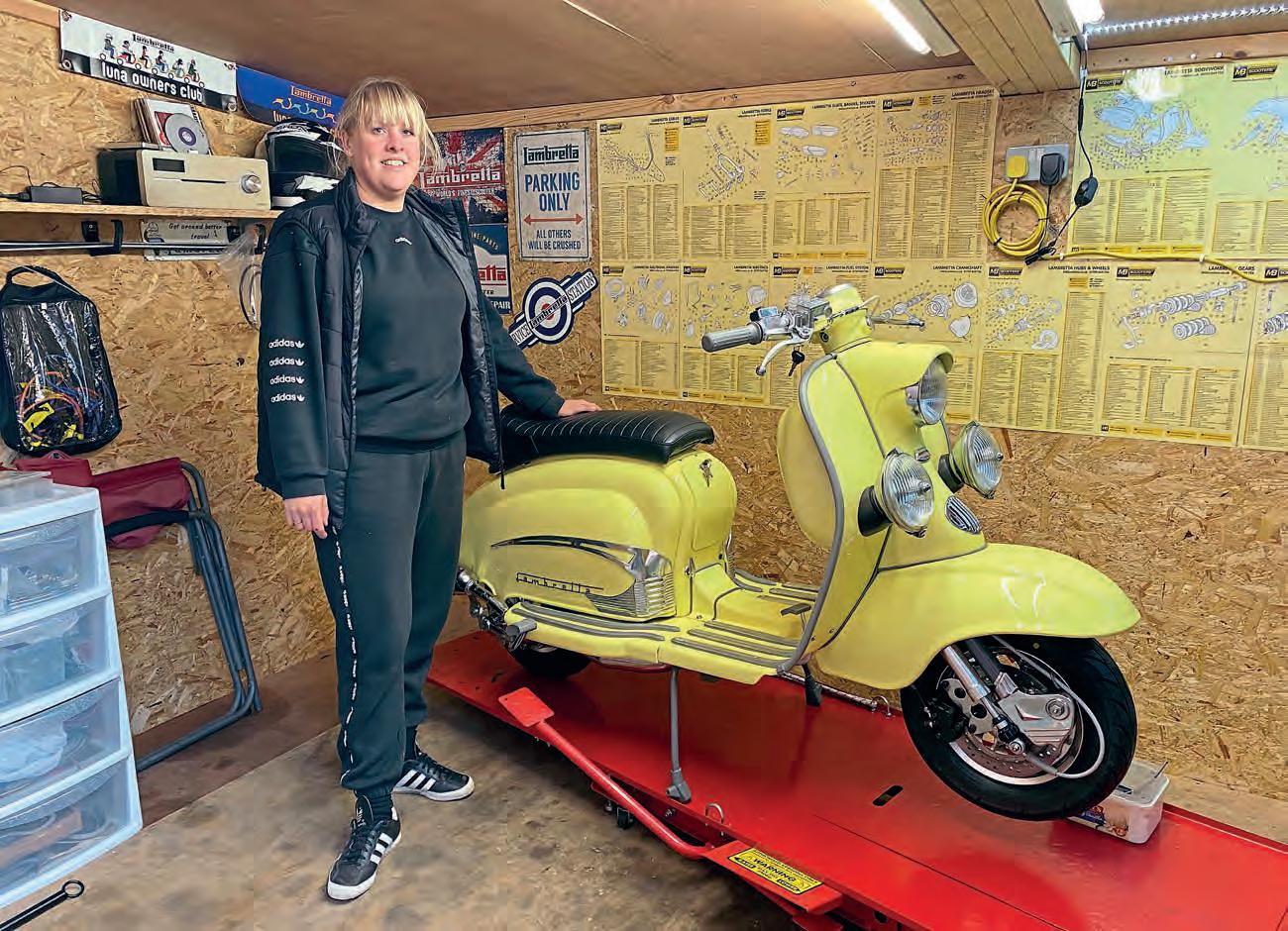
The scootering bug infected Helen Speak several years ago, with her partner Tony Parkinson shouldering most of the blame for her obsession. “I’d been riding pillion with Tony for about five or six years and I loved the whole scooter scene,” she began. “Over that time I decided that I wanted my own scooter, and I’m pretty sure that after five or six years riding pillion with Tony he wanted me to get my own scooter too!”
A seasoned scooter veteran, Tony’s built numerous machines over the years. Understanding Helen’s desire to get her own scooter Tony and his pal, Midge, decided enough was enough and they built
Helen her own scooter from bits they had lying around
The scooter emerged as Helen’s custom bike, The Grey Ghost, which is themed on Helen’s grandad’s Naval service during the Second World War. Its artwork was applied by Gatch and the engine set-up was a neat Richard Taylor GT186, supported by a 30mil Dell’Orto carb and a BGM big-bore exhaust
Far from being satisfied with now being able to ride her own scooter, the project spurred on Helen’s enthusiasm and appetite for scooter building.
Having helped Tony with several projects Helen decided that it was time for her to make the leap from ‘helper’ to ‘builder.’
At the workbench.
Having helped Tony with several projects Helen decided that it was time to make the leap from ‘helper’ to ‘builder’.
WWW.SCOOTERING.COM |
TALKING SCOOTERS
What was the first scooter build you were involved in and what part did you play in that?
“Tony’s custom Series 2 Lambretta, ‘Hatchets and Hammers’. I was mainly involved in all the fiddly bits; he hates doing the trim and running boards, so basically he gave me all the jobs that he didn’t want to do!”
How and why did that inspire you?
“From the moment I was involved with scooters I was hooked on them. When Tony was working on his scooter projects in our workshop, I was always very interested in how everything went together. It was like a big jigsaw, starting with the edges and working inwards.”
What was your first solo scooter build?
“My Silver Special; Tony got it off his friends, Lydia and Jordan, which he got at a good price. Goodness knows how much it was, but he helped them with their wedding by printing stuff for them so I’m sure they looked after him.”
What elements of support did you need to complete that?
“I’ve got all of Sticky’s books and I’m not afraid to ask for advice or guidance from Midge, Tom Perry and even Tony! The thing I found the most challenging was how the bearings and seals fitted.”
In terms of developing a paint scheme and overall style, what do you take into consideration?
“I have to admit, I’ve taken the odd hint or tip from some of the ideas Tony’s put into his scooters. The period and theme of the scooter is usually the main deciding factor; for example when we were building my
scooter, The Grey Ghost, I knew exactly what I wanted because it was always going to be a tribute to my grandad. With the Silver Special I wanted to respect the classic lines and keep it looking original.”
How do you plan and organise the engine set-up to get the outcomes you’re looking for?
“It depends on what I’m mainly going to be using the scooter for: distance runs; touring kit; pottering around; standard set-up.”
What are the first stages you need to take care of before you start a build?
“Paint stripping and shot-blasting, then getting to grips with any repairs that need to be done; after that it’s welding and powder coating.”

What part of a build gives you the most satisfaction?
“When it’s all together and fires up first time; that’s very satisfying!”
What do you do if you’ve made a mistake?
“I retrace my steps to see exactly what I’ve done, once I’ve discovered where I went wrong I make the fix and use it as a development opportunity so it won’t happen again. We all make the odd mistake here and there and luckily so far I’ve not made any costly howlers!”
What is the most annoying thing you encounter when you’re working on a build and how do you deal with those annoying moments?
“The most annoying thing is when Tony gets in the way, so when he does I send him into the house delegated to house cleaning duties!”
What is the most time-consuming part of a build?”
“Waiting for parts or paint.”
What ‘trick’ components have you fitted to a scooter?
“Top-end kits, disc brakes and a digital speedo.”
In the future, would you be looking to complete builds for others?
“Not at the moment, but I’d be keen to help someone with their project.”
Your most recent project is your Lambretta Series 1, please tell us about that.
“The bike was originally Tony’s and I wanted to complete the build from start to finish. In terms of the paint, that was something I was going to have to outsource. However, Tony and I had completed a couple of upgrades, disc brake, SIP speedo and GT kit on a friend’s bike, Stuart McDonald. Stuart owns JSM Vehicle Solutions in Preston and in return he offered to complete the paint on my Series 1 after I’d got it prepared. We did a deal, it was stripped in a day and I picked the colour. In the meantime, I’ve given it a full mechanical overhaul and given it a GT 200 top-end kit, with a 30mil Dell’Orto carb and a JL3 exhaust. As well as that it’s got a few custom chrome bits on it, I’ve also wired up and fitted a pair of Lucas Pathfinder lights, so now it’s all finished I’m ready for the start of the 2022 scooter season.”
I know that you’re a hairdresser by trade, so will you be hanging up the hair dryer and straighteners and replacing them with a socket set and tool kit anytime soon?
“Ha, ha. Not yet, but I’d love to do that!”
| SCOOTERING | MARCH
Engineering DNA
Although Helen’s early experiences riding pillion with Tony helped cultivate her interest in the scene, there may also be an element of genetics at play When Helen was completing her research into her grandad’s wartime service, she discovered that he’d been described by his commanding officer as “outstanding in engineering ability and an asset to the ship’s company”. Looks like the apple didn’t fall very far from the tree…

Words: Stu Smith
Photos: Tony Parkinson
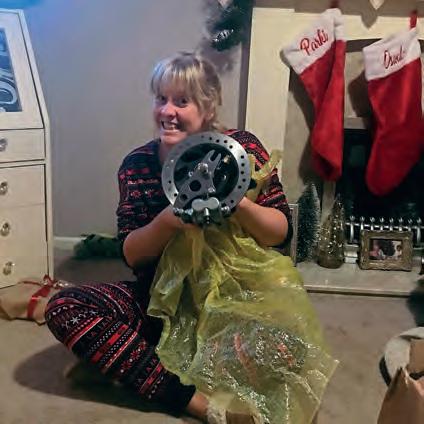
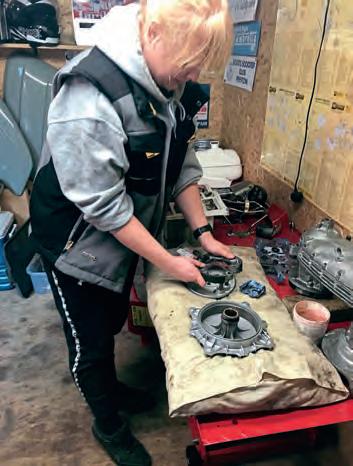
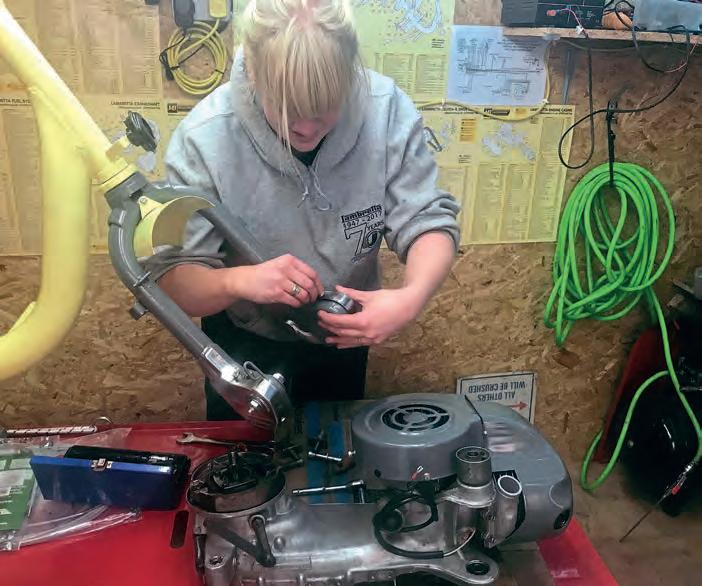 Helen and Tony with the scooter that started it all.
Helen and Tony with the scooter that started it all.
I was always very interested in how everything went together. It was like a big jigsaw
WWW.SCOOTERING.COM |
Time For Action?
Suella has been riding Vespas and Lambrettas since the 1980s and has no intention of ever quitting.


Whether it’s Roman Holiday, Quadrophenia or documentary footage of scooter sport, both male and female scooterists can always be seen. However, more often than not, those riding them are men. (Roman Holiday is a notable exception to that rule.) With a few notable exceptions, women are typically portrayed as the passenger.
Before anyone gets angry I know that isn’t the full picture. Back in the 1950s, many women did have their own scooters and for them, it was a way of transport. That was one of the main selling points of the motor scooter. The idea was that a step-through was far easier to sit on while wearing a skirt compared with trying to straddle over the frame of a motorcycle; it was an ‘acceptable’ form of transport and as such gave many women their first taste of independence. Scanning through scooter magazines of the 1950s, there aren’t just plenty of adverts aimed at selling scooters to women, there are lots of stories about their adventures. As time moved on that began to change and scooter ownership became much more male oriented.
To the outsider it’s easy to think that’s the way the scene has continued up to the present day. In some ways this magazine is guilty of perpetuating this impression. The majority of feature scooters are owned by men and pictures of rally reports often show women as pillion riders. I know that Stan wanted to create a ‘Show Us Your Scooters’ special for this edition but there were barely enough images on file of female riders to fill the page space. That doesn’t mean that women aren’t involved in the modern scooter scene; the
question is why aren’t they properly represented? One reason may be that as the world of scooters became more skewed towards male ownership, women were relegated to promoting sales. Adverts with them posing on machines were the given thing, indeed for many years the main contribution of women to this very magazine was as scantily clad decoration for that month’s feature scooter. That type of promotion is simply not acceptable today and ironically it may be why the female role has become less visible; little has emerged in the mainstream to replace the role of women as an ‘ornament’.
Having looked at the negative side of life, what about the positive? A visit to most scooter rallies will find a surprising number of female riders and there are several very active social media sites devoted to their interests. Just like their male counterparts many women who were active rallygoers in the 1980s and 1990s now find themselves with fewer responsibilities and more disposable income.
They too are making a return to the world of scooters but as owners and riders, no longer content with the role of pillion. A glance at the results for best supporting member championships illustrates the incredible amount of miles put in by women riders.
I may be wrong but, with some notable exceptions, it seems that fewer women ride classic scooters. Perhaps because
their historic role of pillion spared them from the necessary apprenticeship required to become involved with roadside repairs and routine maintenance? In any case there can be no doubt that the auto, be it Vespa GTS, Scomadi or Royal Alloy with their reliability and ease of use has helped more women get back on a scooter. Unfortunately that growth hasn’t been matched by the willingness, or perhaps confidence to tell that story.
We know that women are involved in the world of scooters but it doesn’t get reported enough.
So, here’s an appeal to all scooterists. Let’s make sure the role of women in scootering is properly reflected. Whether it’s you, your partner, your mum or your granny – let’s have those stories and set the balance right.
There has always been a healthy number of female riders but coverage of their activities hasn’t always been fair.
For many years the main contribution of women to this very magazine was as scantily clad decoration for that month’s feature scooter.
WWW.scootering.COM |

SCOOTERING
READER’SRIDE
It was during the early 1980s that Lisa Samuels developed her obsession with scooters and very specifically the metal-flake spray jobs of that era. Her first rally was the Isle of Wight in 1985, no small achievement as she rode her TV175 all the way from Pontypridd via A roads. “It was one to remember; not only was it my first rally but the scooter was constantly breaking down and I had to sleep in a doorway!”
The experience did nothing to deter her. Since that first expedition she’s been a keen rally-going scooterist and in 2016 attended her first European rally, Venlo in the Netherlands.
Destiny
In 2020 Lisa bought her 1998 Vespa T5, which was always destined for a full engine rebuild and of course that 1980s metal-flake spray job she’d always wanted.
With the support of her husband, Andrew, the build took around six months The T5 was legendary in its time, with performance that approached that of its larger capacity stablemates. By current standards it’s a little tame and the Samuels have wisely decided to spice up this T5’s performance. The engine was upgraded with a Malossi 172 kit, SIP head and race crank. Fortunately the extra fuel demand was satisfied without the need for a larger carb, the standard 24mm Dell’Orto only required up-jetting. A Cosa clutch manages the power delivery to the standard gearbox, a SIP 2 road exhaust takes care of the final chapter of the combustion process and handling is managed through Carbone shocks front and rear.
The custom reupholstered seat adds to the appearance, the one-off ‘Sparkle’ spare wheel cover looks great and as a neat finishing touch the clear indicator lenses blend in perfectly with the lines of the scooter.
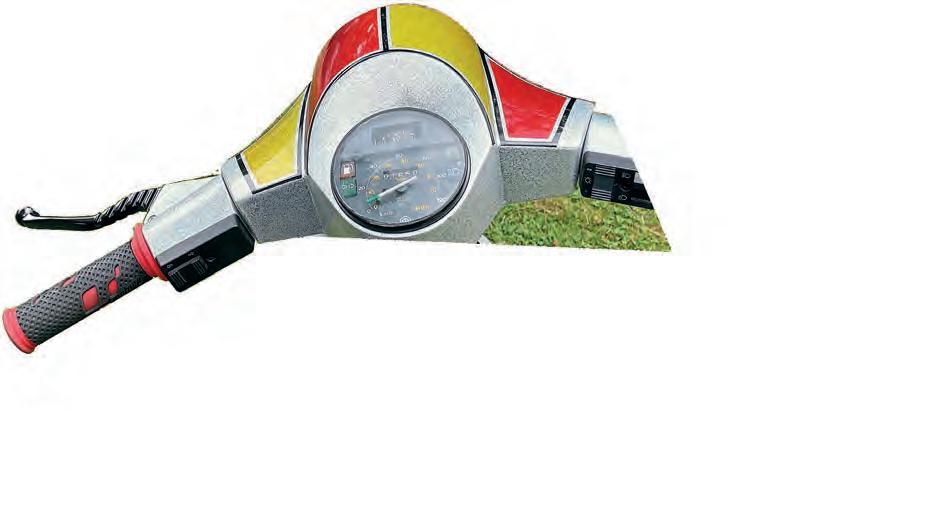

There’s something special about an 80s metal-flake spray job. Throw in a T5 and the result’s always going to turn heads…
WWW.SCOOTERING.COM |
SCOOTER SPEC
Name of scooter & reason: Sparkle, because it sparkles!
Scooter model: Vespa T5 1998.
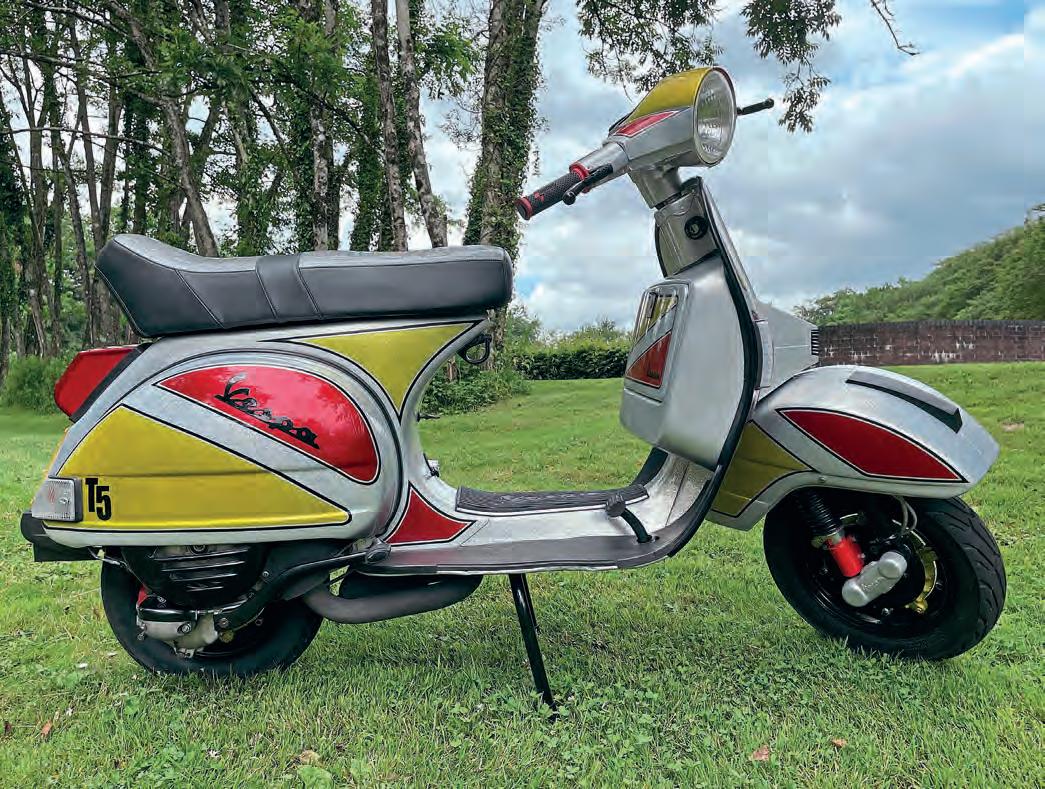
Inspiration for project: I’ve always loved 80s metal-flake spray jobs.
Time to build & by who: From start to finish, around six months on and off by my husband, Andrew.
ENGINE SPEC
Kit: Malossi 172 kit with SIP head.
Crank: SIP race crank.
Carb: Standard 24mm (up-jetted).
Exhaust: SIP 2 road.
Clutch: Cosa 21 tooth.

Suspension: Carbone Sports.
Seat: One-off by Peter Fryer, Pete’s Seats. Paintwork by: Andrew Samuels, my husband (Sammy).
Hardest part of the project: Spray job; masking up, pin-striping and building up the layers of candy and lacquer.
Tech tip or advice for anyone starting a project: Have a price in mind and double it!
Thanks to: On Small Wheels for the parts, Peter Fryer for re-covering the seat, and the biggest thank you is to my husband Andrew for all his hard work stripping and building the engine, spraying my design and finishing it off with many coats of lacquer and supplying me with the scooter I’ve always wanted.
...not only was it my first rally but the scooter was constantly breaking down and I had to sleep in a doorway!
Paint by Andrew, design by Lisa.
| SCOOTERING | MARCH
OWNER DETAILS
Name: Lisa Samuels.
Job: Print production assistant.
Scooter club & town: No club, just love riding.
First scooter: Primavera 125.
Favourite scooter model: Lambretta SX200.
Favourite style of custom scooter: No specific style, just admire the thought and attention to detail of the work that is put in.
What do you like about rallies: Meeting up with friends old and new who I haven’t seen in a while and soaking up the atmosphere.
What do you dislike about rallies: The ride home.
Favourite custom scooter of all time: There’s too many to mention but Dazzle, Sting in the Tail and Playstation.
Your most recommended scooter part or related item: A gel seat.
Favourite scooter dealer: Dai and Marie Payne, On Small Wheels, Swansea.
Couple’s therapy
In the best traditions of the 1980s this is very much a home-built scooter. The paintwork was designed by Lisa and applied by the ever-resourceful Andrew, who also took care of the engine build and powder coating.
The silver base metal-flake sets things going while the red and yellow features draw out the 80s feel. There are neat graphics around the scooter, which reminds the onlooker of the scooter’s pedigree and the pin-striping reinforces the 80s styling. The paint pops in the sun and radiates a sparkle, which captures your attention and brings back those fond memories of misspent 1980s summers.

Eye-catching
The scooter looks great, it’s a real eyecatcher and everything is delivered with style and taste Along with this, the fact that it’s been built by Lisa and Andrew adds to the joy of this whole project. Together they’ve developed a scooter which ticks all the boxes. The set-up’s well thought out, it delivers excellent acceleration, performance and reliability, and as well as this the modifications are hidden, which keep the scooter in touch with that 80s look that Lisa loves

Words: Stu Smith
Images: Carl Smith
That 80s feel.
Lisa, loving rallies since the 80s.
WWW.SCOOTERING.COM |
Martin’s Li150 Series 2

The story behind Martin Hather’s scooter is a little back-to-front from the normal way most scooterists would start a project – he built the engine first and then needed a scooter to fit it into.
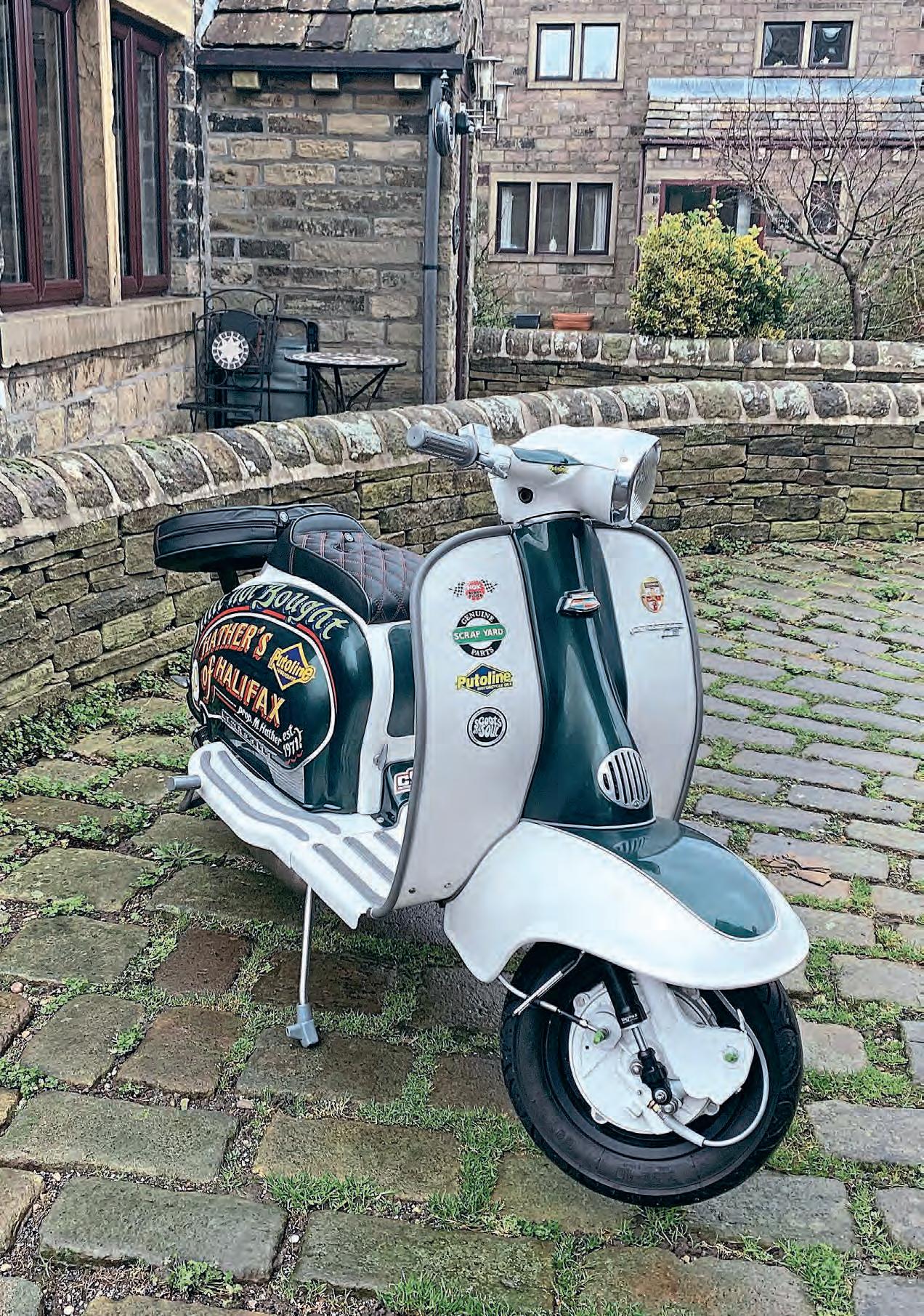
BUILT NOT BOUGHT
WORK IN PROGRESS
Martin has been into scooters since before he was even old enough to ride and it has remained a passion throughout, from that first moment he saw one almost 40 years ago – we’ll let him tell his story, from the early days, right through to present times.
I first became interested in scooters around 1984/1985, while still at school. A few lads used to turn up on their Vespas at lunchtime; I thought they looked cool at the time, with their double denim, donkey jackets, Doc Martens and piss-pot helmets with (HXSC –The Fleet) club stickers on the back.

A few years, later my brother joined HXSC, but unfortunately (or fortunately) the club folded around 1987, so I was never a member. However, out of the ashes, a new scooter club was formed in 1988 – The

Halifax Elite. I already knew the founding member of the Elite, Tim Crabtree, as we went to see The Style Council at Manchester Apollo in 1985.
I eventually bought my first scooter (a Vespa P125X with a Pinasco 180 kit) and while out and about, I bumped into Tim at the local petrol station. Once we’d recognised each other, I was invited to come along to the club meetings, which took place every Sunday night in Lee Mount, Halifax. The club hadn’t been going very long at that point and I’ve been an active member ever since.
In all fairness, the other club members (some originally from The Fleet) are to me, the salt of the earth; there’s nothing they wouldn’t do to help out with a problem. And we’re all quite close these days – let’s be honest 30 years-plus isn’t too shabby.
OWNER DETAILS
Name: Martin Hather.
Profession: Engineering consultant.
Scooter club: Halifax Elite.
Club meeting place: Halifax/our house.
Favourite scooter model: The SX200 is a beautiful-looking scooter; very stylish (no I haven’t owned one – yet).
Favourite custom scooter style: I like all types of custom scooters. I admire the engineering work on cutdowns and chops and some of the artists’ paintwork, etc. (You could argue that things are a little ‘same old’, ‘same old’, but every now and then, something comes along and you’re left thinking ‘bloody hell, that’s nice’.
Other scooters owned: 1966 Li125 (Rapido/Honda 205 engine). 1961 Li150


Series 2 (old skool cast-iron Honda 205 kit). 1971 GP200 (standard).
Funniest scooter-related experience: Many – most unpublishable.
Happiest scooter memories: Holiday in Holland.
Other hobbies: Can’t afford any other hobbies (but I do build the occasional engine here and there).
Favourite dealer(s): Chiselspeed and Pete Merchant.
How would you make the scooterist scene better: Ban ‘comedy Mods’. Magazine articles you’d like to see: More on unsung heroes –folk who do everything from their shed/garage, this shows people what can be done.

Thanks and mentions: A big shout to all the members of Halifax Elite SC; you lot keep me sane (which I’m sure isn’t easy). Special thanks to Martin and all the team at Chiselspeed for all their help and advice over the past 32 years or so; most of my engines have been tuned by them (I think it’s now well over the 30-plus mark). Pete Merchant for all his help and advice over the years. Bob Monkhouse for all the help and major mickey-taking when I mess up! Andy Francis for help and advice, and being there on the rallies when you need someone/something. Last, but not least, my wonderful wife Philippa, for putting up with me, especially when I fill the house with scooters and parts, and the relentless hours in the garage.

111MAUSPENCER@CLASSICSCOOTERIST.COM
On the runs…
BOUGHT
FIRST SCOOTER
As already mentioned, the Vespa P125X was my first scooter. I bought it when I was 16, ready to hit the road as soon as I turned 17. I rode it around for several months until the big end bearing failed. I stripped the engine and had the crank rebuilt (Lens Scooters, Shipley), rebuilt the engine, and off we went again. A few months later, the rear brake pedal literally fell through the floor. I eventually swapped the frame with a fellow club member, as he wanted a cutdown (as you do); the scooter I’d ended up with was slightly cut down (legshields and panels, with the obligatory motorcycle petrol tank welded in the middle of the frame). The engine was taken to Chiselspeed in Leeds, where a reed valve, Micron exhaust, AVAC exhaust valve system and gear up kit etc. were fitted.
I managed to do a few rallies on this scooter, until ‘Mr Magoo’ decided to railroad me off the road – that was the end of that scooter, although I did manage to salvage the engine!
RALLY RECOLLECTIONS
I think my first rally was either Morecambe or Aberystwyth in 1988. I would have been in the back of a van for those two. My first ridden rally was Great Yarmouth in 1989. It was eventful to say the least; I borrowed a mate’s scooter, Rollerball, a custom scooter painted by Trotsky from Halifax, who was quite well-known at the time. The scooter was an old-type P200X and on the way to Great Yarmouth, I had a front end blowout, resulting in me leaping off the scooter in mid-air, while the scooter tumbled down the road


after me. All was not lost, and I did make it to Great Yarmouth and back – unfortunately resulting in getting nine points on my licence (but that’s a totally different story)…
The best rallies for me were the ‘Holiday in Holland’ ones (at Borculo). We had such a laugh (normally at my expense).
I do prefer the European rallies – and that’s not taking anything away from the UK events put on by VFM, etc., without whom we would literally have had nothing to do in the late 80s/early 90s.
Everyone will have a different tale to tell, but rallies are what you make of them; for me, Skegness was always a massive letdown, mainly due to the poor campsites and
torrential rain that always seemed to bless us over the weekend.
Rallies are great to get away with your club/mates, all doing something you all have a similar interest in; meeting up with like-minded folk, and talking ‘bollocks’ all weekend (to be honest, that’s normally me)!
REVERSE RESTORATION
The project took me around six months to finish (the frame and panelwork had already been painted and the engine was ready to drop in and I’d taken the panels for signwriting to Alistair Isle in Barnoldswick, Lancashire, who still does the old barges
BUILT NOT
and shop signs. The scooter’s original engine was substituted for the Casa SS240 (the engine casing was an Italian Li125) that I’d previously had welded by Oiltek in Barnsley. This was then taken to Chiselspeed in Leeds, who worked their magic to fit the 62mm x 110mm crank, and graft the Casa SS225 kit upon it. This was later put on their dyno (29bhp once finished).
I decided to go down this route as I have many 125/150/175 engine casings – so why not? As we were fitting the longer stroke crank, the casing would need machining out to take this, so all sealing faces were machined up at the same time.
The casing was then despatched to Midas Touch for powder coating, along with several other items.

The whole project cost around £8k. It went
together quite well (I suppose setting up the hydraulic conversion was the hardest part, but really that was quite straightforward too). If starting the project again, I don’t think I’d redo anything differently; I have changed a few things since the original completion – but most of my scooters are a ‘work in progress’ anyway. The one thing I still have left to add is a five-speed gearbox (I have this, but haven’t got around to fitting it yet)!
[This article came to Classic Scooterist as a result of a selection of Martin’s nostalgic images of his Holsten GP scooter; these can be found on page 107 of this issue, in our Back When We Had Hair feature].
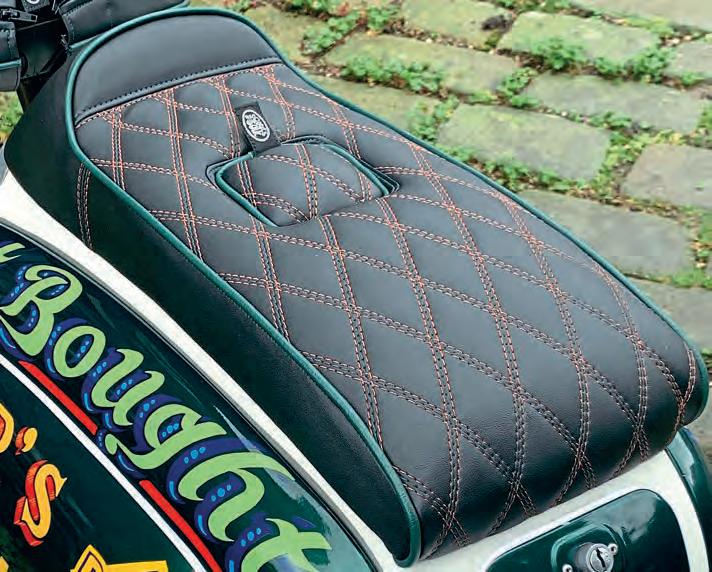 Words: Mau/Martin Hather
Images: Martin Hather
Words: Mau/Martin Hather
Images: Martin Hather
SCOOTER DETAILS
Scooter name: Hather’s of Halifax (I’m the proprietor – a little pretentious I’m sure).
Model: Lambretta Li150 Series 2 (Italian).
First registered in UK: October 1960 (as Wallasey, Liverpool).
Purchase details: Bought in May 2018 as a project in boxes. Purchase price: £1800. Paintwork/murals: Alistair Isle, Barnoldswick.
Body alterations: No frame alterations on this one, other than the legshield toolbox, Oiltek tank, and hidden hydraulic master cylinder.
Specialised parts: Legshield toolbox; Oiltek tank (one-off); hidden master cylinder (opposite brake pedal); original disc brake converted to hydraulic by Chiselspeed; fuel pump; one-off seat and spare wheel cover, done especially for me by Scoot & Soul – excellent quality.

Engine spec (see below):
Li125 casing, welded and machined to 200 specification. Casa SS225 kit (porcupine cylinder head). Chiselspeed 62mm x 110mm crank. BGM stator; Indian mid-weight flywheel; Chiselspeed M Tech advance retard ignition kit. Dell’Orto 34mm flat slide carburettor, with Mikuni fuel pump. LTH seven-plate clutch. Casa Pull Me/Push You chain tensioner Octopus lathe shaft and rear hub.
Chiselspeed sidecasing, Easy Pull clutch system (makes clutch light and easy to pull). Italian Li150 gearbox, running 17t x 46t sprockets. SIP tubeless rims. Chiselspeed CST 7 under the kickstart exhaust (electroless nickel plated). Speed and reliability: Reliable so far. Top speed is 90mph, cruising speed is 55-65mph.
Any tech tips: Do as much as possible yourself, it’s the only way to learn. Listen to people’s advice, but don’t ask 20,000 people the same question, that doesn’t help anyone. Find a dealer that you can talk to for advice and that you can trust or has been recommended.
Other advice: Make sure you’re buying something as complete and straight as possible. Good panelwork, etc., is hard to find and can be quite expensive.
113MAUSPENCER@CLASSICSCOOTERIST.COM
Culture & Customisation
The motor scooter story


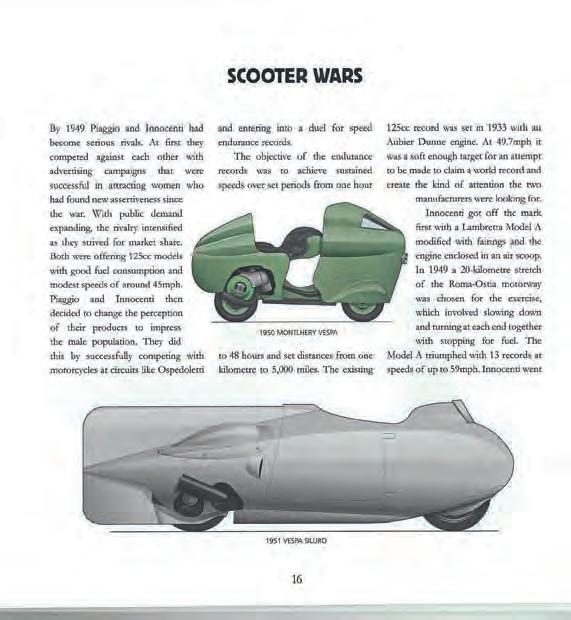
Author: Barry John
Publisher: Evro Publishing, 2022 ISBN: 1910505749, 9781910505748
Length: 112 pages
Price: variable, depending on source
This ‘coffee table’ style book is the latest publication to come from the pen of Barry John, who has written books on many different subjects ranging from architecture to sport, taking in various other subjects along the way. Although the author obviously has a pedigree of writing books I must admit that his name was unfamiliar to me prior to receiving a review copy of this book. As far as I can ascertain from his personal synopsis, he first owned a scooter back in the 1960s and has maintained a love of the lifestyle ever since.
There have been many similar books written along the same subject lines in the past and for anyone reading this particular book who already has a well-seasoned historic interest in scooters, it doesn’t really provide much in the way of new revelations to the subject matter in hand. Where it might score an audience is in the hands of the scooterist just coming into the world of scooters and looking for an overview of the history and lifestyle – note I said ‘scooters’ there and not specifically ‘classic scooters’ because the book’s subject matter is very wide ranging. The book takes the reader through the evolution of the scooter (of which the Lambretta and Vespa marques play a major part) covering a plethora of obscure and eccentric machinery along the way. Aside from the scooters themselves, other related lifestyle areas receive generous
attention with the book covering everything from scooters being a fashion accessory for 1950s movie stars, through to becoming the style-conscious choice of transport for the ‘Swinging Sixties’ scooter generation, then ending with them becoming idols worshipped by today’s retro-loving scooterists.
The pictures and graphics used to illustrate the book are a mixture of a few nostalgic historical images (many previously seen before in various other publications) coupled with a large number of perfectly drawn illustrations. Unless I’ve missed it, I can’t see any acknowledgments to the origin of either pictures or images within the book’s pages, so the source of these is uncertain and uncredited – but given that Barry John studied at Harrow School of Art and worked as a graphic designer, I can only assume that he was responsible for creating those superb illustrations (the quality of which are a credit to him).
In summing up, for someone who has little knowledge on the background of scootering, this ‘coffee table’ style of book would be
a good starting point for providing some of that missing information. The book does not show a cover price, but a quick search of the internet reveals prices ranging from £13 on FleaBay through to purchasing it directly from the publishers (£20) with various other internet purchase price options available on the way; so given that information, it would be an ideal book to be given as a birthday present for its reasonable cost in a world where a more in-depth book on the subject matter could currently cost you anything up to £75. The seasoned scooterist reader, however, would likely be looking towards the more expensive option, a book which provides much more focused and detailed information – in fact two, or even three books, given the book’s ambitious all-encompassing title – as one ‘coffee table’ book effectively providing one chapter on each subject area cannot hope to do that. Having said that, fair play to the author for playing on his strengths as an illustrator to bring this book to life.
Mau
WWW.CLASSICSCOOTERIST.COM114
BOOK REVIEW
Lambretta D/LD 125/150
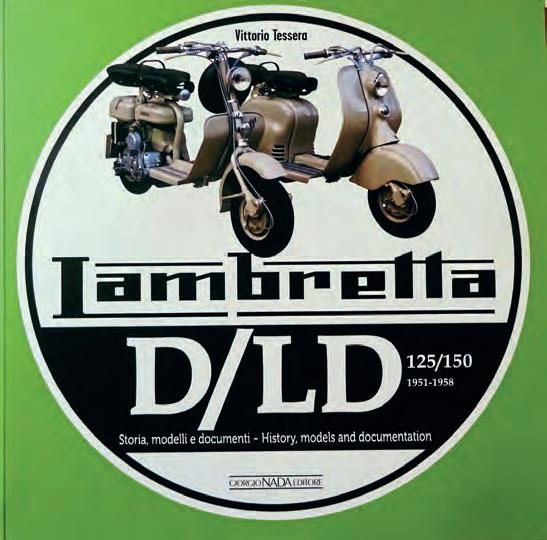 Author: Vittorio Tessera
Publisher: Giorgio Nada Editore
Author: Vittorio Tessera
Publisher: Giorgio Nada Editore
ISBN: 978-88-7911-811-8
Length: 120 pages
Price: 35 euros (review copy purchased for £38)
This impressive volume is the fourth book in a series featuring individual Lambretta model groups, all written by one of the world’s most renowned experts on the subject of that universally acclaimed make of scooter, Vittorio Tessera. This title follows the layout of the previous volumes and ably fills a missing period in the Lambretta marque’s history, covering what are arguably the most successful scooter model ranges produced by Innocenti, the D and LD. It must be kept in mind that it was no mean achievement that the final output tally from the Italian factory of these machines reached just under 600,000 units.
The D/LD machines proved to be the high point in the development cycle of the shaftdriven Lambretta – a design with its genesis in the late 1940s with the inception of the Model A. These shaft-driven models were only superseded towards the latter half of the next decade (1958 in fact, when it had become apparent that no meaningful upgrade of the D/LD concept was viable). The Innocenti design studio had previously looked to the future for a replacement model, incorporating many of the concepts both utilised by and considered for the D/LD along the way, but had taken a major step from the engine and chassis principles of these earlier machines. In so doing, not one but two completely new engines and an improved new chassis type were designed and were to become known as the first series of the Li/TV range that

would effectively, with modifications, take the Innocenti company’s Lambretta production up to the closure of the Lambrate factory in the early 1970s.
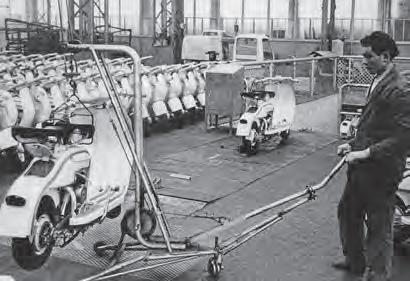
As mentioned, this Lambretta D/LD volume fills a gap in the narrative of this book series.
Vittorio Tessera’s masterful, if sometimes critical, prose comes from an individual in total command of the subject matter and, unlike many other books on scooter-based subjects, Vittorio’s text can be used as a primary and reliable reference source. In this volume, the subject matter is largely outside the comfort zone of most scooterists, as only a very few are now of the age where they can remember the D/LD as an everyday means of transport, let alone actually owning one. However, to amplify the brand’s importance, it should not be forgotten that the huge sales success of these Lambrettas in the UK at that time rendered the word ‘Lambretta’ into the English language as a common title for all scooters, regardless of make, in the minds of the man (and woman) in the street.
Towards the end of the volume there’s an interesting, but all too brief chapter on the nonItalian production and marketing Lambrettas. Most scooter enthusiasts are aware of the UK importers, Lambretta Concessionaires, and the Spanish Eibar/Serveta production line (second only in output to that of the Italian factory, as it happened) but other manufacturing markets mentioned lack that sort of familiarity, such as: Argentina, Brazil, France, Germany and India, countries where licensed production lines of varying complexity that matched the pre-existing engineering capabilities of these individual states were set up. Here, sadly, Vittorio’s book only details the Argentinian ‘Siambretta’, as it was christened in that country. As a point of interest, Argentinian
production figures of the D/LD have been estimated at 120,000 units. Perhaps one day we will see yet another book from the same stable that will lift the veil on these other rarely documented manufacturers and their histories – we shall see?
As well as relying on his vast experience, Vittorio is the guardian of the Innocenti Lambretta archive from where many of the images seen in this book are derived. He is also the curator of the Rodana Scooter Museum, just outside Milan, where many of the pictures of the actual machines gracing the book’s pages are taken. As an aside, one of the most generous contributors of some of the Lambretta-based articles in Classic Scooterist, Howard Chambers, has two of his restored LDs – the Riviera and the Mayfair (UK Lambretta Concessionaires ‘specials’) – featured alongside the text. Both are on long-term loan to the museum.
All in all, a beautifully produced book printed on expensive paper that helps bring out the quality of the pictures and the many line drawings contained within the covers. Having said that, it’s to be hoped that our review copy does not mirror the entire print production run, as near the back of our book, 24 pages have been inadvertently inserted into the spine upside down. To put it mildly, this made the book a little awkward to read and, bearing in mind the cover price, a little more care and supervision at the printers is obviously in order.
115MAUSPENCER@CLASSICSCOOTERIST.COM
BOOK REVIEW
Dave D
Inside the Lambretta factory.
LD line drawing. 1951-1958 Storie Modelli E Documenti/History (History, Models and Documentation)
Turismo Veloce facelift
Paul Carter refreshes his already beautiful Lambretta Series 2 TV175.

AN ACE UP ONE’S SLEEVE
Paul Carter from Leeds, West Yorkshire, was featured in Classic Scooterist back in 2016 on what was then his newly finished dream scooter, the wonderful Lambretta TV175 Series 2. Paul had always wanted to own a second series TV and had been collecting parts for the planned project for a while.

Finally, in 2012, Paul managed to find a frame, complete with a lot of very rusty bodywork in need of a full restoration and the process of building the scooter from the ground up out of boxes of bits began. The build was undertaken to Paul’s specification and very exacting standards; and with the subtle smattering of period accessories and personalised items that he had already collected, it makes this much sought-after model a truly individual machine.
So, to change the appearance of the scooter by adding and changing a few things here and there, while still retaining the cool look of this rare beast was always going to be a bit of a gamble – but one that Paul was willing to take and I think he has pulled it off perfectly.
STRIP & REBUILD POKER
The Lambretta TV175 second series was launched by Innocenti to the Italian market on March 9, 1959, but wasn’t available in the UK until several months later. This new model

117MAUSPENCER@CLASSICSCOOTERIST.COM
was initially only supplied in Glacier Blue and cost £189 and 10 shillings.

It was a totally revised version of the TV Series 1 and for the very first time in Lambretta history, it saw the headlight positioned on the handlebars and able to turn with them, rather than being a fixed item located within the horncasting.
Paul’s machine is a late production model supplied to the British market, but not registered until March 1962 in Coventry. The ‘rusty remains’ were found in a terrible state not too far from where he lives, but it was the machine that Paul had been looking to own for a long time and the poor condition it arrived in made it the ideal base to build something very special.
After Paul had once again used his contacts from his previous SX200 build, along with his own vision and input into how he imagined the finished item to look, he was now the owner of something very special indeed.
HEADS YOU WIN;TAILS I LOSE
So, what now? Paul was over the moon with his finished machine and had up until now loved the fresh, clean, uncluttered lines, resisting the adornment of more ornaments, opting for the sportier-looking front end rather than the full-on Liberace chandelier approach. But since he was now hooked on the thrill of sourcing and collecting rare scooter jewellery, and he had amassed somewhat of a pirate’s chest full of stuff, he couldn’t stop thinking about refreshing the look of his pride and
joy, but wanted to give the scooter a facelift without too much of a radical change.
In the end, after the toss of a coin, he took a chance and went for it, but in a very sensible way, choosing to get a second set of side panels as an alternative and a front rack full of shiny stuff that could be easily removed if he so wished.
ROLL THE DICE
Since having completed the original build on the TV175 back in 2016, Paul had always seemed to be thinking of other things he could do to give it a slightly different look, but without taking too much away from what had already been produced.
In the end he decided to have the option of a second set of panels painted and make good use of an old screen which he had found some time back and which had been stashed in a box in the garage gathering dust for ages. Paul took the screen and panels to Terry Inman at Panel Paint Shop who does all of the painting for him and basically gave Terry creative licence, based upon his eye and his ability to come up with something from some simple ideas that Paul had given him.
When Paul was called to say the screen and panels were finished and to come over and have a look to see what he thought, he was not in the slightest disappointed with the outcome as they work really well with the rest of the paint scheme. Paul’s idea was to be able to rotate the panels with both sets working well with the rest of the scooter yet giving it a completely different look.
Along with many other period items Paul has collected (he had some original dice decals which had been stored away for years), he decided to try and give the scoot some kind of a theme and the dice decals seemed to fit in well with the Ulma badges on the fork embellishers and rear wheel spinner, which depict the playing card suites. It now seems to have a kind of gambling theme.
However, that said, Paul states that he is not into gambling at all; he just had the dice decals to hand and wanted to use them along with the card suits and thought they looked pretty cool together.
JACKPOT
In the original feature back in 2016, Paul stated he was keen to avoid the look of a front rack full of lights, as this was the usual ‘Mod’ style adopted by the owners of a Series 2 Lambretta. But to be fair, that look is pretty much on the money when it comes to Modernist customising of this particular bodywork style, which is obviously why so many have chosen to go down that route.

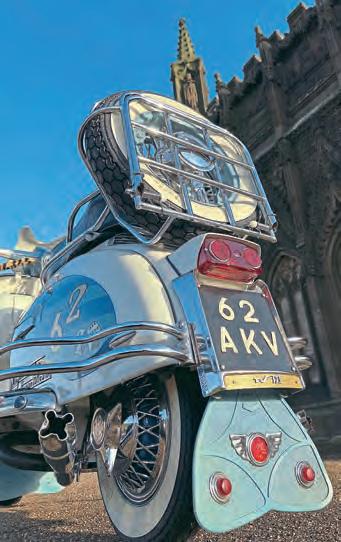
Eventually, the more that Paul looked at the TV Series 2 scooters with racks and lamps, the more he realised why folk do it, as these machines, when done well, are some of the best in the country, if not the world.
Paul went with his instincts once more and decided he would have a go at emulating the style, but still wanted to do it a bit different.
Again, Paul is very pleased with the outcome and how the use of all his sourced original shiny stuff has worked out, and he is
WWW.CLASSICSCOOTERIST.COM118 AN ACE UP ONE’S SLEEVE
also very happy that he went with the idea of having a second set of panels done so he can rotate the look as takes his fancy.
BLACKJACK
Regarding the specification of the motor, Paul wanted it to look as original as possible, but to add his own twists. The engine has a Mugello 186 top end with a GP200 crank and gearbox; it breathes through the original wide-necked airbox and scoop with an upjetted Jetex 22mm carb. A BGM 12v kit was also fitted.



The specially modified 42mm Clubman twin tailpipe exhaust was an absolute pleasure to hear and see as it roared away down the road with clouds of two-stroke smoke from the cold motor being expelled into the crisp cold air. This is the second incarnation of this exhaust as the clover leaf tailpipes now stick out at a slight angle rather than the straight exit from the original build.
Once again, this fabrication work was undertaken by Phil Varley of Torch Engineering who was responsible for the original build.

KENNY ROGERS
Well to say that Paul states he isn’t a gambling man, I think the decision to take a chance on creating a new twist to the look of his original design was a brave and potentially risky one that could have become a rather costly mistake. But as the saying goes ‘Who dares wins’ and I think ‘Cool Hand Carter’ has come up trumps with this ace way to refresh what was already a diamond of a machine.
[For those that are interested, the picture shoot was taken in front of Chantry Chapel, one of only four remaining bridge chapels in England. It is located on what is called Wakefield Bridge (more commonly known as Chantry Bridge to the locals). It was built between 1342 and 1356 and is still an active place of worship. Being local to the area I have crossed the bridge more times than I can remember and have obviously noticed the building, but it was only during the shoot that for the first time I truly appreciated what a wonderful wellpreserved chapel it is].
Big Chris
Zündapp Suburbanette

The ugly duckling among the beautiful sisters.
When the Zundapp Bella was introduced in the spring of 1953 with the R150 model, it attracted worldwide attention. At last, a vehicle that combined the elegance of a scooter with the handling characteristics of a good motorbike. While most Zündapp importers ordered this model, the International Motor Corporation (IMC) from New York hesitated.
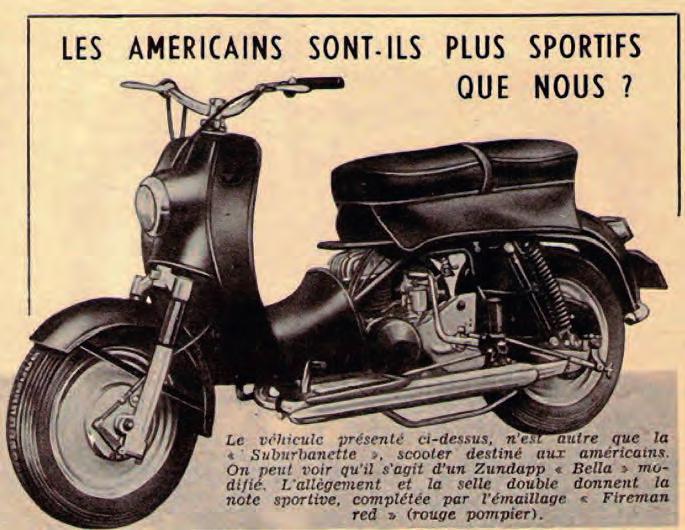


Against the background of the spartan and cheap scooters from Cushman, Mustang and other American suppliers, Joe Berliner (CEO of IMC) wanted a simpler version of the Bella for the US market. Since he was paying in hard dollars and had already ordered other special models in Nuremberg, Zündapp was willing to supply him with what Berliner had in mind.
Following the motto ‘Reduce to the max’, the Bella was stripped down at the factory. Front wheel mudguards and the rear body with the single seats were omitted. Another feature was the shortened running boards and the special double seat with an extended seat cover that covers the tank and the upper frame tubes. If you look closely, you can see many small details that distinguish the Suburbanette from the Bella R150 – from the wider handlebars, to the float tickler, to the folding pillion footrests, there are many things that deviate from the normal series production. The Suburbanette front mudguard looks like a rear R150 but in reality the length and other details are different, with Zündapp living up to its high-quality standards here too and making a special part. A main stand was dispensed with and instead an unusual ‘kickstand’ was fitted. Thus, the list of special features becomes longer and longer, and indeed some details were changed during production which differentiate the three versions of the Suburbanette.
In the US, the scooter was offered by IMC from 1954 to 1955 but was not a market success and only 300 Suburbanettes were produced. Was the $397 price tag too much
compared to the simple Cushman or Mustang scooters? Or did the customers, which could (depending on the state they resided in) include 14-year-old schoolchildren, prefer a scooter with all the trimmings? Joe Berliner changed his strategy and ordered the ‘real’ Bella models from 1955 onwards, with which he was able to establish himself as the No.3 scooter importer behind Vespa and Lambretta.
WHERE ARE THEY NOW?
Around 20 Suburbanette scooters have survived and today they have become coveted collector’s items in the worldwide Bella scene. So even an ugly duckling can receive a great deal of admiration.
Thanks to Matthias Henze (Bella IG) and Darrin ‘Daz’ Slack for sourcing the information and images used within this article

WWW.CLASSICSCOOTERIST.COM130
BLAST FROM THE PAST
Irecently found myself flicking through various clips and behind the scenes of This is England on YouTube. A film and TV series that I’m pretty sure the majority of scooterists can relate to. As is so often the case with the internet I soon found myself heading down a rabbit hole of behind the scenes videos, ‘talking heads’ with the actors and of course an interview with the talented writer Shane Meadows.
There’s no doubt that Meadows writes about the gritty stuff. In many ways he’s very ordinary and writes predominantly about what affected him, and his life, as he grew up in the Midlands surrounded by the political and cultural situations of the 1980s and 90s.
The original This is England was set in 1983 with subsequent instalments tracking how the group changed as they moved into adult life. It was fascinating to hear how it was created. The actors had their hair cut a few weeks before filming so that the styles looked authentic and ‘lived in’. It was also interesting to see how their manner and posture changed as they changed wardrobe, whether it was the Skinhead looks or the rave looks, they just became those characters.
The quality of casting is illustrated by the subsequent success of actors such as Vicky McClure and Stephen Graham; they were absolutely convincing in both the film and subsequent mini-series. The film and series covered some very dark subjects and scenes and the gritty realities were difficult to watch at times. But underlying there was laughter and positivity as several different subcultures were portrayed.
In one interview Shane Meadows states that the type of subcultures we grew up
The joy of a subculture
with are now gone. His question, which went unanswered, was whether kids today just don't see the need to join such 'tribes'.
This got me thinking that after the Madchester rave scene, and mid-90s Britpop, has there been anything that has touched our lives in a way that encompasses music, clothes and culture? It seems that the answer must surely be no.
In exploring the possibility that there are subcultures I’ve missed out on I took a risk with my browser history and I eventually stumbled across Goblincore. Here people make themselves look like goblins and fairies, while surrounding themselves with mushrooms. If you want to be puzzled and think WTF then feel free to Google it.
For the curious there’s a whole voyage of discovery through Dark Academia, Cottage Core, Scene Kids to E-Boys and Girls. Punk and Goth still seem to hang around but even these seem to be a pale
imitation of what went before.
All this searching led me to conclude that our subcultures were born out of the times we grew up in. That era was defined by strikes and the death of traditional industries such as mining causing fallout that ended in several riot situations around the country. At the time it felt like the end of the world but in retrospect it doesn’t seem so bad now. It all kind of worked out.
But the various subcultures that were part of the scooter scene mean that today it’s a very wide church indeed. Yes, there was some animosity at times, but everything from cool original Mods, to Psychobilly, to Skinhead culture, to Soulies, to Ravers through to pure Scooterboys in grass skirts all were (and are) welcome in reality. We even organise stuff with them greasy bikers nowadays.
There was a Facebook post I saw recently with a signpost offering a choice of heading towards the future or back towards the 1980s. The vast majority of commenters were saying follow the signs to the 1980s. I get that. Wanting to go back to our youth, or vainly try to remain that age.
Yes, we need to hang on to those 1980s scooter rally ideals but at the same time things change and we need to evolve. It’s hard to know how, but one thing I’m certain of is that my future’s definitely not Goblincore!
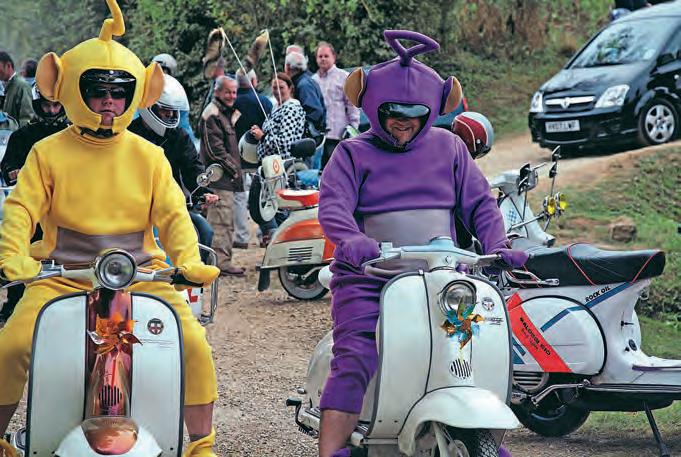

I
eventually stumbled across Goblincore. Here people make themselves look like goblins and fairies, while surrounding themselves with mushrooms.
Is the subculture dead? Paul Green certainly fears that it’s on life support.
Picture credit: Mau Anything goes?
WWW.scootering.COM |
1) Brakes
Auto scooters
Front and rear brake check:
Apply four fingers and squeeze the lever, push the scooter lightly forwards. As you apply pressure to the lever, you should soon feel resistance. Do this on each brake individually.
Geared scooters
Front: Apply four fingers and squeeze the lever, push the scooter lightly forwards and continue to apply pressure to the lever, until you lightly feel resistance.
Rear: Apply foot pedal, push the scooter lightly forwards, apply pressure to the pedal until you feel resistance.
Safety First
In the first of a new series, scooter racing champ
Tom Shaw shares a selection of key safety tips to help you get the best out of your riding experience.
C urrent BSSO Group 4 Champion Tom Shaw is part of the A1 Bike Training family in Doncaster.
During a chat with Tom, we came round to the subject of how many people were new to scootering and to safety aspects surrounding their purchase.
We wondered about just how often we jump on our scoot and zip off? More importantly, how often do we all ignore the basics – and do many riders even know what the basics are?

Over the next few issues Tom will help
you get the most out of your scooter by sharing his experience, covering both advanced and safe riding techniques.
Before getting out on the road it’s important to make sure that your scooter’s in peak condition so we start with the basics: daily, weekly and monthly checks.
After all, if you’ve forgotten to fill up with fuel, you won’t be going far...
So here we go – Tips with Tom, Episode One…

Words: Tom Shaw, Paul Shaw, Rik
Images: Andy Lynch
2) Electrics check
Turn the ignition on (for some scooters, the engine will need to be running in order to fulfil the checks described below).
Lights
Headlight: Check the dip and main beam. When on main beam, check that the dashboard main beam light indicator shows. You can use a hand in front of the headlight when moving from dip to main beam to see it change.
Rear light and brake light
Rear light: Use a hand to see the light’s reflection on the hand. Apply rear brake and use the same technique to check that is also working.
Indicators
Turn on left side – check dashboard indicators light works. Then check front and rear indicator lights are working. Then check the right hand side utilising the same procedure.
Horn
Press horn switch.
Emergency cut-off switch (kill switch)
Start engine, then operate switch to stop engine.
3) Steering
Put the scooter on its main stand. Push on the rear of seat to lift the front wheel off the floor.
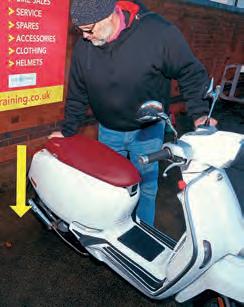
Turn steering left to right or right to left; you are feeling for any stiffness or whether notching maintenance and replacement are necessary before any more riding. Also check for any cables catching. Put steering into middle position and turn slightly either way, feeling for tightness and notches. If movement is smooth this indicates it’s okay in general.
4) Tyres
Gently kick the tyre in middle of the tread; the amount of ‘give’ will indicate the amount (if any) of deflation.
5) Petrol
Check your fuel gauge: If you’re scooter doesn’t have a fuel gauge, simply open the fuel cap and have a look in. Check the fuel tap: (if fitted) check that you’re on the main feed. When the scooter runs out on main feed, always pull up, stop and change on to reserve. Once you have refilled your scooter, make sure to put tap back to main feed.
6) Suspension
Front: Take scooter off stand, wheel forward and apply front brake. You should feel the scooter’s front end compress and return.
Rear: Press down on rear of the seat to compress suspension and then relax pressure. The scooter should return to its original position.

DAILY CHECKS
Brake
check. Check for play in the steering.
Suspension
check. | SCOOTERING | FEBRUARY
WEEKLY AND MONTHLY CHECKS
As daily checks plus:
1) Brakes Auto scooters
Front and rear brake: Check sight glass on master cylinders, (situated on handlebars). On some scooters you have to turn handlebars to get fluid level in sight glass. On the sight glass there will be a ‘minimum’ indication line; when the fluid gets down to that level the brake pads will probably be ready for replacing. You can visually check your brake pads on front and rear calipers. Check your brake hose lines for any damage.
Geared scooters
Front hydraulic: As auto scooter
Rear: Apply foot pedal until you feel resistance. Check the amount of travel before the brake applies pressure to the brake shoes.

Drum brakes can be adjusted by the cable adjuster, check your scooter’s specific manual for proper adjustment technique.
2) Tyres
General: Check the tyre wall for damage or cracking. Check tyre pressure and inflate if required, your owner’s manual will list the correct tyre pressure.
Check tyre pressures: Visually check tyre tread, the minimum tread depth for motorcycles over 50cc is 1mm across ¾ of the width of the tread pattern and with visible tread on the remaining ¼. For motorcycles up to 50cc the law requires that all the grooves of the original tread pattern must be
clearly visible. On the side of the tyre you will have a TWI (tread wear indicator marker). Follow triangle point over tread of tyre and you will see ‘bars’ in the tread; when these are level with the tyre surface 70% of the tyre depth has been used and the tyre needs replacing.

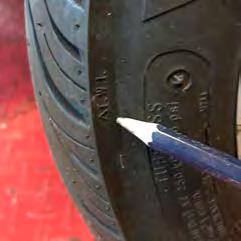
3) Oil
Check your oil level. This should be done with a cold engine on a level surface with the scooter on its main stand.
Autos: Remove the dipstick, wipe, insert but do not tighten, pull out and check the level

This wants to be halfway up the diamond or hatched area on dipstick or between ‘lower’ and ‘upper’ marks. Note! Check your owner’s manual in case dipstick has to be screwed down for checking level.
Geared scooters: There’s no real alternative than to undo the filler screw and top up with a little of the correct grade oil. Once the surplus has stopped flowing the level’s correct.

4) Suspension
Front: Take scooter off stand, wheel forward and apply front brake, you will feel scooter front end compress and return. Carry out visual check of front forks, check for any oil leakage. If leaking renew.
Rear: Press down on rear of seat to compress suspension, then relax pressure and the scooter will return to its original position. Visually check the spring for any leakage. If leaking renew.
Let’s say you have left your scooter for a while out of your sight. When you walk back to it, check carefully underneath it for any leaks (traditionally these would show on the floor below the scooter). Have a quick walk around your scooter and check for any damage, prior to riding off. Scooters have often been knocked over, put back on their stand and left without anyone being informed. Unnoticed damage could have a negative effect on safety and trying to prove where the damage occurred after leaving the scene is far more difficult.

It has to be done...
Check your scooter after it’s been parked
Check brake fluid level.
Tread wear indicator.
Check oil level: autos have a dipstick, filler plugs need removing on classic two-strokes.
WWW.SCOOTERING.COM |
Apehanger interest
I’m intrigued by the Lambretta with the ‘apehanger’ handlebars, which appeared on page 121 in Classic Scooterist, January edition and I'd like to ask if there are any other pictures?
Uncle Chufty
[The picture appeared as part of our ‘Living the Scooter Lifestyle’ article and the images used were sent in by Mick Panter. We contacted him to see if he had any more information and here is his reply]:
“The Lambretta in question was a Steve Stringer Special. Steve always had scooters and was into coachworks etc. He turned his

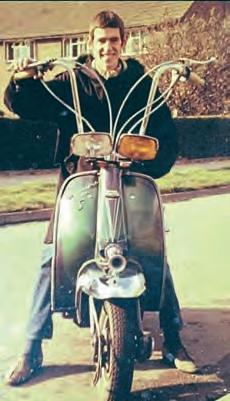


attention to converting and tricking up vans, etc., later on in his life. He now lives in the US and still rides a scooter.
“From memory, the scoot in the picture was purchased by my mate from a dealer. Not sure how that came about but my mate now rides a Vespa. Unfortunately, not long after these photos were taken, the scooter had to be changed back to standard as a busybody police constable decided that, in his opinion, it was not safe to use on public roads. The police constable took my mate to court and the magistrate backed him (surprise, surprise – but it was the 1960s) even though the scooter had a full MoT, and its build was not a concern to the MoT tester.
“I believe that today, that police constable would have to provide much more evidence of the scoot being unstable or unsafe.”
Mick Panter
WHEN I’M DEAD AND GONE…
My age group were born in the best years; all wars had finished and life was getting better; there was plenty of work, which gave us money in our pockets. Things started to change in our youth period as teenagers started to move away from our parents’ era. Teddy Boys, (Tonup) Rockers – our parents didn’t like them one bit and these cultures were just the start. The 1960s came and lifestyles changed with it; our parents were pulling their hair out! Boys in pink were a ‘no go’ – they thought pink was for girls and blue was for the boys – remember?
In this era Mods were born and things livened up. While bikers stayed in the dinosaur age, our cult grew and grew during that period. We were clean, tidy and were always in employment throughout the era. Scooters – Lambrettas and Vespas – were a means of transport for us (the better scooter we got, the better the girls). Even on an old rust bucket you could pull even a Rocker bird – that was easy (know what I mean, ha, ha, ha)! These were great years.
But time moved on – the 1970s came and Skinheads became the next youth movement; occasionally more violent, but still neat and tidy with very short hair (ideal for scooter riders as no combs were needed in the latter part of the decade). Then the NF, BNP , etc., came on the scene; that was not for us; we loved Blue Beat, Ska and still Motown.
In the 1980s, it all changed again with Scooter Boys, Mod/Skinhead-cross scooter riders. There was more infighting between the different factions and that was a sign of the times.
The 1990s came – enough said. I bought a Series 3 Li125 and got back into riding during the latter part of the decade. For years I did some TV work, voiceovers, etc.; then after going back to work in Carnaby Street for Merc, The Face and Sherrys, my life was turned around. I parked my Lambretta inside the shop, complete with lights, mirrors, etc. and went back to wearing my original parka. There were good times and I
made a few extra bob doing a promotion for Wham!, Gallagher (Pretty Green), plus a TV programme for Inside Out (the location was on Brighton Beach appearing with the copper who nicked me back in 1964 – brilliant)!
I now live on the Isle of Wight and have attended all the scooter rallies to date. But I’m now approaching my mid-70s and my riding days are now finished; I do have a Freedom bus pass, but leave the riding to the youngsters – as should other (no names) old gits on scooters trying to relive their youth –‘Airfix Mods’ on plastic scooters are not my scene, sorry. We were history in the making – never to be repeated.
‘Jurassic Mod’ Steve The old recycled Skinhead
✎ Classic Scooterist, PO Box 99, Horncastle, Lincs LN9 6LZ ✉ mauspencer@classicscooterist.com ☎ 01507 529408
109MAUSPENCER@CLASSICSCOOTERIST.COM
When I first became involved in the world of scooters I thought it was something that only happened in the UK. As time went by and I attended the early Euro Lambretta events I realised it was much bigger than I’d realised. Even then things seemed to centre around a relatively small number of European enthusiasts who’d turn up to participate. Friendships were made with owners from other countries, but it didn’t seem as though there was much else going on.
Of course there was no social media back then but Scootering magazine would showcase the occasional foreign owner or two, usually building a custom scooter or sending in pictures of their daily ride. There were reports of rallies from France and Germany, but they seemed nothing like the UK. Eventually advertisements from dealers in those countries started to appear and of course, social media started to help spread the word of the wider scooter scene out there. Even so, in the UK, we were still largely in the dark about what was happening elsewhere.
This wasn’t a case of being insular and trying to block out what was happening elsewhere, more of it didn’t seem as interesting or appealing. Perhaps this was also ignorance on my part; I was so used to what was happening on home soil that I didn’t have the motivation to look further afield. Then I started working for Scootering magazine and my outlook completely changed.
I must admit that the early days were difficult and searching for stories across Europe and further afield took me completely out of my comfort zone. But having written about a custom scooter in Australia and reported on engine tuning in Germany, it soon became clear that there was far more going on than I’d realised.

A truly international affair
The people interviewed told stories of their friends with scooters, clubs they were involved in or rallies they were attending. The events weren’t huge rallies like those in the UK or major European events, they were on a much smaller scale but still of great interest.
There is no doubt that it made me research what was going on and I moved from responding to what people were telling me about to actively searching out things for myself. Fairly quickly a new world of scootering that I never knew existed opened up before me.
Cutdown street racer in Australia –scootering is a worldwidephenomenon.
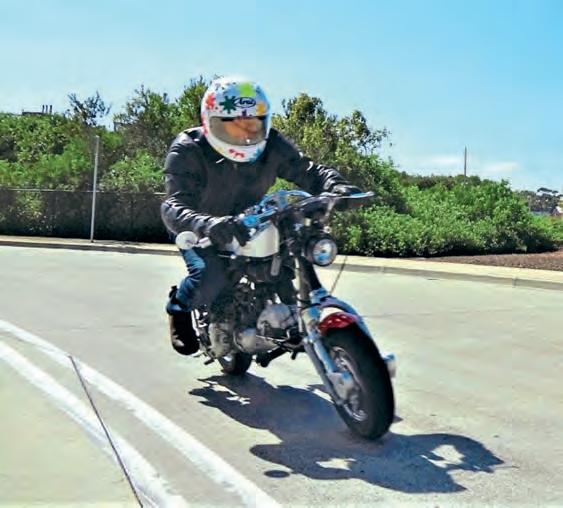
Of course, the fundamental thing was that this new world was still based around scooters and this is where it starts to get much more interesting. Owners in countries where the scene isn’t so big were bound to look at what happens in the UK and take inspiration from it but, as I discovered, rather than just copy what had gone before they put their own mark on it.
With new thinking and a different approach, often the results are outstanding, and make you realise how diverse scooter building can be. Speaking to the owners it also becomes apparent what a difficult thing it is to achieve.
In the UK we are spoilt for choice with plenty of painters, platers, engine builders and the engineering services required to carry out such work – but that’s not the case everywhere. In other countries the choice is quite often very limited and when someone with the necessary skills is finally found they may be a considerable distance away.
Slowly I began to realise the huge amount of dedication and effort required by owners. In some parts of the world simply getting a scooter painted to a good standard can be a major challenge.
When it comes to tuning, many of the Lambretta engines seem to be TS1 or RB-based and I think Ray Kemp is responsible for keeping most machines outside of the UK running. The Vespa, on the other hand, is dominated by the Europeans, certainly when it comes to the smallframe. They are the market leaders in terms of both manufacturing and tuning. This is one area where the UK has undeniably learned from other nations.
The policy of this magazine has always been to feature scooters, rallies and events that make up the whole scooter scene and that includes both the UK and abroad. Even so, it can’t cover everything, and while it’s easy to know what’s going on in our small island the world’s a big place.
My advice is, open your mind to what is going on around the world. You’ll be pleasantly surprised, maybe even inspired. Most importantly you’ll realise that scootering is a truly international affair.
I was so used to what was happening on home soil that I didn’t have the motivation to look further afield
British scooterists often regard the ‘scooter scene’ as a home-grown invention but there’s lots happening around the world
WWW.scootering.COM |





















 Michael and Nita Marriott, adventurers extraordinaire. BUYER’S GUIDE
Michael and Nita Marriott, adventurers extraordinaire. BUYER’S GUIDE

































 At the front the TVR radiator sits alongside the original stickers.
Thought lost forever, the complete engine was discovered close to Rollershop’s base.
On the bench: one of the engines ready to reveal its secrets.
At the front the TVR radiator sits alongside the original stickers.
Thought lost forever, the complete engine was discovered close to Rollershop’s base.
On the bench: one of the engines ready to reveal its secrets.










 Both stunningly restored.
Finished – and from the front, they ooze perfection.
Bruno Zirri on the left.
Bruno’s racing Vespas pictured in the mid 1980s. The one at the front would become the black one.
Both stunningly restored.
Finished – and from the front, they ooze perfection.
Bruno Zirri on the left.
Bruno’s racing Vespas pictured in the mid 1980s. The one at the front would become the black one.







































































































 DTC with a difference.
A whole new world for patch collectors.
Series 2 meets Italjet Formula 125.
DTC with a difference.
A whole new world for patch collectors.
Series 2 meets Italjet Formula 125.































































































































































































































 Castle Ride, Transylvania.
Castle Ride, Transylvania.







 Vespa Motorsport, San Diego.
Getting greasy.
Jen’s first ride.
Vespa Motorsport, San Diego.
Getting greasy.
Jen’s first ride.










 The Atlanta V may have been a lightweight, Marlene certainly wasn’t.
Joan Thorne, who won Queen of the Road and Miss Lambretta international titles in 1966.
The Atlanta V may have been a lightweight, Marlene certainly wasn’t.
Joan Thorne, who won Queen of the Road and Miss Lambretta international titles in 1966.




























 Helen and Tony with the scooter that started it all.
Helen and Tony with the scooter that started it all.



















 Words: Mau/Martin Hather
Images: Martin Hather
Words: Mau/Martin Hather
Images: Martin Hather




 Author: Vittorio Tessera
Publisher: Giorgio Nada Editore
Author: Vittorio Tessera
Publisher: Giorgio Nada Editore



































